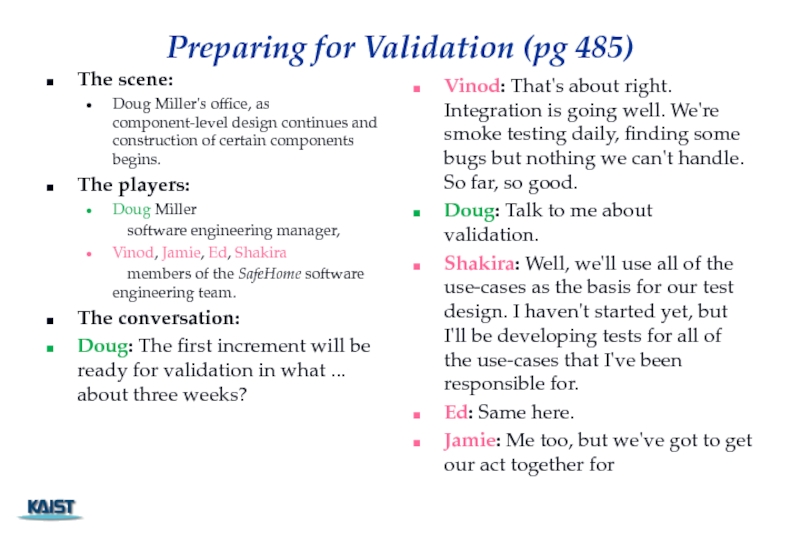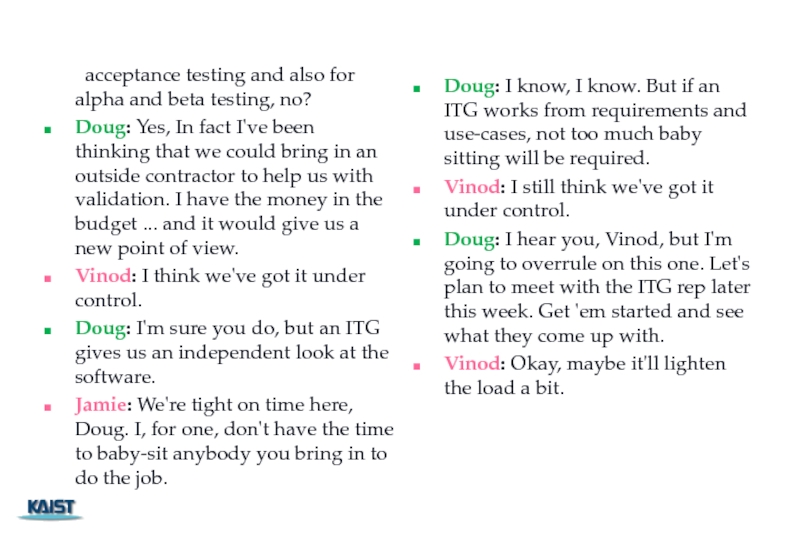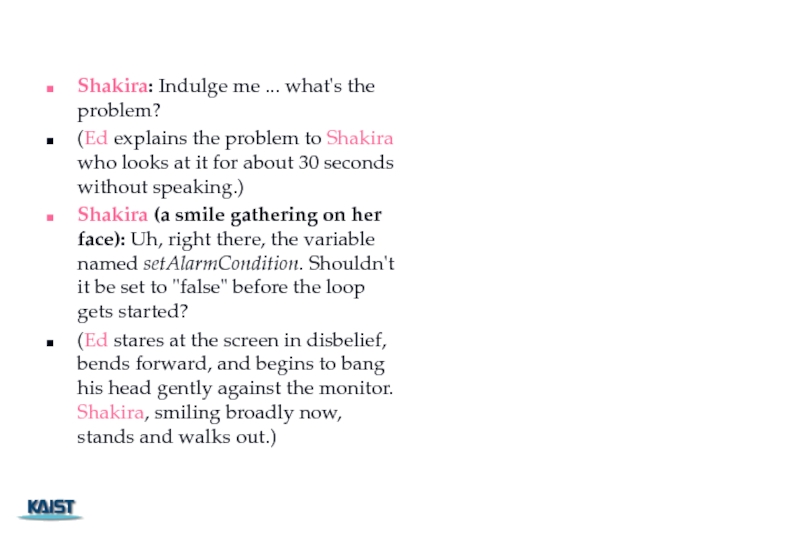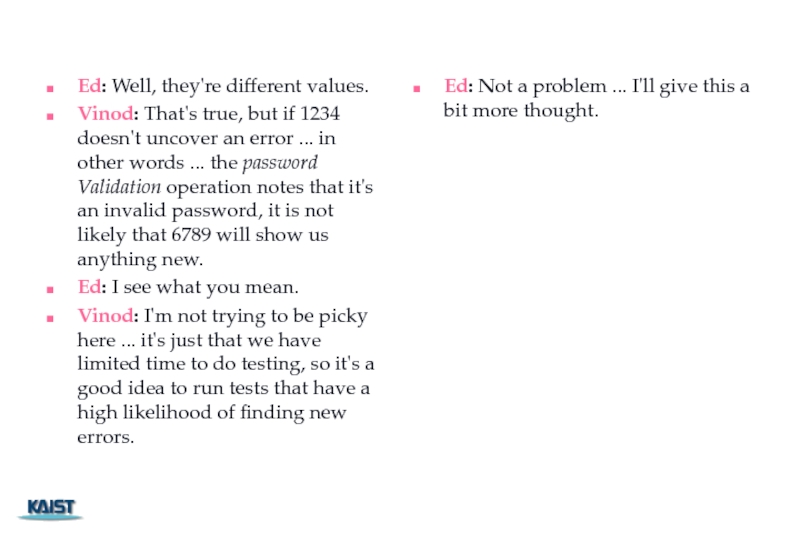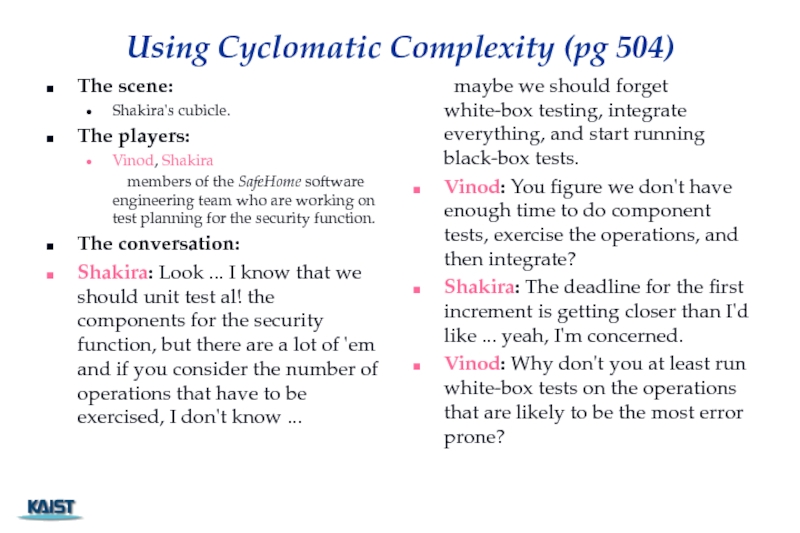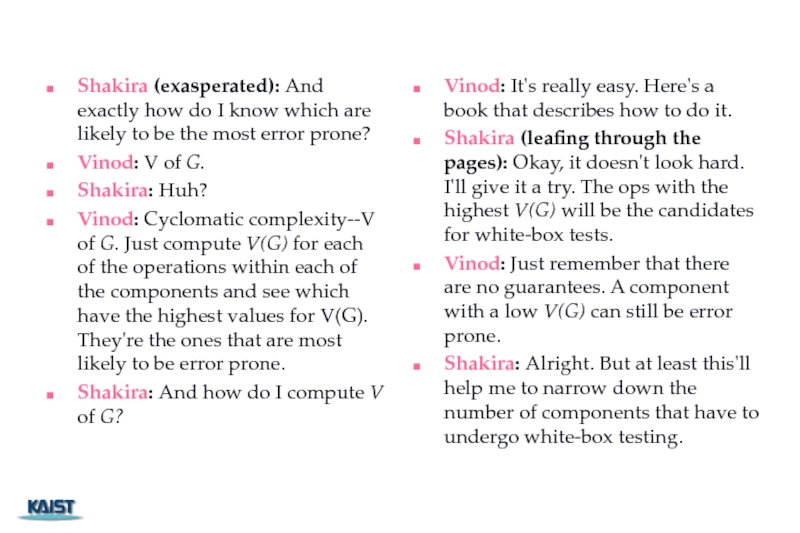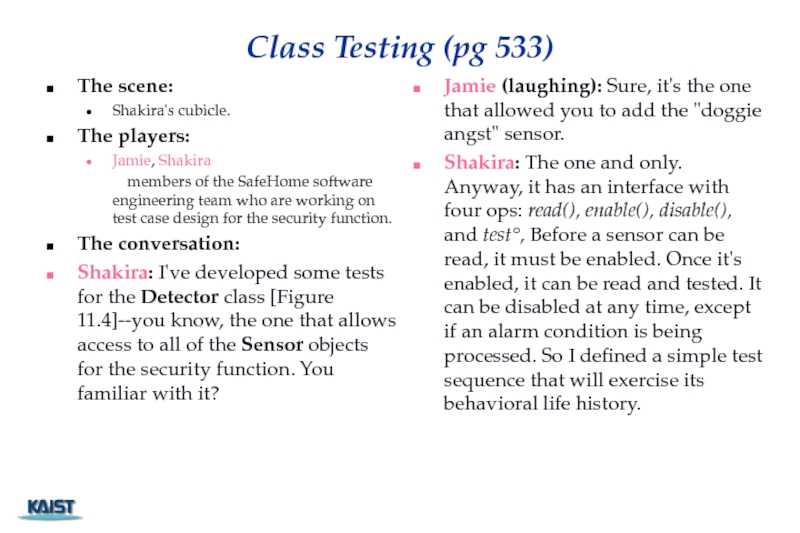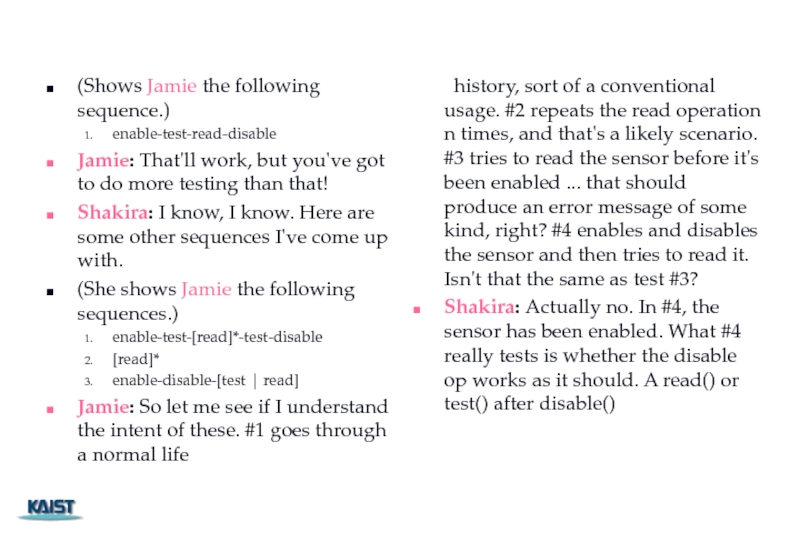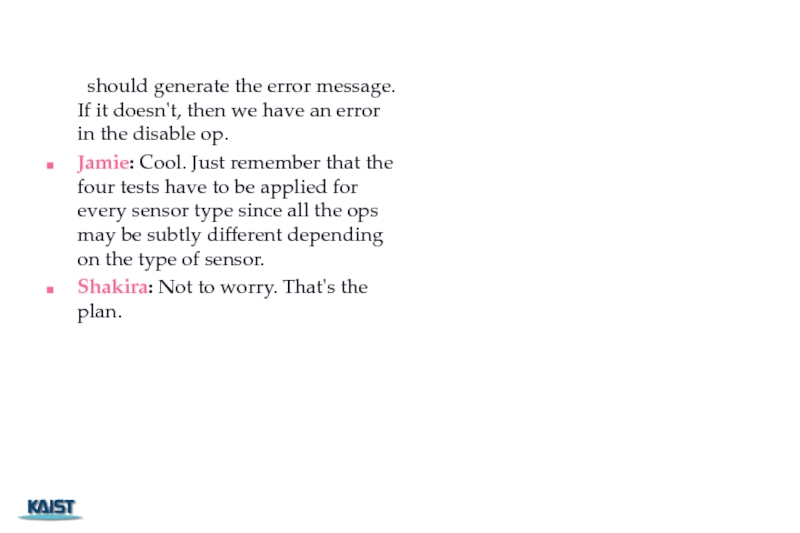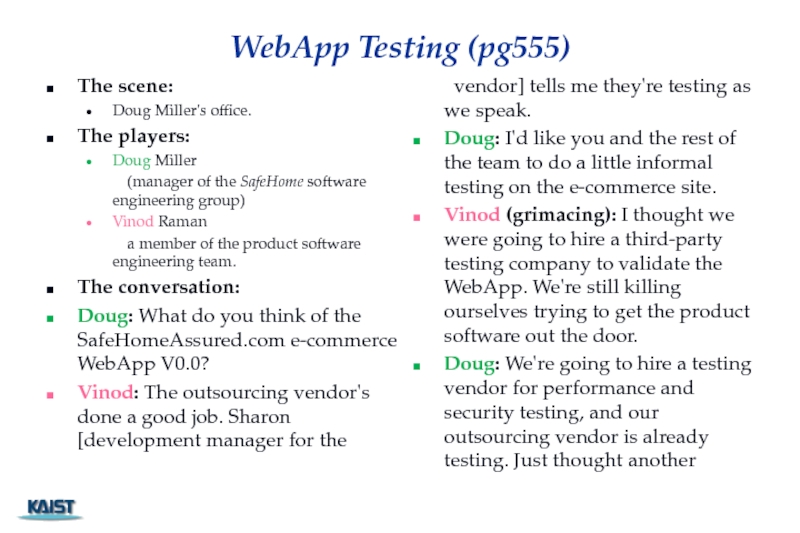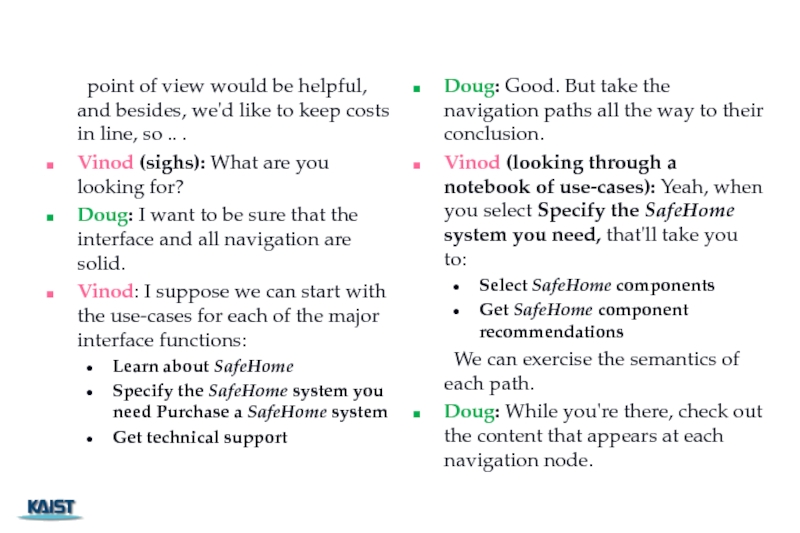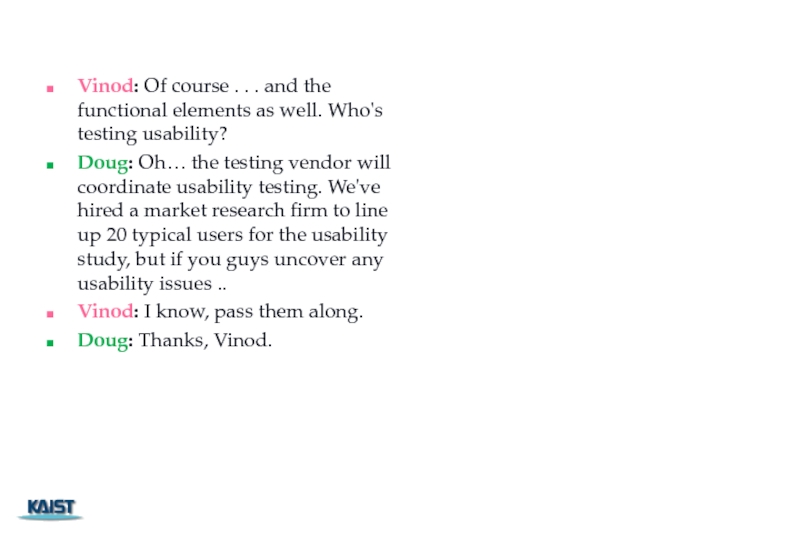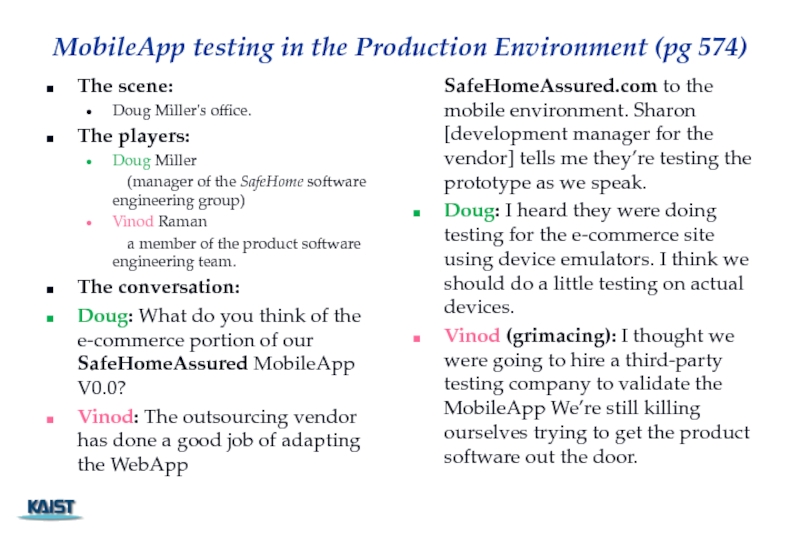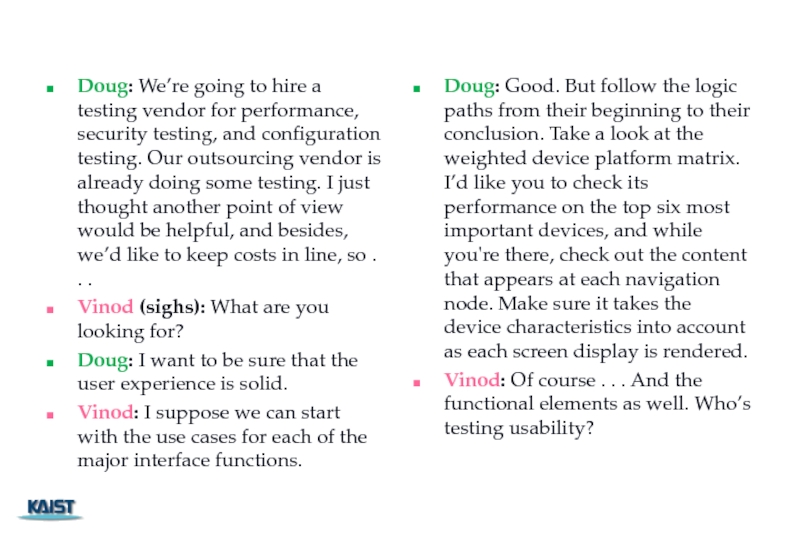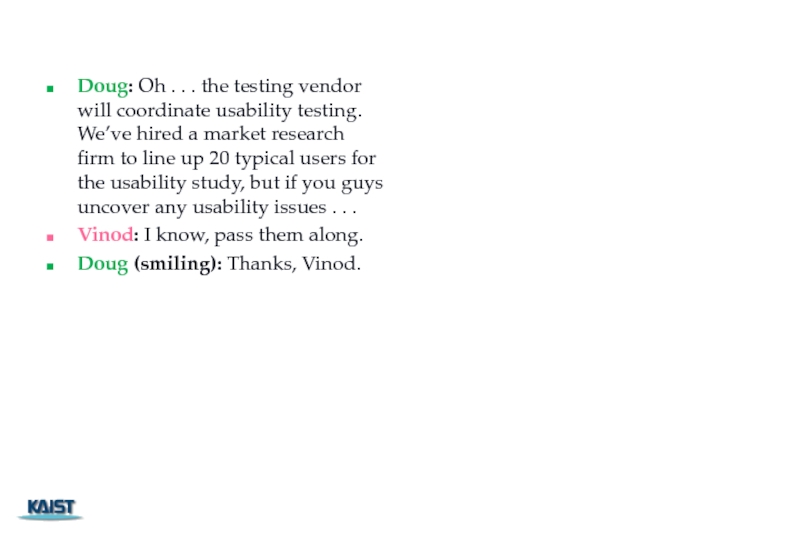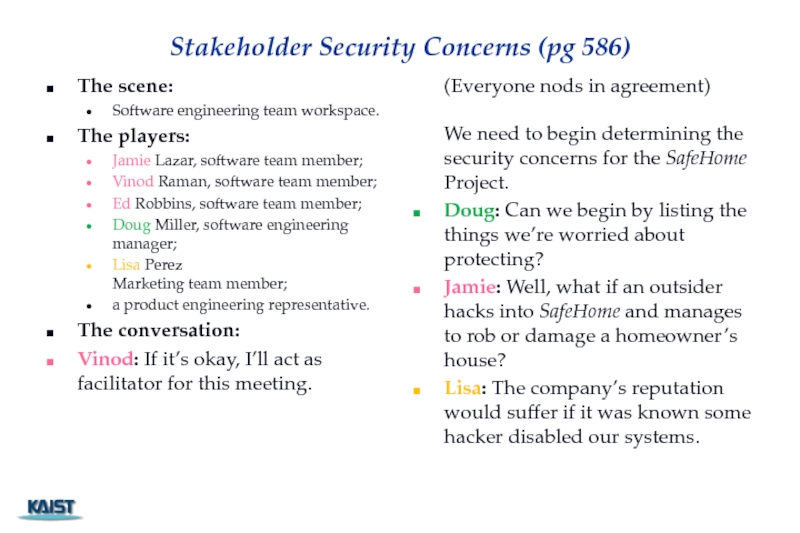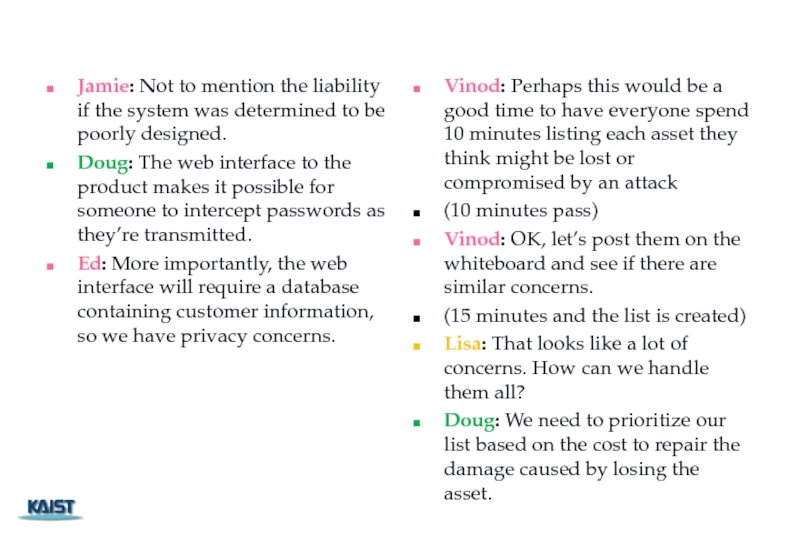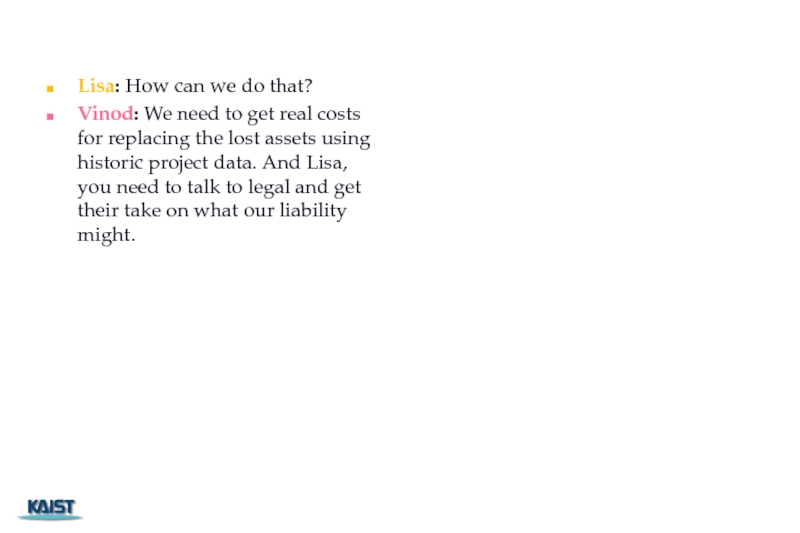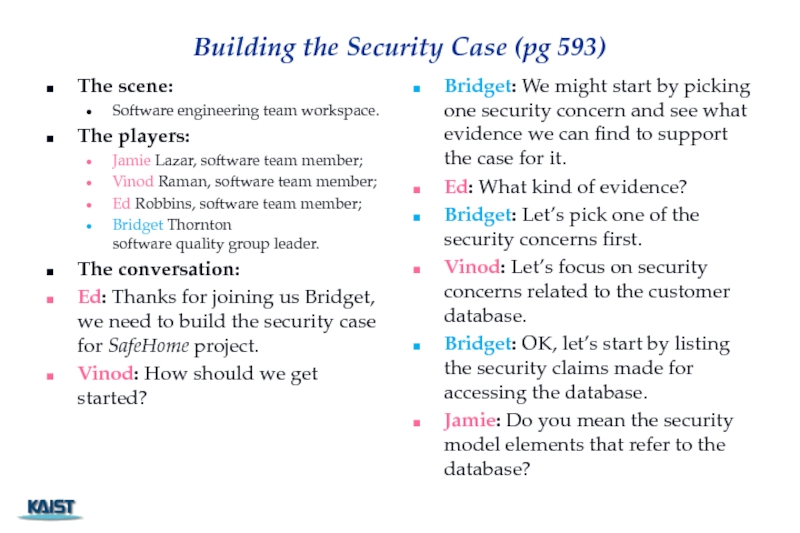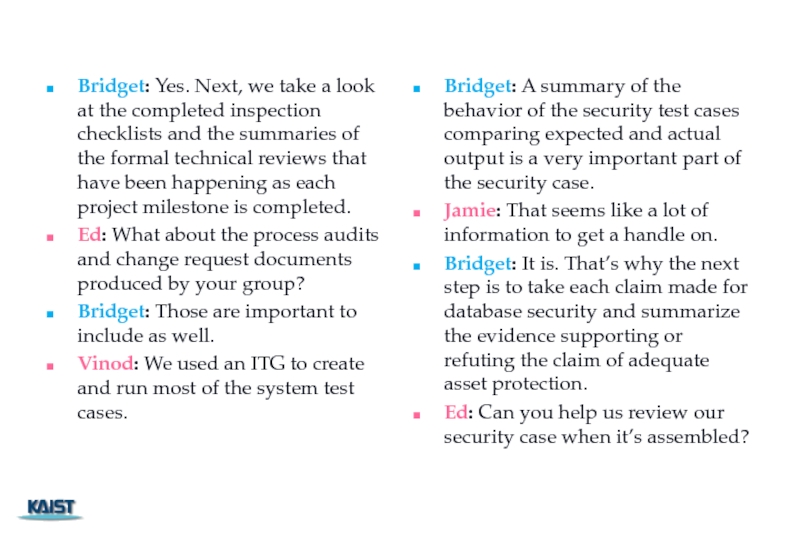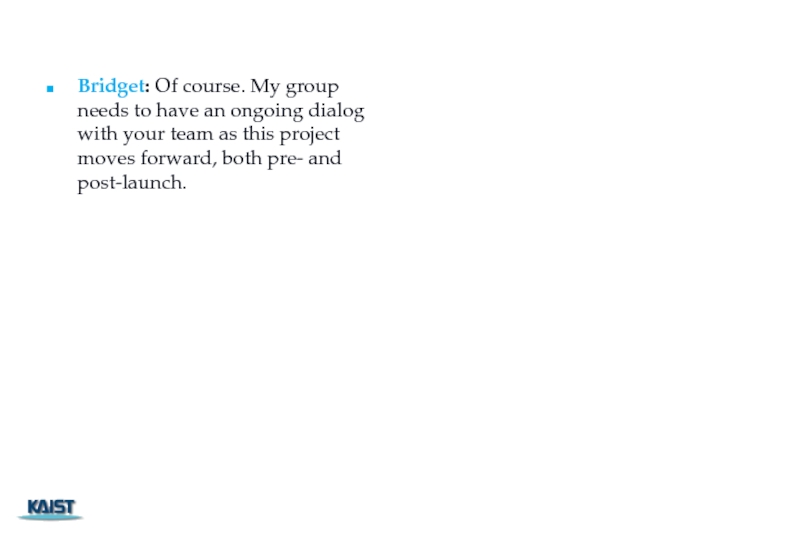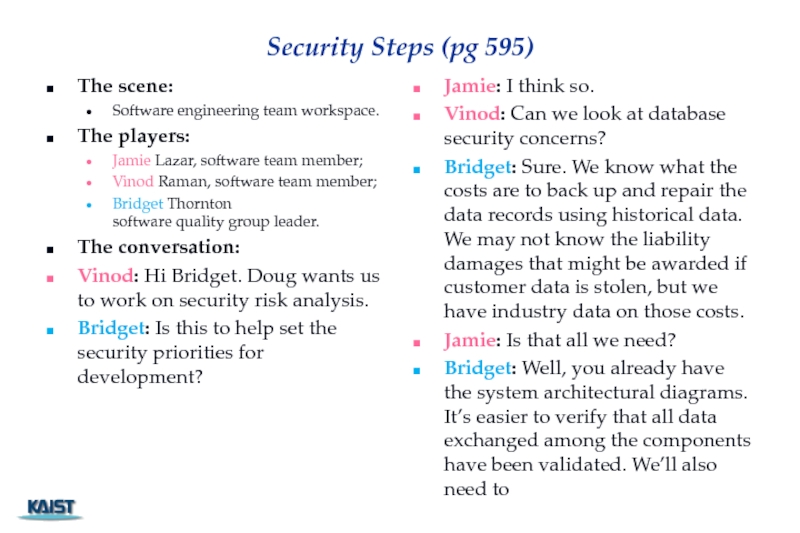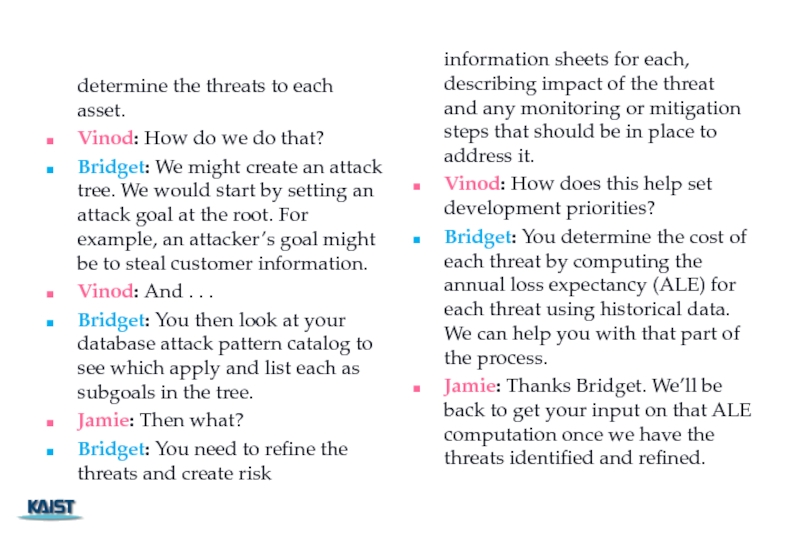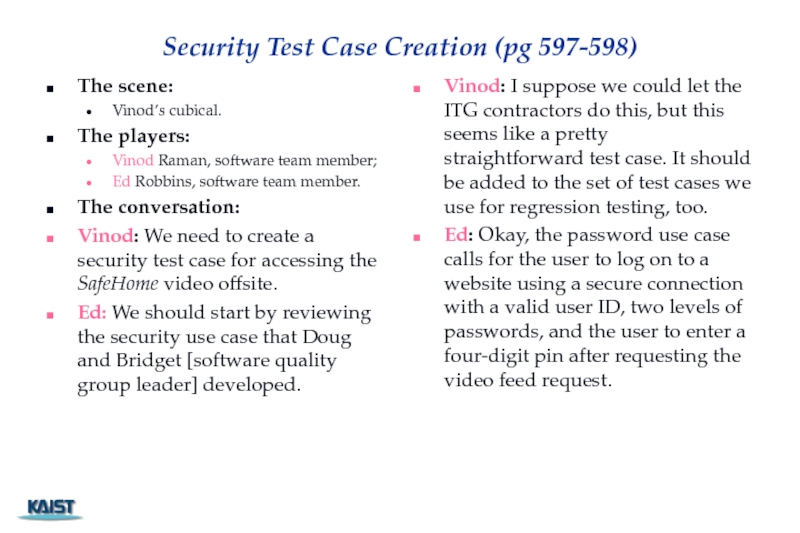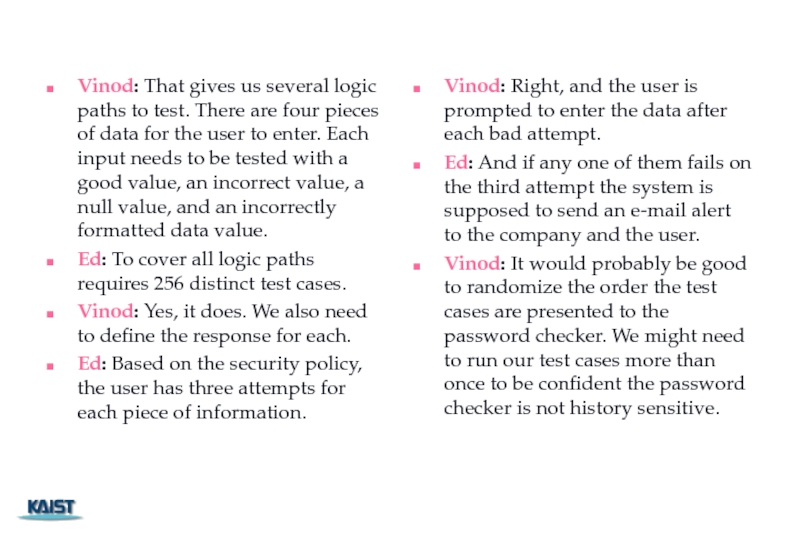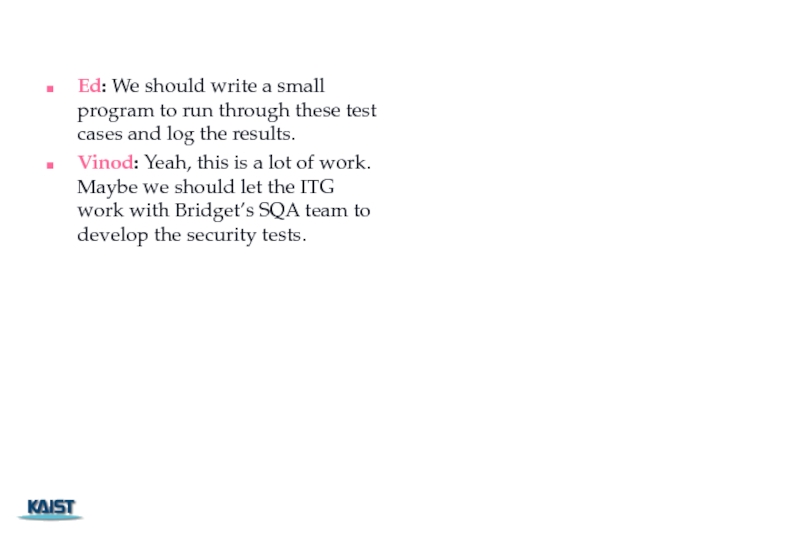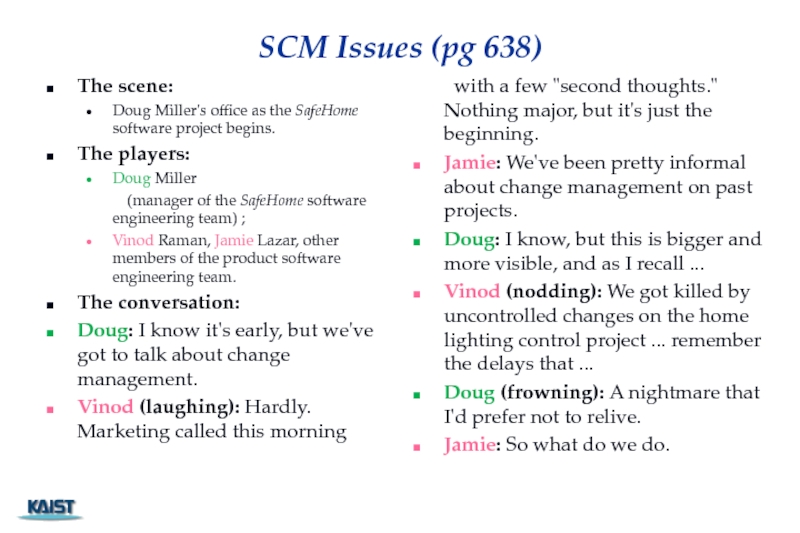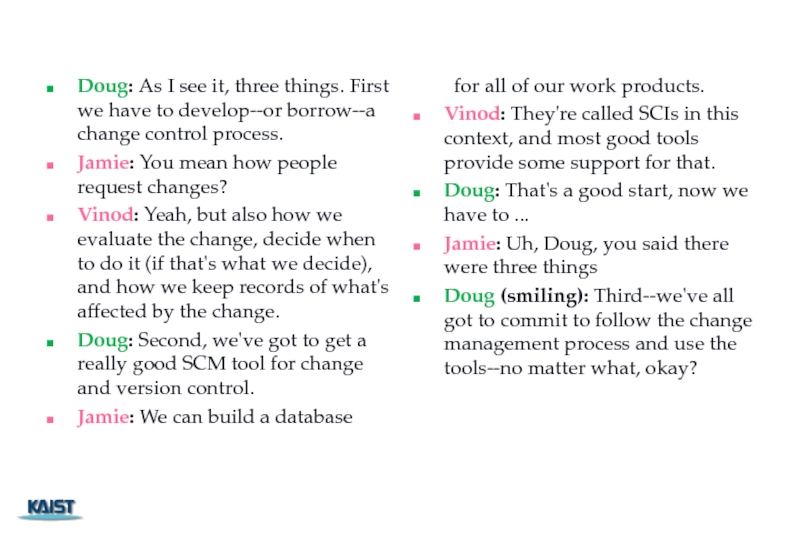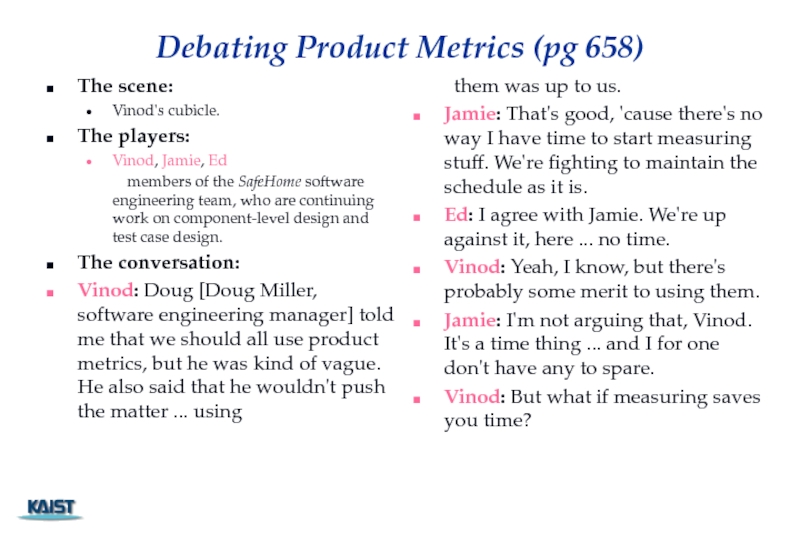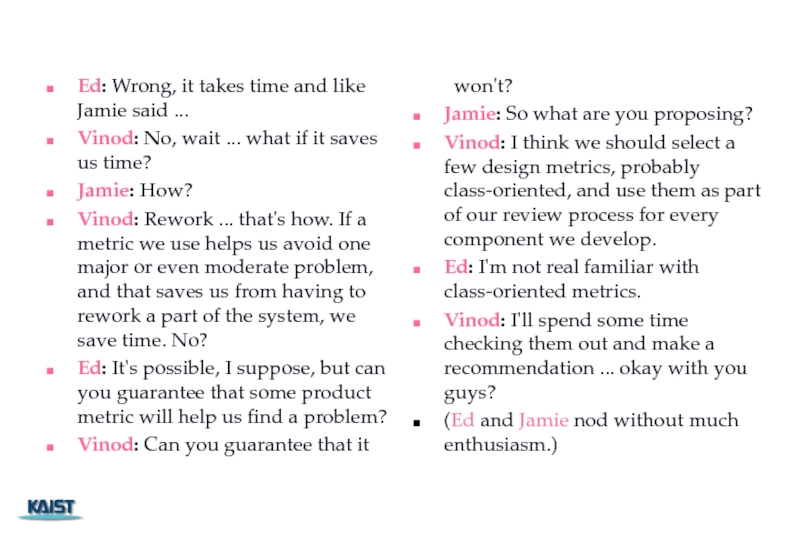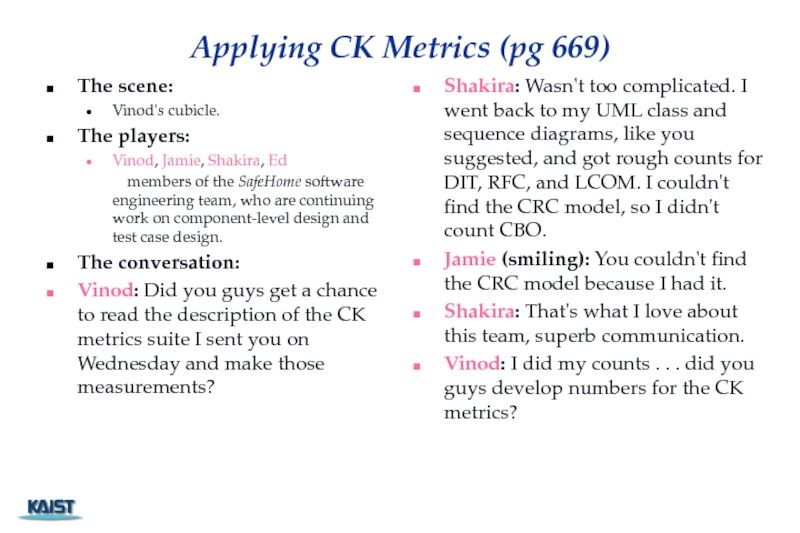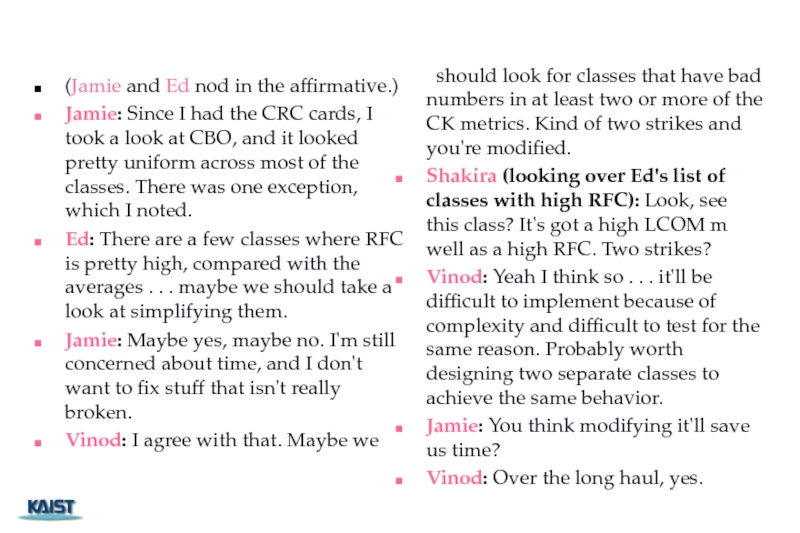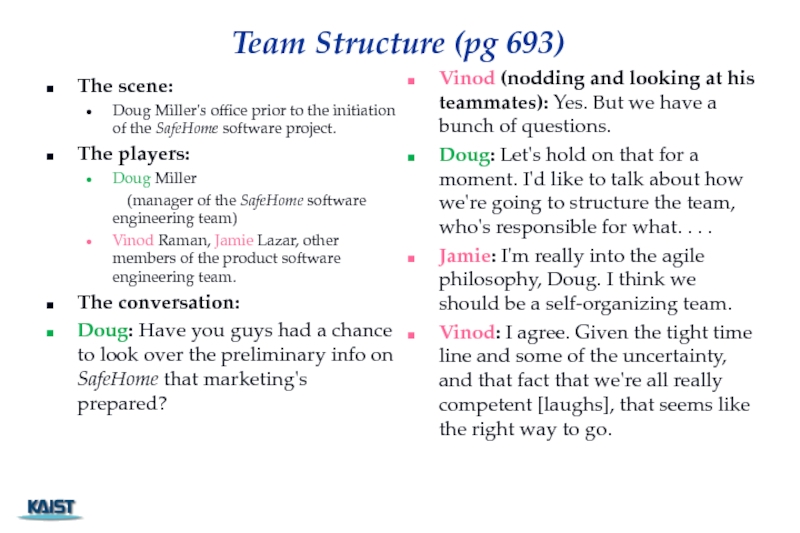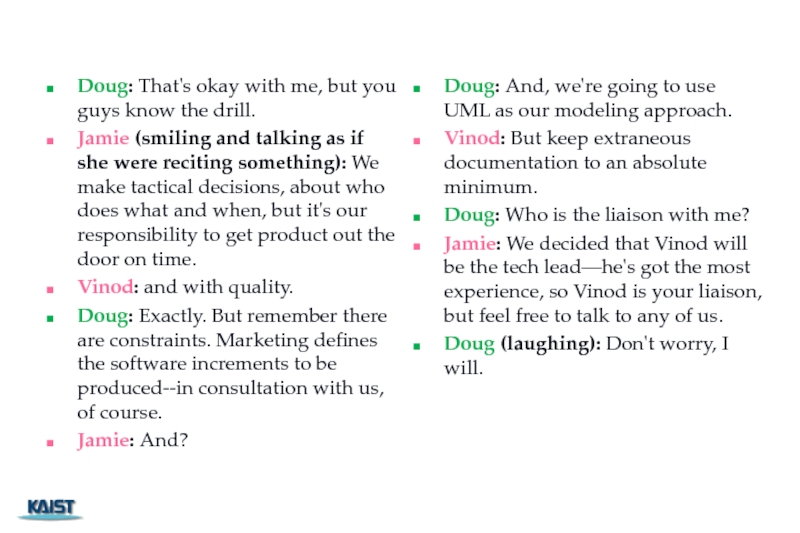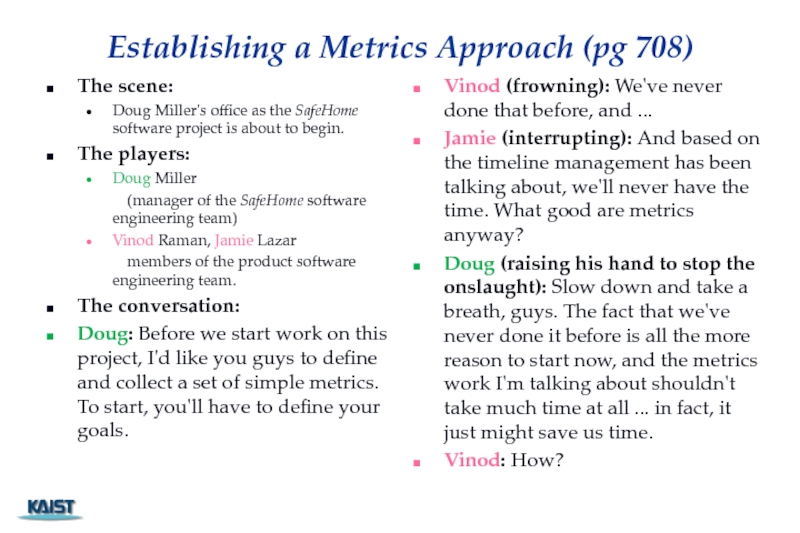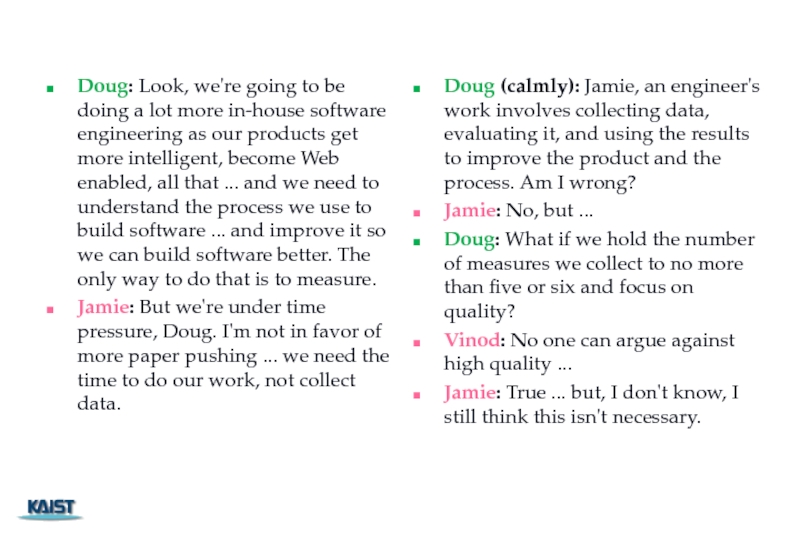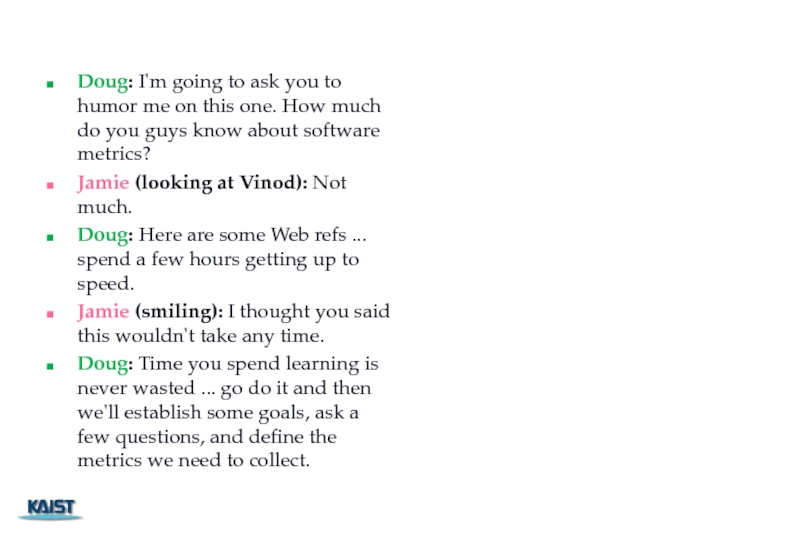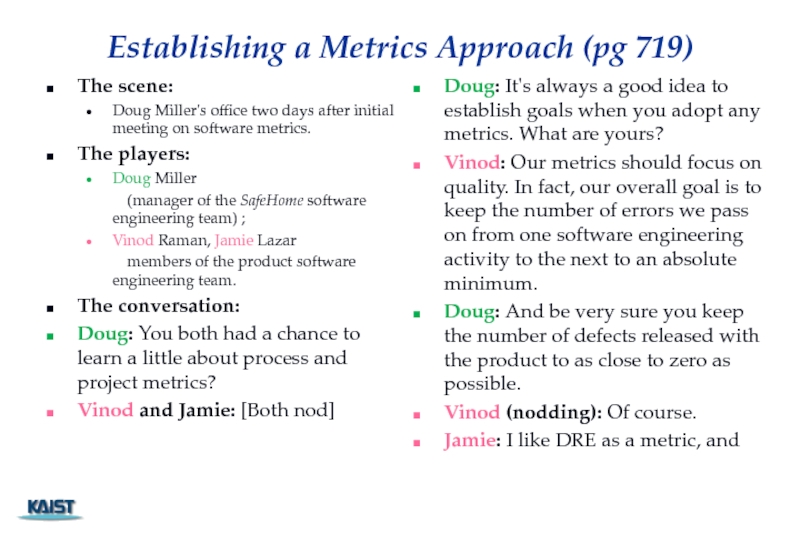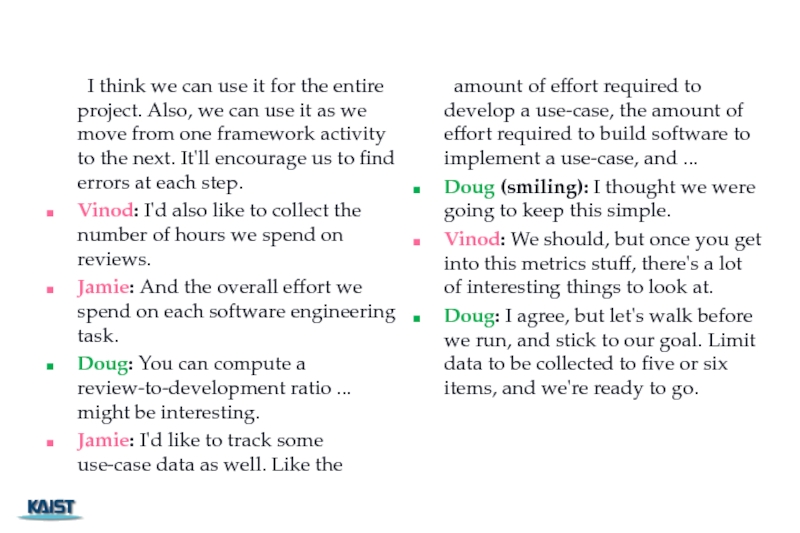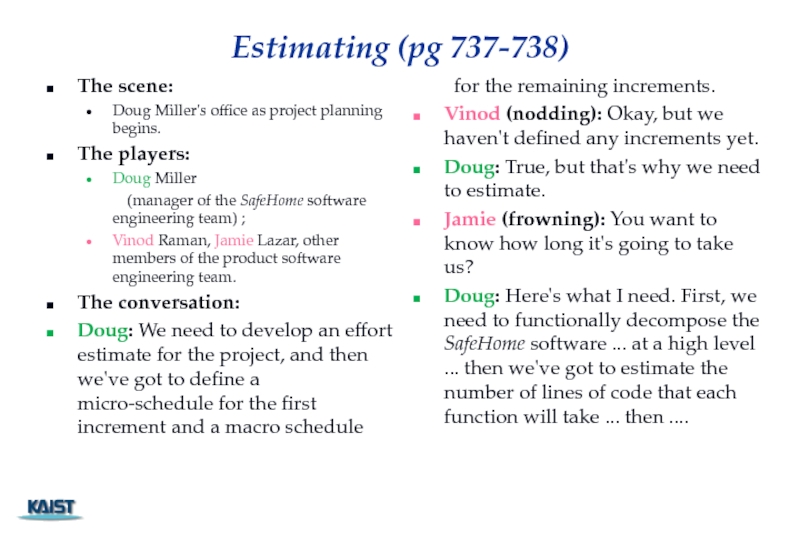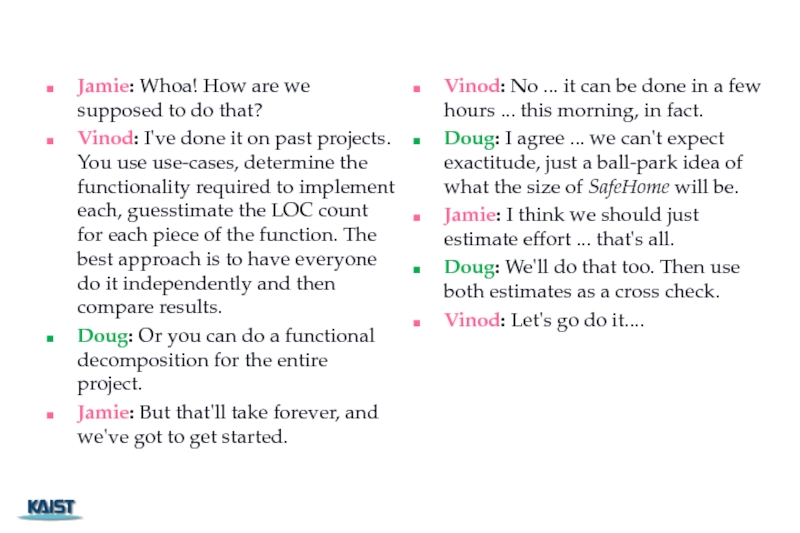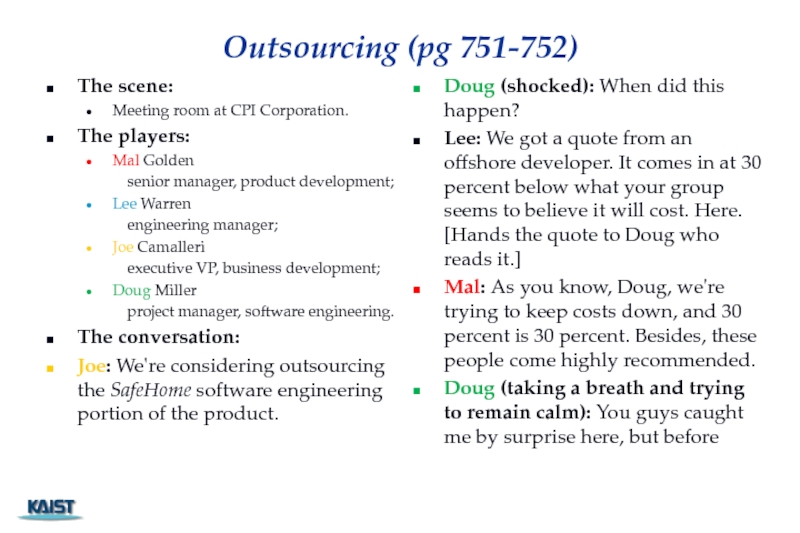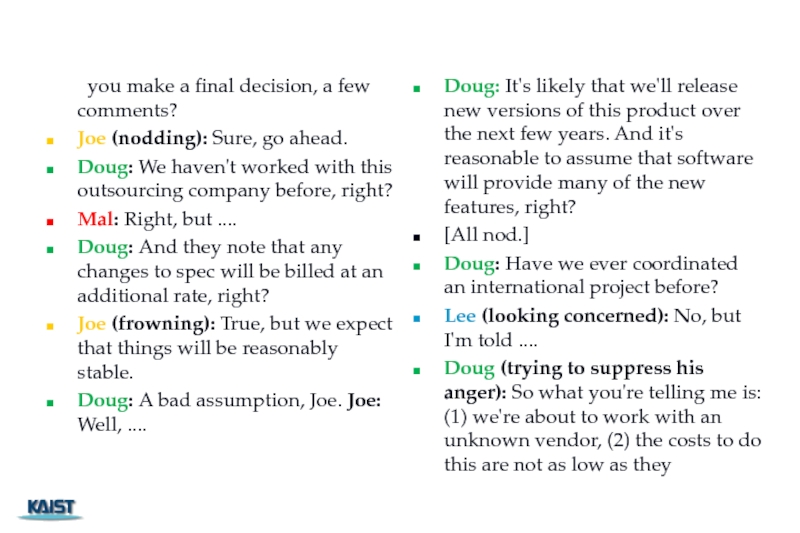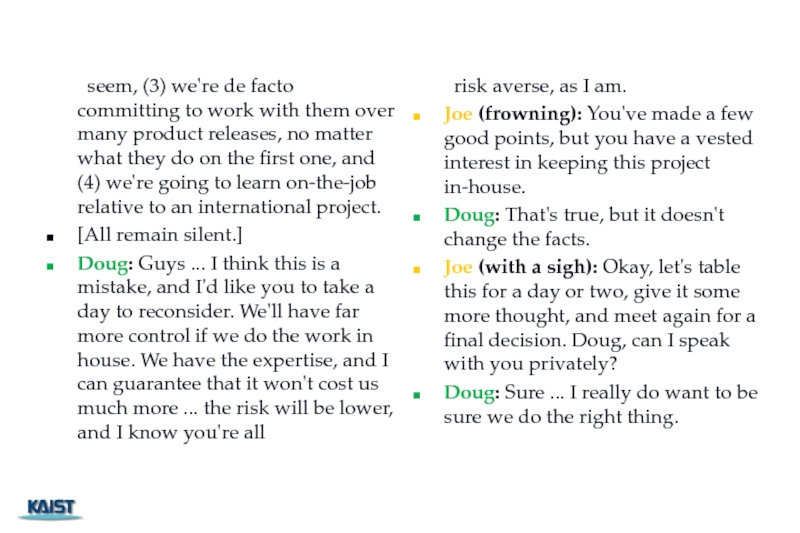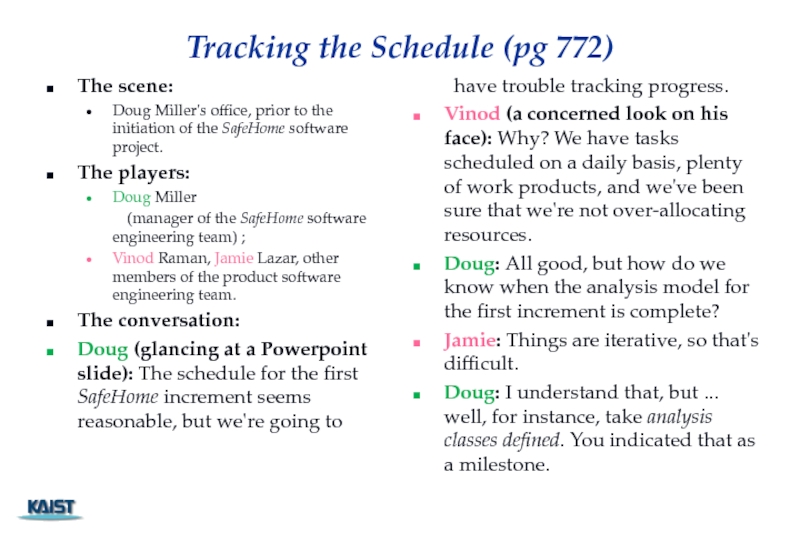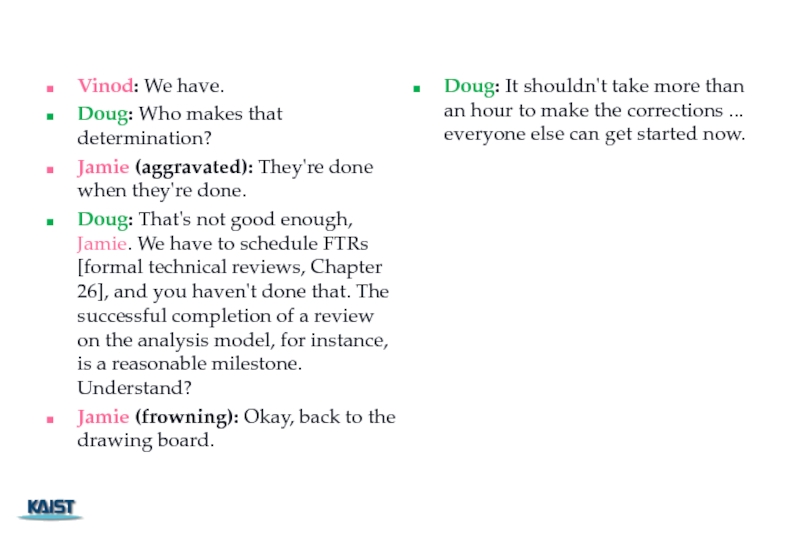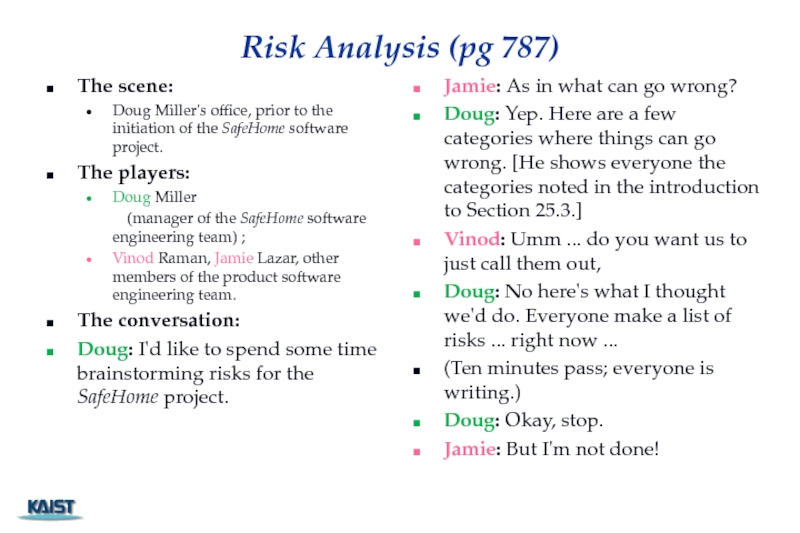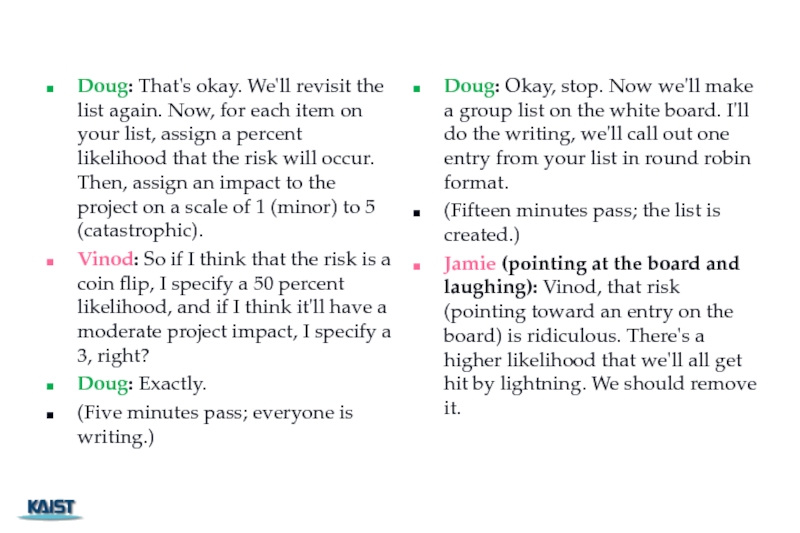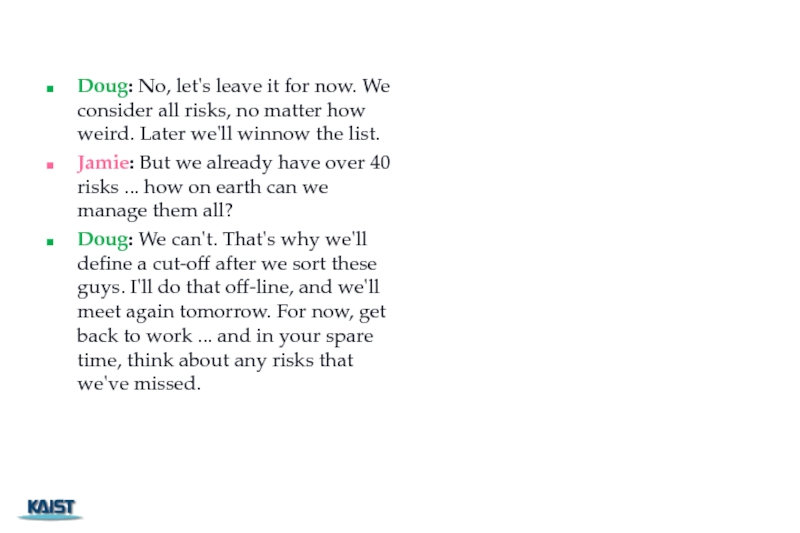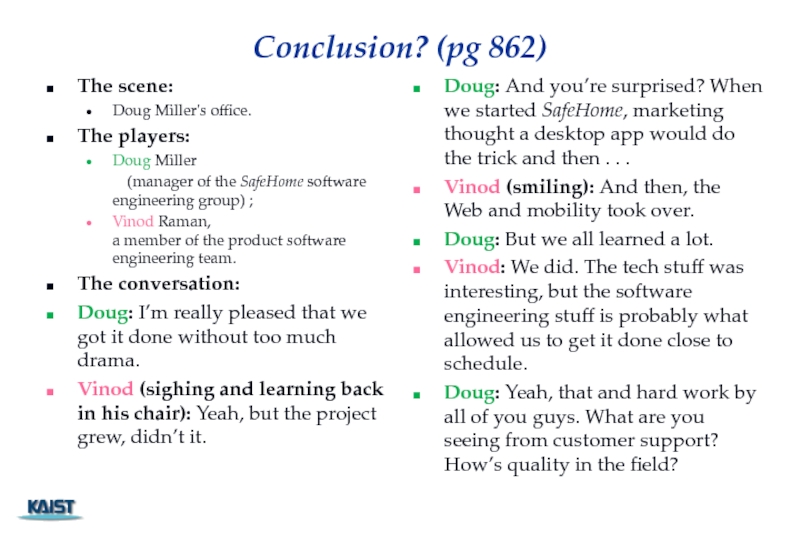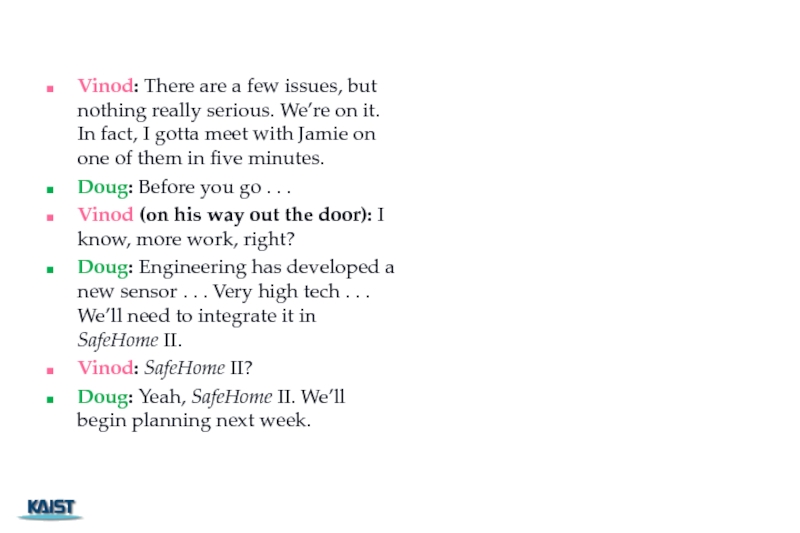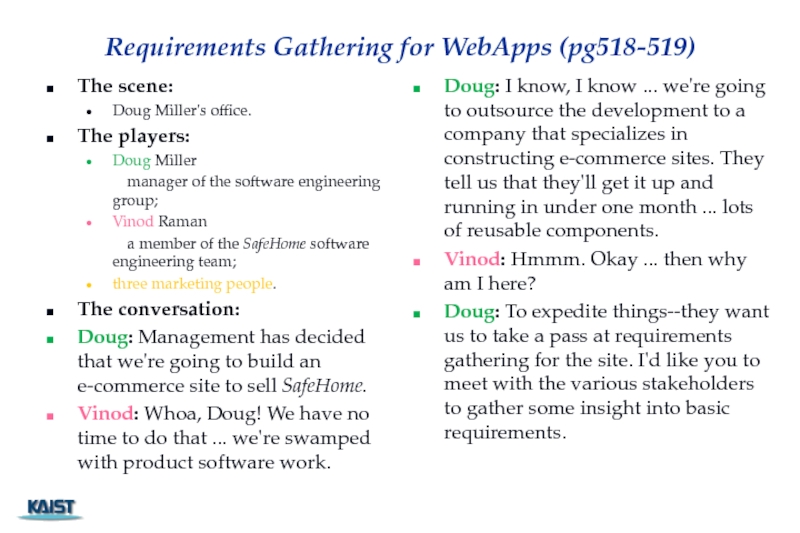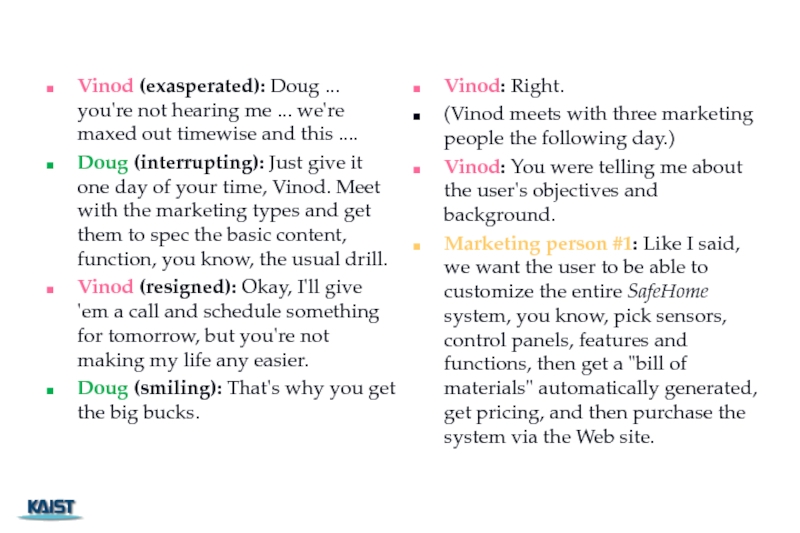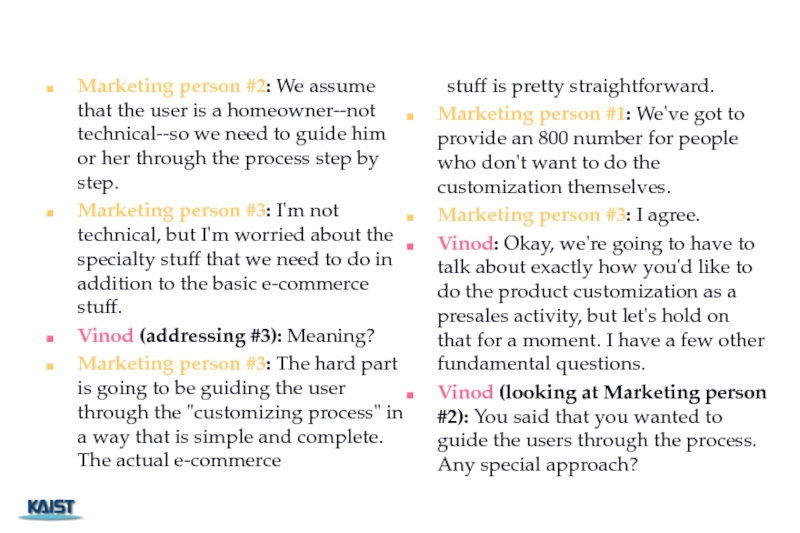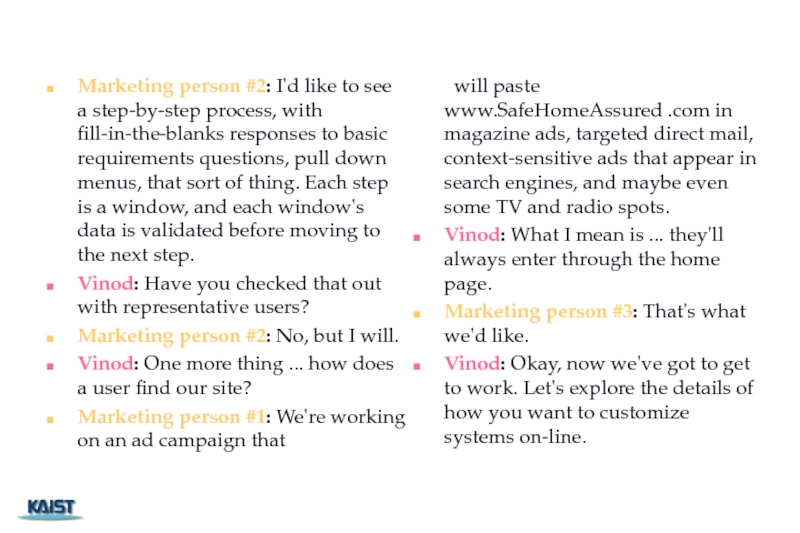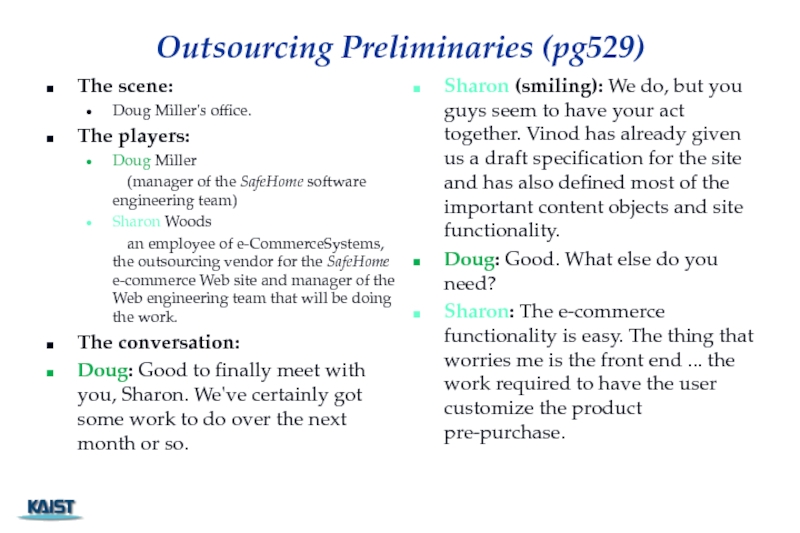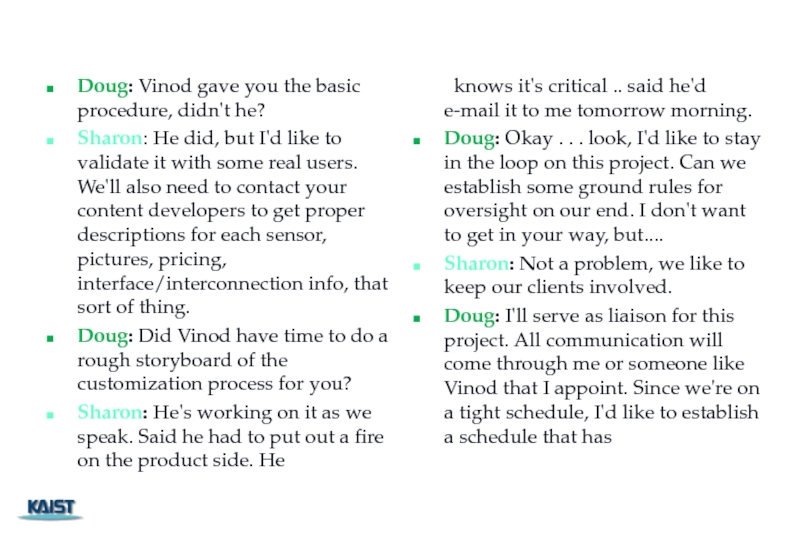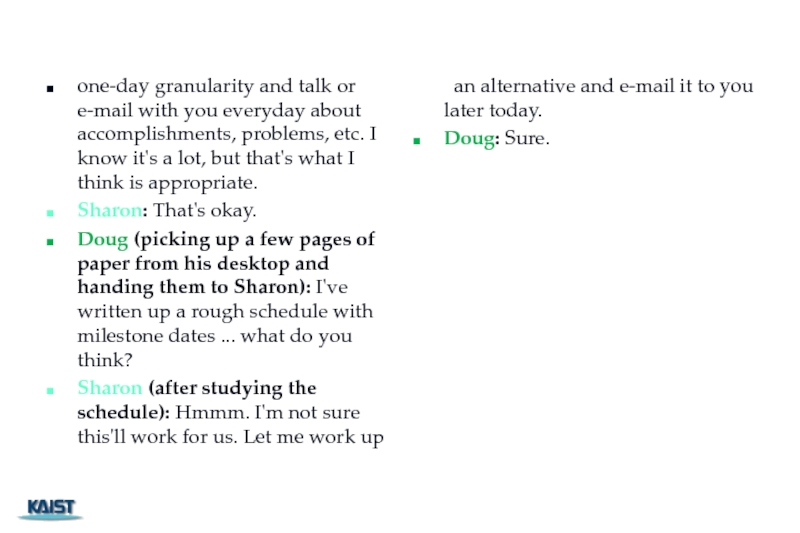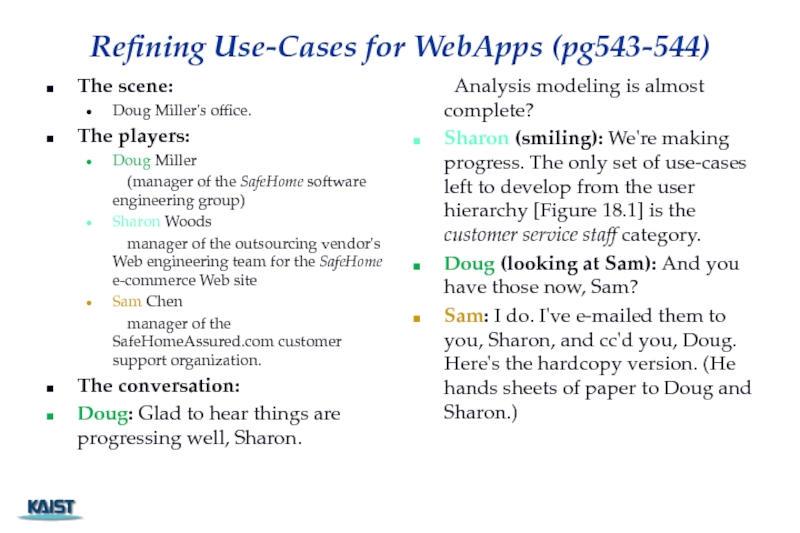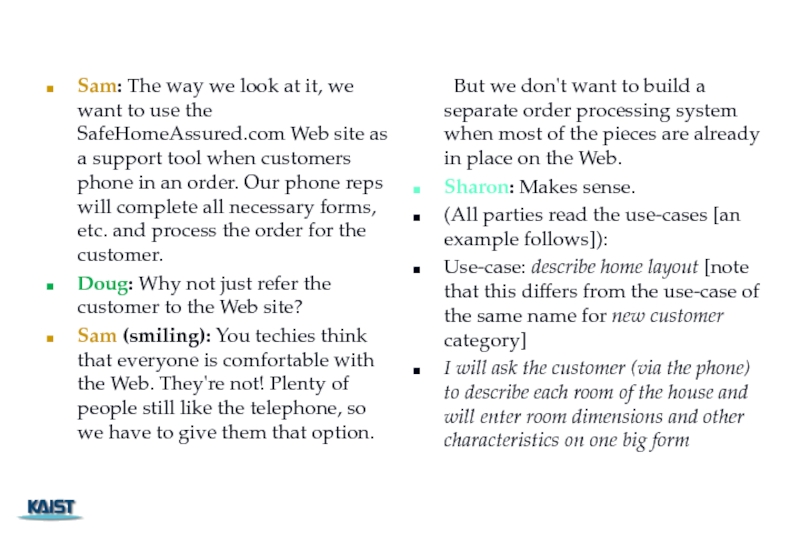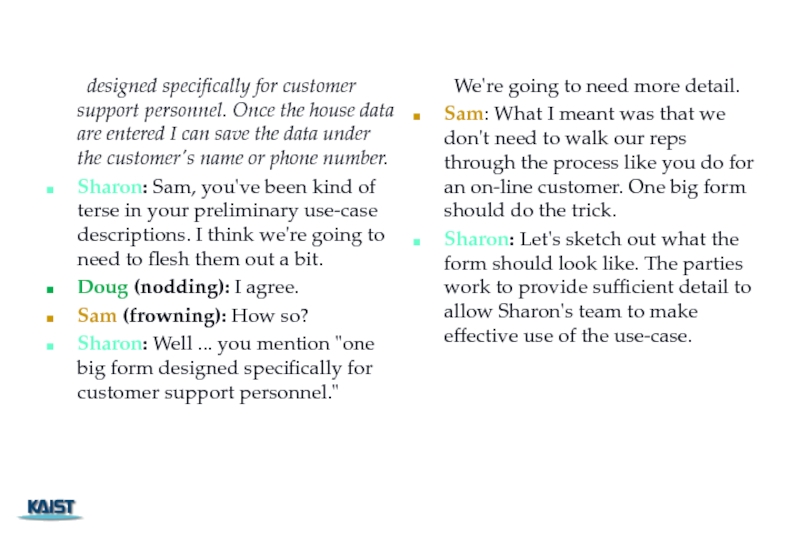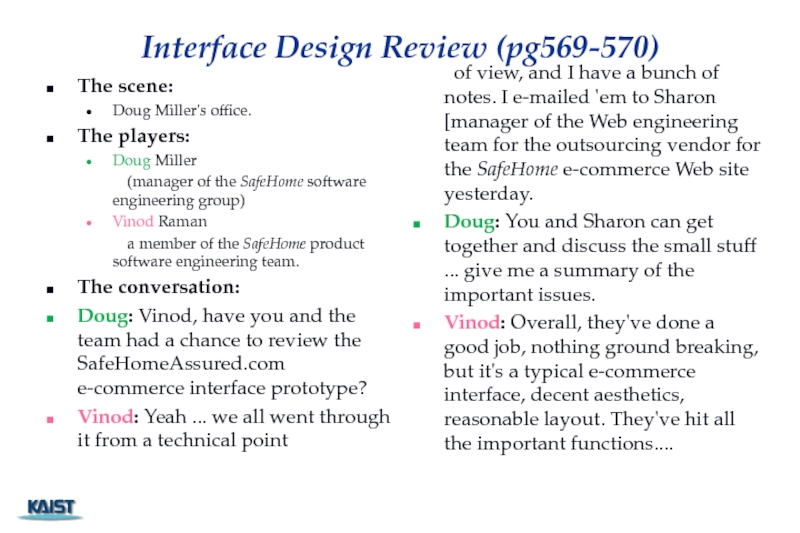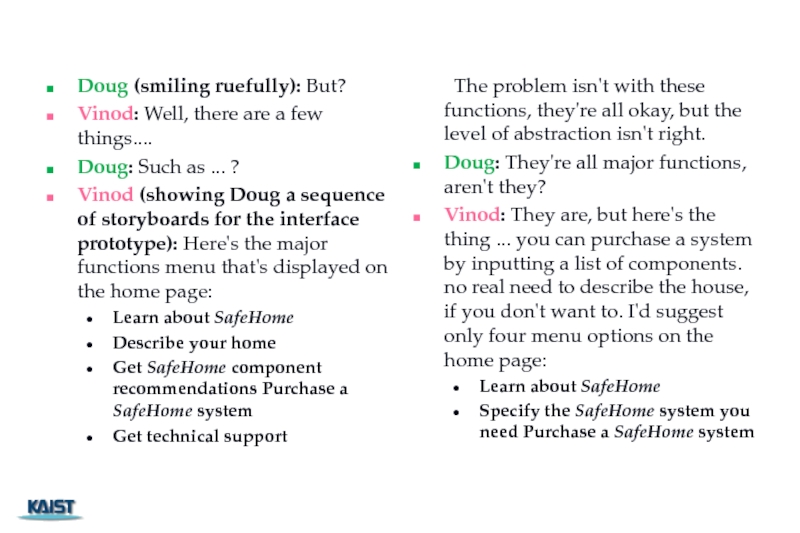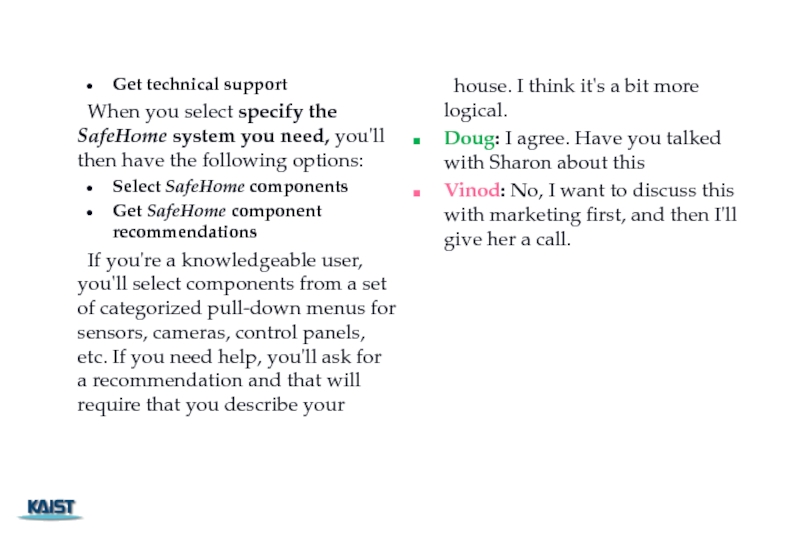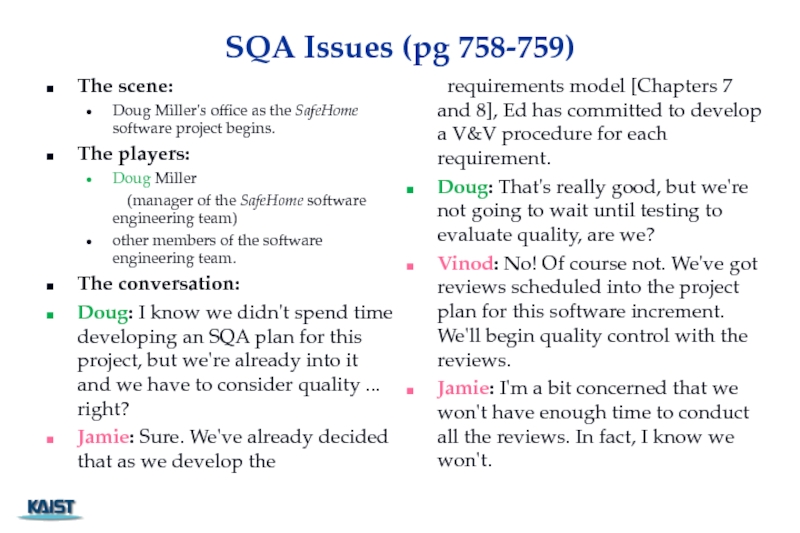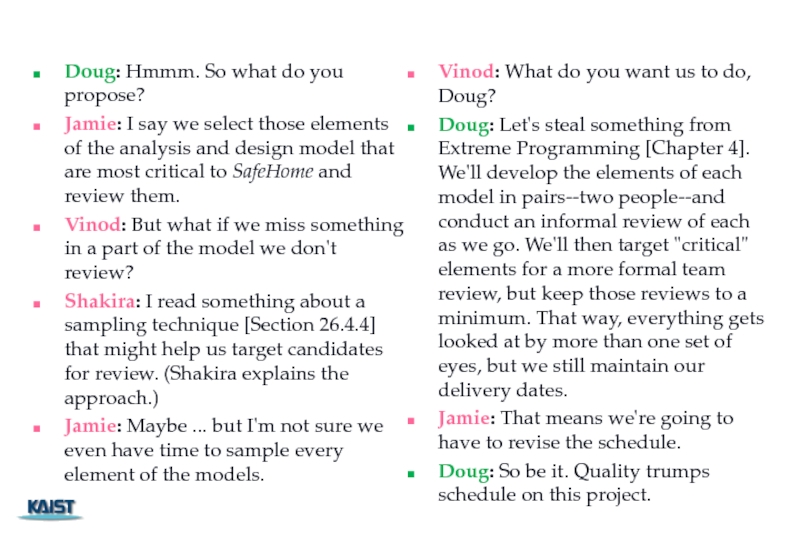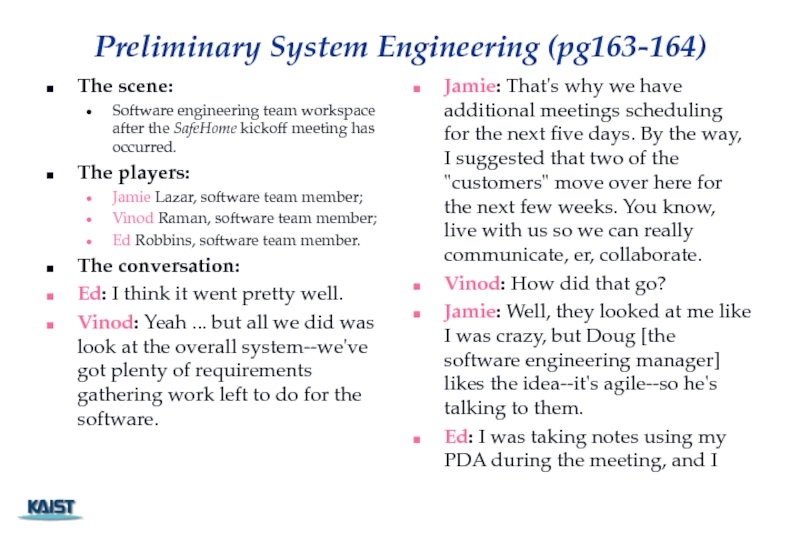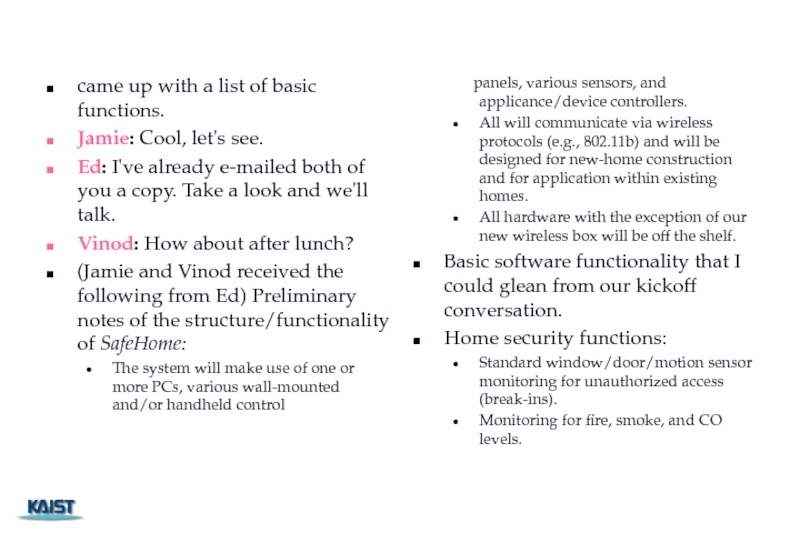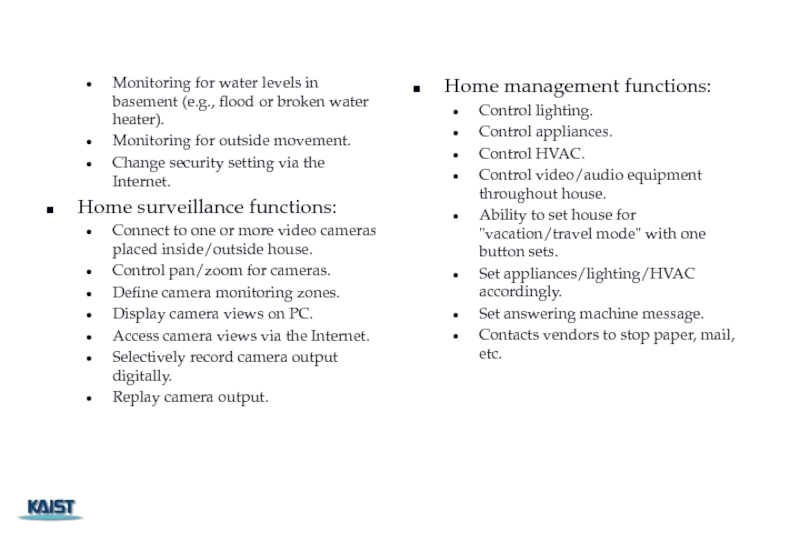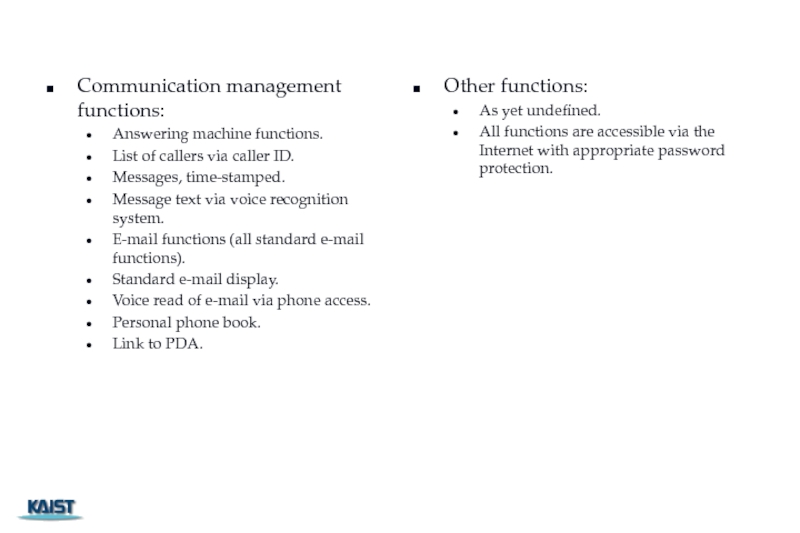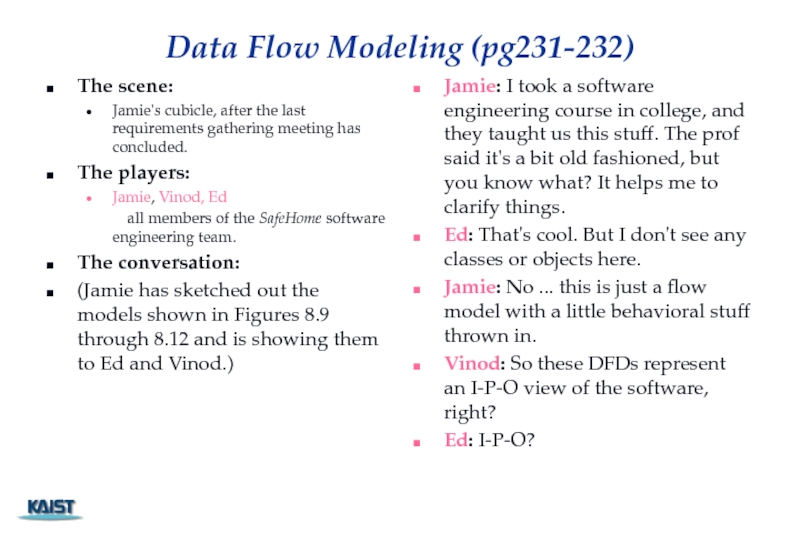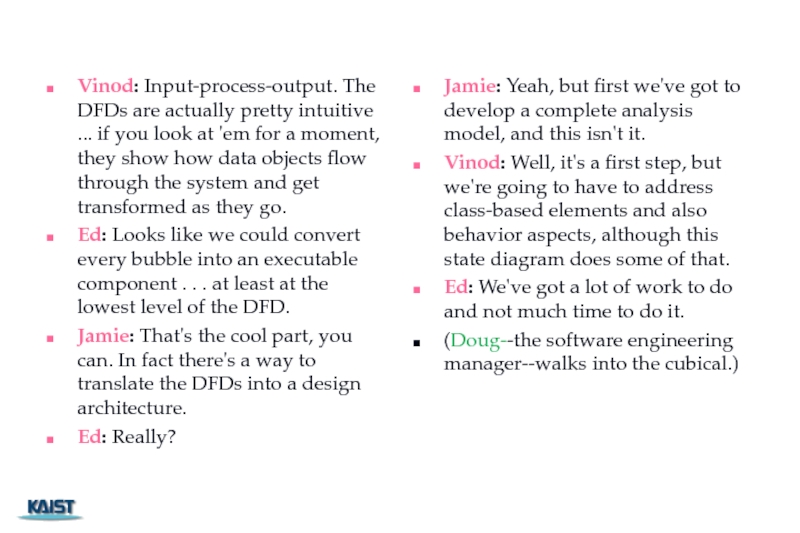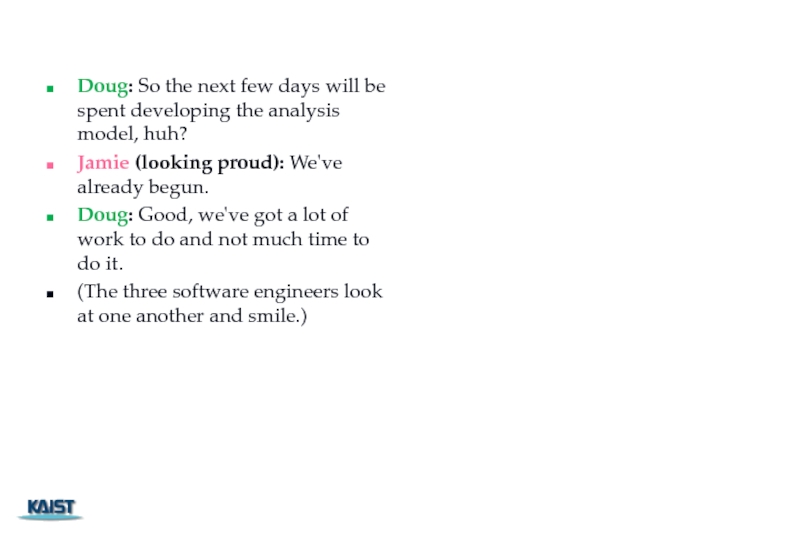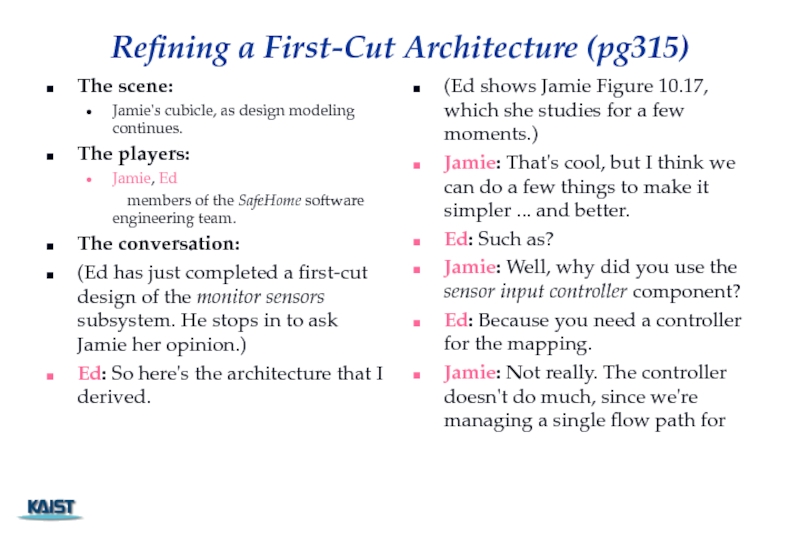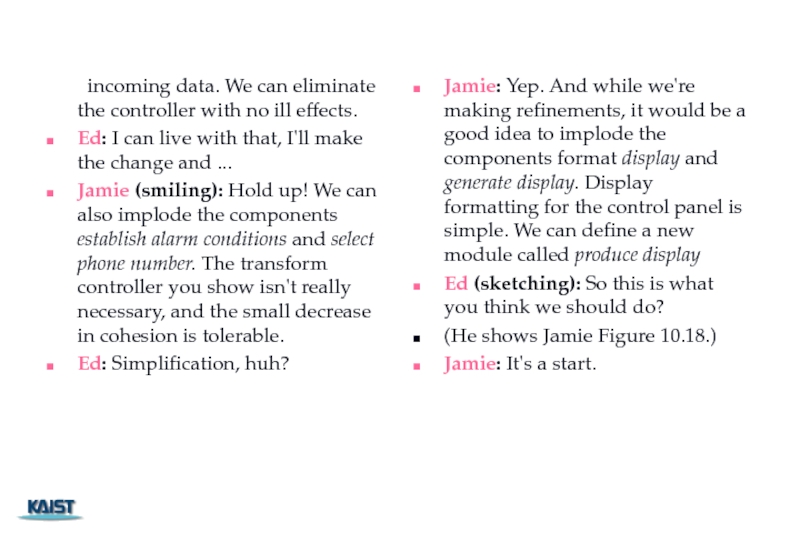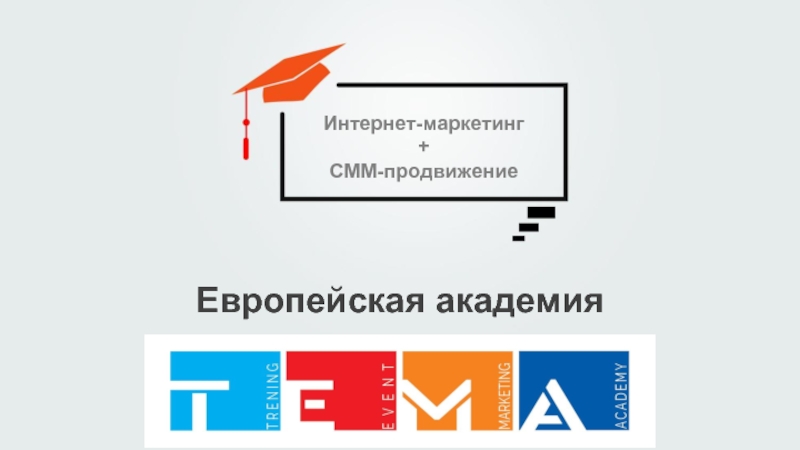- Главная
- Разное
- Дизайн
- Бизнес и предпринимательство
- Аналитика
- Образование
- Развлечения
- Красота и здоровье
- Финансы
- Государство
- Путешествия
- Спорт
- Недвижимость
- Армия
- Графика
- Культурология
- Еда и кулинария
- Лингвистика
- Английский язык
- Астрономия
- Алгебра
- Биология
- География
- Детские презентации
- Информатика
- История
- Литература
- Маркетинг
- Математика
- Медицина
- Менеджмент
- Музыка
- МХК
- Немецкий язык
- ОБЖ
- Обществознание
- Окружающий мир
- Педагогика
- Русский язык
- Технология
- Физика
- Философия
- Химия
- Шаблоны, картинки для презентаций
- Экология
- Экономика
- Юриспруденция
Quick Overview of SafeHome презентация
Содержание
- 1. Quick Overview of SafeHome
- 2. How a Project Starts
- 3. Lee: (jumping in)
- 4. Selecting a Process Model, Part 1(pg 47)
- 5. not push paper
- 6. oriented ... probably
- 7. Selecting a Process Model, Part 2(pg 50)
- 8. need one plan,
- 9. Considering Agile Software Development (pg 76-77) The
- 10. programming concept, for
- 11. (The team members look at one
- 12. Team Structure (pg 93) The scene:
- 13. Doug: That's okay with me, but
- 14. Communication Mistakes (pg 111-112) The scene:
- 15. us to act
- 16. Conducting a Requirements Gathering Meeting (pg145) The
- 17. Facilitator: Does that also add some
- 18. Developing a Preliminary User Scenario (pg 147)
- 19. Marketing person: Um. .. , well,
- 20. Facilitator (interrupting): Good point, Jamie, but
- 21. Developing a High-Level Use-Case Diagram (pg 153)
- 22. ovals represent use-cases that we've written
- 23. Preliminary Behavioral Modeling (pg 157) The scene:
- 24. basics of behavioral modeling to the
- 25. The Start of a Negotiation (pg 160)
- 26. Lisa: We've got to have it
- 27. functions can wait until the next
- 28. Domain Analysis (pg 171) The scene:
- 29. Doug (a wan smile): I know,
- 30. Doug: Ah . . . it’s
- 31. Developing Another Preliminary User Scenario (pg 174)
- 32. allow the homeowner to check out
- 33. control pan and zoom for a
- 34. Use-Case Template for Surveillance (pg 178) Use-case:
- 35. The homeowner selects the "view" button.
- 36. Channel to actor: Via PC-based browser
- 37. Class Models (pg 190-191) The scene:
- 38. I've shown. [Associations are discussed in
- 39. (Jamie asks questions which result in
- 40. CRC models (pg 197-198) The scene:
- 41. on and off, to control appliances
- 42. Ed: The hardware guys have got
- 43. devicelcons--info on icons representing lights, appliances,
- 44. Ed: So when the operation accessFloorplan()
- 45. Discovering an Analysis Pattern (pg 209) The
- 46. Ed: We have access to a
- 47. Design versus Coding (pg 227) The scene:
- 48. Vinod: And a screwed-up architecture can
- 49. Design Concepts (pg 239) The scene:
- 50. Shakira: I wasn't a CS grad,
- 51. Ed: Yep. It's not a whole
- 52. Refining an Analysis Class into a Design
- 53. Vinod: The analysis class showed only
- 54. Choosing an Architectural Style (pg 262) The
- 55. think of the hierarchy (aggregation) we
- 56. Evaluating Architectural Decisions(pg 265) The scene:
- 57. Jamie: What about symmetry? Ed: Well,
- 58. Ed: I suppose it might be
- 59. Architecture Assessment (pg 276) The scene:
- 60. can do our assessment and choose
- 61. ask them how SafeHome is likely
- 62. The OCP in Action (pg 293) The
- 63. Vinod: Nope. Doug wants to know
- 64. Cohesion in Action (pg 297) The scene:
- 65. it might be a good idea
- 66. Ed: I wouldn't be that sloppy.
- 67. Coupling in Action (pg 298-299) The scene:
- 68. Vinod (pensive): You mean rather than
- 69. Violating a UI "Golden Rule“ (pg 320-321)
- 70. Vinod: That's not the point ...
- 71. Use-Cases for UI Design (pg 327) The
- 72. examine the system administration behavior as
- 73. stretch the icons to their appropriate
- 74. Interface Design Review (pg 340) The scene:
- 75. Doug: Such as . . .
- 76. When you select Specify the SafeHome
- 77. Applying Patterns (pg 362) The scene:
- 78. thinking of having a set of
- 79. simple client-side JavaScript that communicates directly
- 80. Graphic Design (pg 377) The scene:
- 81. Vinod: Sure. The designer has a
- 82. Formulating MobileApp Requirements (pg 396-397) The scene:
- 83. Facilitator: Context aware in what sense?
- 84. Marketing person: OK, but a mobile
- 85. (Doug, serving as the recorder for
- 86. Quality Issues (pg 424) The scene:
- 87. Jamie: Do you mean things like
- 88. Quality Issues (pg 445) The scene:
- 89. Jamie: I say we select those elements
- 90. Software Quality Assurance (pg 454) The scene:
- 91. Doug: No worries. The audits are
- 92. Preparing for Testing (pg 471) The scene:
- 93. Doug: That's an Extreme Programming [an
- 94. Preparing for Validation (pg 485) The scene:
- 95. acceptance testing and also for alpha
- 96. Debugging (pg 490) The scene: Ed's
- 97. Shakira: Indulge me ... what's the
- 98. Designing Unique Tests (pg 499) The scene:
- 99. Ed: Well, they're different values. Vinod:
- 100. Using Cyclomatic Complexity (pg 504) The scene:
- 101. Shakira (exasperated): And exactly how do
- 102. Class Testing (pg 533) The scene:
- 103. (Shows Jamie the following sequence.) enable-test-read-disable
- 104. should generate the error message. If
- 105. WebApp Testing (pg555) The scene: Doug
- 106. point of view would be helpful,
- 107. Vinod: Of course . . .
- 108. MobileApp testing in the Production Environment (pg
- 109. Doug: We’re going to hire a
- 110. Doug: Oh . . . the
- 111. Stakeholder Security Concerns (pg 586) The scene:
- 112. Jamie: Not to mention the liability
- 113. Lisa: How can we do that?
- 114. Building the Security Case (pg 593) The
- 115. Bridget: Yes. Next, we take a
- 116. Bridget: Of course. My group needs
- 117. Security Steps (pg 595) The scene:
- 118. determine the threats to each asset. Vinod:
- 119. Security Test Case Creation (pg 597-598) The
- 120. Vinod: That gives us several logic
- 121. Ed: We should write a small
- 122. SCM Issues (pg 638) The scene:
- 123. Doug: As I see it, three
- 124. Debating Product Metrics (pg 658) The scene:
- 125. Ed: Wrong, it takes time and
- 126. Applying CK Metrics (pg 669) The scene:
- 127. (Jamie and Ed nod in the
- 128. Team Structure (pg 693) The scene:
- 129. Doug: That's okay with me, but
- 130. Establishing a Metrics Approach (pg 708) The
- 131. Doug: Look, we're going to be
- 132. Doug: I'm going to ask you
- 133. Establishing a Metrics Approach (pg 719) The
- 134. I think we can use it
- 135. Estimating (pg 737-738) The scene: Doug
- 136. Jamie: Whoa! How are we supposed
- 137. Outsourcing (pg 751-752) The scene: Meeting
- 138. you make a final decision, a
- 139. seem, (3) we're de facto committing
- 140. Tracking the Schedule (pg 772) The scene:
- 141. Vinod: We have. Doug: Who makes
- 142. Risk Analysis (pg 787) The scene:
- 143. Doug: That's okay. We'll revisit the
- 144. Doug: No, let's leave it for
- 145. Conclusion? (pg 862) The scene: Doug
- 146. Vinod: There are a few issues,
- 147. Requirements Gathering for WebApps (pg518-519) The scene:
- 148. Vinod (exasperated): Doug ... you're not
- 149. Marketing person #2: We assume that
- 150. Marketing person #2: I'd like to
- 151. Outsourcing Preliminaries (pg529) The scene: Doug
- 152. Doug: Vinod gave you the basic
- 153. one-day granularity and talk or e-mail
- 154. Refining Use-Cases for WebApps (pg543-544) The scene:
- 155. Sam: The way we look at
- 156. designed specifically for customer support personnel.
- 157. Interface Design Review (pg569-570) The scene:
- 158. Doug (smiling ruefully): But? Vinod: Well,
- 159. Get technical support When you select
- 160. SQA Issues (pg 758-759) The scene:
- 161. Doug: Hmmm. So what do you
- 162. Preliminary System Engineering (pg163-164) The scene:
- 163. came up with a list of
- 164. Monitoring for water levels in basement
- 165. Communication management functions: Answering machine functions.
- 166. Data Flow Modeling (pg231-232) The scene:
- 167. Vinod: Input-process-output. The DFDs are actually
- 168. Doug: So the next few days
- 169. Refining a First-Cut Architecture (pg315) The scene:
- 170. incoming data. We can eliminate the
Слайд 1
Quick Overview of SafeHome
The SafeHome company has developed an
The idea is to use this technology to develop and market a comprehensive home automation product line.
This would provide security functions, control over telephone answering machines, lights, heating, air conditioning, and home entertainment devices.
The first generation of the system will only focus on home security and surveillance since that is a market the public readily understands.
Слайд 2
How a Project Starts (pg 26)
The scene:
Meeting room
The players:
Mal Golden, senior manager, product development;
Lisa Perez, marketing manager;
Lee Warren, engineering manager;
Joe Camalleri, executive VP, business development.
The conversation:
Joe: Okay, Lee, what's this I hear about your folks developing a what? A generic universal wireless box?
Lee: It's pretty cool, about the
size of a small matchbook. We can attach it to sensors of all kinds, a digital camera, just about anything. Using the 802.11 b wireless protocol. It allows us to access the device's output without wires. We think it'll lead to a whole new generation of products.
Joe: You agree, Mal?
Mal: I do. In fact, with sales as flat as they've been this year, we need something new. Lisa and I have been doing a little market research, and we think we've got a line of products that could be big.
Joe: How big... , bottom-line big?
Слайд 3
Lee: (jumping in) Engineering's done a technical feasibility study
Joe: Interesting. Now, I asked about the bottom line.
Mal: PCs have penetrated 60 percent of all households in the USA. If we could price this thing right, it could be a killer-App. Nobody else has our wireless box--it's proprietary. We'll have a two-year jump on the competition. Revenue? Maybe as much as $30-40 million in the second year.
Joe (smiling): Let's take this to the next level. I'm interested.
Mal: (avoiding a direct commitment): Tell him about our idea, Lisa.
Lisa: It's a whole new generation of what we call "home management products." We call 'em SafeHome. They use the new wireless interface, provide homeowners or small business people with a system that's controlled by their PC--home security, home surveillance, appliance and device control. You know, turn down the home air conditioner while you're driving home, that sort of thing.
Слайд 4Selecting a Process Model, Part 1(pg 47)
The scene:
Meeting room for
The players:
Lee Warren, engineering manager;
Doug Miller, software engineering manager;
Jamie Lazar, software team member;
Vinod Raman, software team member;
Ed Robbins, software team member.
The conversation:
Lee: So let's recapitulate. I've spent some time discussing the SafeHome product line as we
see it at the moment. No doubt, we've got a lot of work to do to simply define the thing, but I'd like you guys to begin thinking about how you're going to approach the software part of this project.
Doug: Seems like we've been pretty disorganized in our approach to software in the past.
Ed: I don't know, Doug. We always got product out the door.
Doug: True, but not without a lot of grief, and this project looks like it's bigger and more
Слайд 5
not push paper around.
Doug: Give it a chance before
Doug: So anyway, it seems to me that a linear model is not for us ... assumes we have all requirements up front and knowing this place, that's not likely.
Vinod: Yeah, and that RAD model sounds way too IT-
complex than anything we've done in the past.
Jamie: Doesn't look that hard, but I agree ... our ad hoc approach to past projects won't work here, particularly if we have a very tight timeline.
Doug (smiling): I want to be a bit more professional in our approach. I went to a short course last week and learned a lot about software engineering ... good stuff. We need a process here.
Jamie (with a frown): My job is to build computer programs,
Слайд 6
oriented ... probably good for building an inventory control
Doug: I agree.
Ed: That prototyping approach seems OK. A lot like what we do here anyway.
Vinod: That's a problem. I'm worried that it doesn't provide us with enough structure.
Doug: Not to worry. We've got plenty of other options, and I want you guys to pick what's best for the team and best for the project.
Слайд 7Selecting a Process Model, Part 2(pg 50)
The scene:
Meeting room for
The players:
Lee Warren, engineering manager;
Doug Miller, software engineering manager;
Ed and Vinod, members of the software engineering team.
The conversation:
(Doug describes evolutionary process options.)
Ed: Now I see something I like. An incremental approach makes
sense and I really like the flow of that spiral model thing. That's keepin' it real.
Vinod: I agree. We deliver an increment, learn from customer feedback, re-plan, and then deliver another increment. It also fits into the nature of the product. We can have something on the market fast and then add functionality with each version, er, increment.
Lee: Wait a minute, did you say that we regenerate the plan with each tour around the spiral, Doug? That's not so great, we
Слайд 8
need one plan, one schedule, and we've got
Doug: That's old school thinking, Lee. Like Ed said, we've got to keep it real. I submit that it's better to tweak the plan as we learn more and as changes are requested. It's way more realistic. What's the point of a plan if it doesn't reflect reality?
Lee (frowning): I suppose so, but senior management's not going to like this ... they want a fixed plan.
Doug (smiling): Then you'll have to reeducate them, buddy.
Слайд 9Considering Agile Software Development (pg 76-77)
The scene:
Doug Miller's office.
The players:
Doug Miller, software engineering manager;
Jamie Lazar, software team member;
Vinod Raman, software team member.
The conversation:
(A knock on the door)
Jamie: Doug, you got a minute?
Doug: Sure Jamie, what's up?
Jamie: We've been thinking about our process discussion yesterday ... you know, what process we're going to choose for this new SafeHome project.
Doug: And?
Vinod: I was talking to a friend at another company, and he was telling me about Extreme Programming. It's an agile process model, heard of it?
Doug: Yeah, some good, some bad.
Jamie: Well, it sounds pretty good to us. Lets you develop software really fast, uses something called pair programming to do real-time quality checks ... it's pretty cool, I think.
Doug: It does have a lot of really good ideas. I like the pair
Слайд 10
programming concept, for instance, and the idea that
Jamie: Huh? You mean that marketing will work on the project team with us?
Doug (nodding): They're a stakeholder, aren't they?
Jamie: Jeez ... they'll be requesting changes every five minutes.
Vinod: Not necessarily. My friend said that there are ways to "embrace" changes during an XP project.
Doug: So you guys think we should use XP?
Jamie: It's definitely worth considering.
Doug: I agree. And even if we choose an incremental model as our approach, there's no reason why we can't incorporate much of what XP has to offer.
Vinod: Doug, before you said "some good, some bad." What was the "bad"?
Doug: The thing I don't like is the way XP downplays analysis and design ... sort of says that writing code is where the action is.
Слайд 11
(The team members look at one another and smile.)
Doug: So you
Jamie (speaking for both): Writing code is what we do, Boss!
Doug (laughing): True, but I'd like to see you spend a little less time coding and then re-coding and a little more time analyzing what has to be done and designing a solution that works.
Vinod: Maybe we can have it both ways, agility with a little discipline.
Doug: I think we can, Vinod. In fact, I'm sure of it.
Слайд 12Team Structure (pg 93)
The scene:
Doug Miller's office prior to the
The players:
Doug Miller
(manager of the SafeHome software engineering team)
Vinod Raman, Jamie Lazar, other members of the product software engineering team.
The conversation:
Doug: Have you guys had a chance to look over the preliminary info on SafeHome that marketing's prepared?
Vinod (nodding and looking at his teammates): Yes. But we have a bunch of questions.
Doug: Let's hold on that for a moment. I'd like to talk about how we're going to structure the team, who's responsible for what. . . .
Jamie: I'm really into the agile philosophy, Doug. I think we should be a self-organizing team.
Vinod: I agree. Given the tight time line and some of the uncertainty, and that fact that we're all really competent [laughs], that seems like the right way to go.
Слайд 13
Doug: That's okay with me, but you guys know the drill.
Jamie
Vinod: and with quality.
Doug: Exactly. But remember there are constraints. Marketing defines the software increments to be produced--in consultation with us, of course.
Jamie: And?
Слайд 14Communication Mistakes (pg 111-112)
The scene:
Software engineering team workspace.
The players:
Jamie
Vinod Raman, software team member;
Ed Robbins software team member.
The conversation:
Ed: What have you heard about this SafeHome project?
Vinod: The kick-off meeting is scheduled for next week.
Jamie: I've already done a little bit of investigation, but it didn't go well."
Ed: What do you mean?
Jamie: Well, I gave Lisa Perez a call. She's the marketing honcho on this thing."
Vinod: And ... ?
Jamie: I wanted her to tell me about SafeHome features and functions ... that sort of thing. Instead, she began asking me questions about security systems, surveillance systems ... I'm no expert.
Vinod: What does that tell you?
(Jamie shrugs.)
Vinod: That marketing will need
Слайд 15
us to act as consultants and that we'd
Ed: Probably would have been better to stop by her office. Phone calls just don't work as well for this sort of thing.
Jamie: You're both right. We've got to get our act together or our early communications will be a struggle.
Vinod: I saw Doug reading a book on "requirements engineering." I'll bet that lists some principles of good communication. I'm going to borrow it from him.
Jamie: Good idea ... then you can teach us.
Vinod (smiling): Yeah, right.
Слайд 16Conducting a Requirements Gathering Meeting (pg145)
The scene:
A meeting room. The
The players:
Jamie Lazar, software team member;
Vinod Raman, software team member;
Ed Robbins, software team member;
Doug Miller, software engineering manager;
three members of marketing;
a product engineering representative;
a facilitator.
The conversation:
Facilitator (pointing at white board): So that's the current list of objects and services for the home security function.
Marketing person: That about covers it from our point of view.
Vinod: Didn't someone mention that they wanted all SafeHome functionality to be accessible via the Internet? That would include the home security function, no?
Marketing person: Yes, that's right ... we'll have to add that functionality and the appropriate objects.
Слайд 17
Facilitator: Does that also add some constraints?
Jamie: It does, both technical
Production rep: Meaning?
Jamie: We better make sure an outsider can't hack into the system, disarm it, and rob the place or worse. Heavy liability on our part.
Doug: Very true.
Marketing: But we still need Internet connectivity . just be sure to stop an outsider from getting in.
Ed: That's easier said than done and....
Facilitator (interrupting): I don't want to debate this issue now. Let's note it as an action item and proceed. (Doug, serving as the recorder for the meeting, makes an appropriate note.)
Facilitator: I have a feeling there's still more to consider here.
(The group spends the next 45 minutes refining and expanding the details of the home security function.)
Слайд 18Developing a Preliminary User Scenario (pg 147)
The scene:
A meeting room,
The players:
Jamie Lazar, software team member;
Vinod Raman, software team member;
Ed Robbins, software team member;
Doug Miller, software engineering manager;
three members of marketing;
a product engineering representative;
a facilitator.
The conversation:
Facilitator: We've been talking about security for access to SafeHome functionality that will be accessible via the Internet. I'd like to try something.
Let's develop a user scenario for access to the home security function.
Jamie: How?
Facilitator: We can do it a couple of different ways, but for now, I'd like to keep things really informal. Tell us (he points at a marketing person) how you envision accessing the system.
Слайд 19
Marketing person: Um. .. , well, this is the kind of
Facilitator (smiling): That's the reason you'd do it .. . tell me how you'd actually do this.
Marketing person: Um . . . the first thing I'd need is a PC. I'd log on to a Web site we'd maintain for all users of SafeHome. I'd provide my user id and ...
Vinod (interrupting): The Web page would have to be secure, encrypted, to guarantee that we're safe and....
Facilitator (interrupting): That's good information, Vinod, but it's technical. Let's just focus on how the end-user will use this capability, OK?
Vinod: No problem.
Marketing person: So, as I was saying, I'd log on to a Web site and provide my user id and two levels of passwords.
Jamie: What if I forget my password?
Слайд 20
Facilitator (interrupting): Good point, Jamie, but let's not address that now.
Marketing person: After I enter the passwords, a screen representing all SafeHome functions will appear. I'd select the home security function. The system might request that I verify who I am, say by asking for my address or phone number or something. It would then display a picture of the
security system control panel along with a list of functions that I can perform--arm the system, disarm the system, disarm one or more sensors. I suppose it might also allow me to reconfigure security zones and other things like that, but I'm not sure.
(As the marketing person continues talking, Doug takes copious notes. These form the basis for the first informal use-case scenario. Alternatively, the marketing person could have been asked to write the scenario, but this would be done outside the meeting.)
Слайд 21Developing a High-Level Use-Case Diagram (pg 153)
The scene:
A meeting room,
The players:
Jamie Lazar, software team member;
Vinod Raman, software team member;
Ed Robbins, software team member;
Doug Miller, software engineering manager;
three members of marketing;
a product engineering representative;
a facilitator.
The conversation:
Facilitator: We've spent a fair amount of time talking about SafeHome home security functionality. During the break I sketched a use-case diagram to summarize the important scenarios that are part of this function. Take a look.
(All attendees look at Figure 7.3.)
Jamie: I'm just beginning to learn UML notation. So the home security function is represented by the big box with the ovals inside it? And the
Слайд 22
ovals represent use-cases that we've written in text?
Facilitator: Yep. And the
as described by the use-case ... oh, I use the labeled square to represent an actor that's not a person, in this case, sensors.
Doug: Is that legal in UML?
Facilitator: Legality isn't the issue. The point is to communicate information. I view the use of a human-like stick figure for representing a device to be misleading. So I've
adapted things a bit. I don't think it creates a problem.
Vinod: Okay, so we have use-case narratives for each of the ovals. Do we need to develop the more detailed template-based narratives I've read about?
Facilitator: Probably, but that can wait until we've considered other SafeHome functions.
Marketing person: Wait, I've been looking at this diagram, and all of a sudden I realize we missed something.
Facilitator: Oh really. Tell me what we've missed. (The meeting continues.)
Слайд 23Preliminary Behavioral Modeling (pg 157)
The scene:
A meeting room, continuing the
The players:
Jamie Lazar, software team member;
Vinod Raman, software team member;
Ed Robbins, software team member;
Doug Miller, software engineering manager;
three members of marketing;
a product engineering representative;
a facilitator.
The conversation:
Facilitator: We've just about finished talking about SafeHome home security functionality. But before we do, I want to discuss the behavior of the function.
Marketing person: I don't understand what you mean by behavior.
Ed (laughing): That's when you give the product a "timeout" if it misbehaves.
Facilitator: Not exactly. Let me explain.
(The facilitator explains the
Слайд 24
basics of behavioral modeling to the requirements gathering team.)
Marketing person: This
Facilitator: Sure you can. What behavior do you observe from the user's point of view?
Marketing person: Uh... , well the system will be monitoring the sensors. It'll be reading commands from the homeowner. It'll be displaying its status.
Facilitator: See, you can do it.
Jamie: It'll also be polling the PC to determine if there is any input from it, for example Internet-based access or configuration information.
Vinod: Yeah, in fact, configuring the system is a state in its own right.
Doug: You guys are rolling. Let's give this a bit more thought . . . Is there a way to diagram this stuff?
Facilitator: There is, but let's postpone that until after the meeting.
Слайд 25The Start of a Negotiation (pg 160)
The scene:
Lisa Perez's office,
The players:
Doug Miller, software engineering manager
Lisa Perez, marketing manager.
The conversation:
Lisa: So, I hear the first meeting went really well.
Doug: Actually, it did. You sent some good people to the meeting ... they really contributed.
Lisa (smiling): Yeah, they actually told me they got into it, and it wasn't a propeller head activity.
Doug (laughing): I'll be sure to take off my techie beanie the next time I visit ... Look, Lisa, I think we may have a problem with getting all of the functionality for the home security function out by the dates your management is talking about. It's early, I know, but I've already been doing a little back of the envelope planning and....
Слайд 26
Lisa: We've got to have it by that date, Doug. What
Doug: I figure we can get full home security functionality out by the drop-dead date, but we'll have to delay Internet access till the second release.
Lisa: Doug, it's the Internet access that gives SafeHome "gee whiz" appeal. We're going to build our entire marketing campaign around it. We've gotta have it!
Doug: I understand your situation, I really do. The problem is that in order to give you Internet access, we'll need a fully secure Web site up and running. That takes time and people. We'll also have to build a lot of additional functionality into the first release . . . I don't think we can do it with the resources we've got.
Lisa (frowning): I see, but you've got to figure out a way to get it done. It's pivotal to home security functions and to other functions as well ... the other
Слайд 27
functions can wait until the next releases . . . I'll
Lisa and Doug appear to be at an impasse, and yet they must negotiate a solution to this problem. Can they both "win" here? Playing the role of a mediator, what would you suggest?
Слайд 28Domain Analysis (pg 171)
The scene:
Doug Miller’s office, after a meeting
The players:
Doug Miller, software engineering manager;
Vinod Raman, software team member.
The conversation:
Doug: I need you for a special project, Vinod. I’m going to pull you out of the requirements gathering meetings.
Vinod (frowning): Too bad. That format actually works . . . I was getting something out of it. What’s up?
Doug: Jamie and Ed will cover for you. Anyway, marketing insists that we deliver the Internet capability along with the home security function in the first release of SafeHome. We’re under the gun on this . . . not enough time or people, so we’ve got to solve both problems—the PC interface and the Web interface—at once.
Vinod (looking confused): I didn’t know the plan was set . . . we’re not even finished with requirements gathering.
Слайд 29
Doug (a wan smile): I know, but the time lines are
Vinod: Okay, what’s up? What do you want me to do?
Doug: Do you know what “domain analysis” is?
Vinod: Sort of. You look for similar patterns in Apps that do the same kinds of things as the App you’re building. If possible, you then steal the patterns and reuse them in your work.
Doug: Not sure I like the word steal, but basically you have it right. What I’d like you to do is to begin researching existing user interfaces for systems that control something like SafeHome. I want you to propose a set of patterns and analysis classes that can be common to both the PC-based interface that’ll sit in the house and the browser-based interface that is accessible via the Internet.
Vinod: We can save time by making them the same . . . why don’t we just do that?
Слайд 30
Doug: Ah . . . it’s nice to have people who
Vinod: So you want, what—classes, analysis patterns, design patterns?
Doug: All of ‘em. Nothing formal at this point. I just want to get a head start on our internal analysis and design work.
Vinod: I’ll go to our class library and see what we’ve got. I’ll also use a patterns template I saw in a book I was reading a few months back.
Doug: Good. Go to work.
Слайд 31Developing Another Preliminary User Scenario (pg 174)
The scene:
A meeting room,
The players:
Jamie Lazar, software team member;
Ed Robbins, software team member;
Doug Miller, software engineering manager;
three members of marketing;
a product engineering representative;
a facilitator.
The conversation:
Facilitator: It's time that we begin talking about the
SafeHome surveillance function. Let's develop a user scenario for access to the home security function.
Jamie: Who plays the role of the actor on this?
Facilitator: I think Meredith (a marketing person) has been working on that functionality. Why don't you play the role.
Meredith: You want to do it the same way we did it last time, right?
Facilitator: Right ... same way.
Meredith: Well, obviously the reason for surveillance is to
Слайд 32
allow the homeowner to check out the house while he or
Ed: Will the video be digital, and will it be stored on disk?
Facilitator: Good question, but let's postpone implementation issues for now. Meredith?
Meredith: Okay, so basically there are two parts to the surveillance function ... the first configures the system including laying out a floor plan--we need tools to help the
homeowner do this--and the second part is the actual surveillance function itself. Since the layout is part of the configuration activity, I'll focus on the surveillance function.
Facilitator (smiling): Took the words right out of my mouth.
Meredith: Um ... I want to gain access to the surveillance function either via the PC or via the Internet. My feeling is that the Internet access would be more frequently used. Anyway, I want to be able to display camera views on a PC and
Слайд 33
control pan and zoom for a specific camera. I specify the
Jamie: Those are called thumbnail views.
Meredith: Okay, then I want thumbnail views from all the cameras. I also want the interface to the surveillance function to have the same look and feel as all other SafeHome interfaces. I want it to be intuitive, meaning I don't want to have to read a manual to use it.
Facilitator: Good job, now, let's go into this function in a bit more detail....
Слайд 34Use-Case Template for Surveillance (pg 178)
Use-case:
Access camera surveillance--display camera views
Primary actor:
Homeowner.
Goal in context:
To view output of camera placed throughout the house from any remote location via the Internet.
Preconditions:
System must be fully configured; appropriate user ID and passwords must be obtained.
Trigger:
The homeowner decides to take a look inside the house while away.
Scenario:
The homeowner logs onto the SafeHome Products Web site.
The homeowner enters his or her user ID.
The homeowner enters two passwords (each at least eight characters in length).
The system displays all major function buttons.
The homeowner selects "surveillance" from the major function buttons.
The homeowner selects "pick a camera."
The system displays the floor plan of the house.
The homeowner selects a camera icon from the floor plan.
Слайд 35
The homeowner selects the "view" button.
The system displays a viewing window
The system displays video output within the viewing window at one frame per second.
Exceptions:
ID or passwords are incorrect or not recognized—see use-case: "validate ID and passwords."
Surveillance function not configured for this system--system displays appropriate error message; see use-case: "configure surveillance function."
Homeowner selects "view thumbnail snapshots for all cameras"--see use-case: "view thumbnail snapshots for all cameras."
A floor plan is not available or has not been configured--display appropriate error message and see use-case: "configure floor plan."
An alarm condition is encountered--see use-case: "alarm condition encountered."
Priority:
Moderate priority, to be implemented after basic functions.
When available: Third increment.
Frequency of use: Infrequent.
Слайд 36
Channel to actor:
Via PC-based browser and Internet connection to SafeHome Web
Secondary actors:
System administrator, cameras.
Channels to secondary actors:
System administrator: PC-based system
Cameras: wireless connectivity
Open issues:
What mechanisms protect unauthorized use of this capability by employees of the company?
Is security sufficient? Hacking into this feature would represent a major invasion of privacy.
Will system response via the Internet be acceptable given the bandwidth required for camera views?
Will we develop a capability to provide video at a higher frames-per-second rate when high bandwidth connections are available?
Слайд 37Class Models (pg 190-191)
The scene:
Ed's cubicle, as analysis modeling begins.
The
Jamie, Vinod, Ed
all members of the SafeHome software engineering team.
The conversation:
(Ed has been working to extract classes from the use-case template for Access camera surveillance--display camera views" [presented in an earlier sidebar in this chapter] and is presenting the classes he has extracted to his colleagues.)
Ed: So when the homeowner wants to pick a camera, he or she has to pick it from a floor plan. I've defined a FloorPlan class. Here's the diagram.
(They look at Figure 8.14.)
Jamie: So FloorPlan is a class that is put together with walls that are composed of wall segments, doors and windows, and also cameras; that's what those labeled lines mean, right?
Ed: Yeah, they're called "associations." One class is associated with another according to the associations
Слайд 38
I've shown. [Associations are discussed in Section 8.7.5.]
Vinod: So the actual
Ed: It doesn't, but the other classes do. See the attributes under, say, WallSegment, which is used to build a wall. The wall segment has start and stop coordinates and the draw () operation does the rest.
Jamie: And the same goes for windows and doors. Looks like camera has a few extra attributes.
Ed: Yeah, I need them to provide pan and zoom info.
Vinod: I have a question. Why does the camera have an ID but the others don't?
Ed: We'll need to identify each camera for display purposes.
Jamie: Makes sense to me, but I do have a few more questions.
Слайд 39
(Jamie asks questions which result in minor modifications.)
Vinod: Do you have
Ed:" I'm not quite sure how to do them.
Vinod: It's not hard, and they really pay off. I'll show you.
Слайд 40CRC models (pg 197-198)
The scene:
Ed's cubicle, as analysis modeling continues.
The
Vinod, Ed
members of the SafeHome software engineering team.
The conversation:
(Vinod has decided to show Ed how to develop CRC cards by showing him an example.)
Vinod: While you've been working on surveillance and Jamie has been tied up with security, I've been working on the home management function.
Ed: What's the status of that? Marketing kept changing its mind.
Vinod: Here's the first cut use-case for the whole function ... we've refined it a bit, but it should give you an overall view.
Use-case: SafeHome home management function.
Narrative: We want to use the home management interface on a PC or an Internet connection to control electronic devices that have wireless interface controllers. The system should allow me to turn specific lights
Слайд 41
on and off, to control appliances that are connected to a
One is home, another is away, a third is overnight travel, and a fourth is extended travel. All of these situations will have settings that will be applied to all devices. In the overnight travel and extended travel states, the system should turn lights on and off at random intervals (to make it look like someone is home) and control the heating and air conditioning system. I should be able to override these settings via the Internet with appropriate password protection.
Слайд 42
Ed: The hardware guys have got all the wireless interfacing figured
Vinod (smiling): They're working on it, say it's no biggy. Anyway, I extracted a bunch of classes for home management, and we can use one as an example. Let's use the HomeManagementlnterface class.
Ed: Okay . . . so the responsibilities are ... the attributes and operations for the class, and the collaborations are the classes that the responsibilities point to.
Vinod: I thought you didn't understand CRC.
Ed: Maybe a little, but go ahead.
Vinod: So here's my class definition for HomeManagementlnterface.
Attributes:
optionsPanel--provides info on buttons that enable user to select functionality
situationPanel--provides info on buttons that enable user to select situation
FloorPlan--same as surveillance object but this one displays devices
Слайд 43
devicelcons--info on icons representing lights, appliances, HVAC, etc.
devicePanels--simulation of appliance or
Operations:
displayControl(), selectControl(), displaySituation(), selectSituation(), accessFloorplan(), selectDevicelcon(), displayDevicePanel(), accessDevicePanel(), . . .
Class:
HomeManagementInterface
Responsibility Collaborator
displayControl OptionsPanel (class)
selectControl OptionsPanel (class)
displaySituation SituationPanel (class)
selectSituation SituationPanel (class)
accessFloorplan FloorPlan (class) ...
•
•
•
Слайд 44
Ed: So when the operation accessFloorplan() is invoked, it collaborates with
Vinod: Exactly. And if we wanted to review the entire class model, we could start with this index card, then go to the collaborator's index card, and from there to one of the collaborator's collaborators, and so on.
Ed: Good way to find omissions or errors.
Vinod: Yep.
Слайд 45Discovering an Analysis Pattern (pg 209)
The scene:
A meeting room, during
The players:
Jamie Lazar, software team member;
Ed Robbins, software team member;
Doug Miller, software engineering manager;
The conversation:
Doug: How are things going with modeling the requirements for the sensor network for the SafeHome project?
Jamie: Sensor work is a little new to me, but I think I’m getting a handle on it.
Doug: Is there anything we can do to help you with that?
Jamie: It would be a lot easier if I’d built a system like this before.
Doug: True.
Ed: I was thinking this is a situation where we might be able to find an analysis pattern that would help us model tese requirements.
Doug: If we can find the right pattern, we’d avoid reinventing the wheel.
Jamie: That sounds good to me. How do we start?
Слайд 46
Ed: We have access to a repository that contains a large
Doug: That seems like that might work. What do you think, Jamie?
Jamie: If Ed can help me get started, I’ll tackle this today.
Слайд 47Design versus Coding (pg 227)
The scene:
Jamie’s cubicle, as the team
The players:
Vinod, Jamie, Ed
all members of the SafeHome software engineering team.
The conversation:
Jamie: You know, Doug [the team manager] is obsessed with design. I gotta be honest, what I really love doing is coding. Give me C++ or Java, and I’m happy.
Ed: Nah . . . you like to design.
Jamie: You’re not listening; coding is where it’s at.
Vinod: I think what Ed means is you don’t really like coding; you like to design and express it in code. Code is the language you use to represent the design.
Jamie: And what’s wrong with that?
Vinod: Level of abstraction.
Jamie: Huh?
Ed: A programming language is good for representing details like data structures and algorithms, but it’s not so good for representing architecture or component-to-component collaboration . . . stuff like that.
Слайд 48
Vinod: And a screwed-up architecture can ruin even the best code.
Jamie
Vinod: You can certainly imply architecture in code, but in most programming languages, it’s pretty difficult to get a quick, big-picture read on architecture by examining the code.
Ed: And that’s what we want before we begin coding.
Jamie: Okay, maybe design and coding are different, but I still like coding better.
Слайд 49Design Concepts (pg 239)
The scene:
Vinod's cubicle, as design modeling begins.
The
Vinod, Jamie, Ed
members of the SafeHome software engineering team . Also, Shakira, a new member of the team.
The conversation:
(All four team members have just returned from a morning seminar, entitled "Applying Basic Design Concepts," offered by a local computer science professor.)
Vinod: Did you get anything out of the seminar?
Ed: Knew most of the stuff, but it's not a bad idea to hear it again, I suppose.
Jamie: When I was an undergrad CS major, I never really understood why information hiding was as important as they say it is.
Vinod: Because ... bottom line ... it's a technique for reducing error propagation in a program. Actually, functional independence also accomplishes the same thing.
Слайд 50
Shakira: I wasn't a CS grad, so a lot of the
Jamie: I've seen your work, Shak, and you know what, you do a lot of this stuff naturally ... that's why your designs and code work.
Shakira (smiling): Well, I always do try to partition the code, keep it focused on one thing, keep interfaces simple and constrained, reuse code
whenever I can that sort of thing.
Ed: Modularity, functional independence, hiding, patterns ... see.
Jamie: I still remember the very first programming course I took ... they taught us to refine the code iteratively.
Vinod: Same thing can be applied to design, you know.
Ed: The only concept I hadn't heard of before was "refactoring."
Shakira: That's used in Extreme Programming, I think she said.
Слайд 51
Ed: Yep. It's not a whole lot different than refinement, only
Jamie: Let's get back to SafeHome design. I think we should put these concepts on our review checklist as we develop the design model for SafeHome.
Vinod: I agree. But as important, let's all commit to think about them as we develop the design.
Слайд 52Refining an Analysis Class into a Design Class (pg 241)
The scene:
Ed's cubicle, as design modeling continues.
The players:
Vinod, Ed
members of the SafeHome software engineering team.
The conversation:
(Ed is working on the FloorPlan class [see sidebar discussion in Section 8.7.4 and Figure 8.14] and has refined it for the design model.)
Ed: So you remember the FloorPlan class, right? It's used
as part of the surveillance and home management functions.
Vinod (nodding): Yeah, I seem to recall that we used it as part of our CRC discussions for home management.
Ed: We did. Anyway, I'm refining it for design. Want to show how we'll actually implement the FloorPlan class. My idea is to implement it as a set of linked lists [a specific data structure]. So ... I had to refine the analysis class FloorPlan (Figure 8.14) and, actually, sort of simplify it.
Слайд 53
Vinod: The analysis class showed only things in the problem domain,
Ed: Yep, but for the FloorPlan design class, I've got to add some things that are implementation specific. I needed to show that FloorPlan is an aggregation of segments--hence the Segment class--and that the Segment class is composed of lists for wall segments, windows, doors, and so on. The class Camera
collaborates with FloorPlan, and obviously, there can be many cameras in the floor plan.
Vinod: Phew, let's see a picture of this new FloorPlan design class.
(Ed shows Vinod the drawing shown in Figure 9.3.)
Vinod: Okay, I see what you're trying to do. This allows you to modify the floor plan easily because new items can be added or deleted to the list--the aggregation--without any problems.
Ed (nodding): Yeah, I think it'll work. Vinod: So do I.
Слайд 54Choosing an Architectural Style (pg 262)
The scene:
Jamie's cubicle, as design
The players:
Jamie, Ed
members of the SafeHome software engineering team.
The conversation:
Ed (frowning): We've been modeling the security function using UML. . . you know classes, relationships,
that sort of stuff. So I guess the object-oriented architecture' is the right way to go.
Jamie: But . . . ?
Ed: But . . . I have trouble visualizing what an object-oriented architecture is. I get the call and return architecture, sort of a conventional process hierarchy, but 00 .. I don't know. It seems sort of amorphous.
Jamie (smiling): Amorphous, huh?
Ed: Yeah . . . what I mean is I can't visualize a real structure, just design classes floating in space.
Jamie: Well, that's not true. There are class hierarchies . . .
Слайд 55
think of the hierarchy (aggregation) we did for the FloorPlan object
Ed: I'm going to spend an hour mapping out a call and return architecture, then I'll go back and consider an 00 architecture.
Jamie: Doug'Il have no problem with that. He said that we should consider architectural alternatives. By the way, there's absolutely no reason why both of these architectures couldn't be used in combination with one another.
Ed: Good. I'm on it.
Слайд 56Evaluating Architectural Decisions(pg 265)
The scene:
Jamie's cubicle, as design modeling continues.
The
Jamie, Ed
members of the SafeHome software engineering team.
The conversation:
Ed: I finished my call-return architectural model of the security function.
Jamie: Great! Do you think it meets our needs?
Ed: It doesn’t introduce any unneeded features, so it seems to be economic.
Jamie: How about visibility?
Ed: Well, I understand the model and there’s no problem implementing the security requirements needed for this product.
Jamie: I get that you understand the architecture, but you may not be the programmer for this part of the project. I’m a little worried about spacing. This design may not be as modular as an object-oriented design.
Ed: Maybe, but that may limit our ability to reuse some of our code when we have to create the web-based version of this SafeHome.
Слайд 57
Jamie: What about symmetry?
Ed: Well, that’s harder for me to assess.
Jamie: That will get more complicated when we add remote security features to the web-based product.
Ed: That’s true, I guess.
[They both pause for a moment, pondering the architectural issues.]
Jamie: SafeHome is a real-time system, so state transition and sequencing of events will be tough to predict.
Ed: Yeah, but the emergent behavior of this system can be handled with a finite state model.
Jamie: How?
Ed: The mode can be implemented based on the call-return architecture. Interrupts can be handled easily in many programming languages.
Jamie: Do you think we need to do the same kind of analysis for the object-oriented architecture we were initially considering?
Слайд 58
Ed: I suppose it might be a good idea, since architecture
Jamie: It’s also important for us to map the nonfunctional requirements besides security on top of these architectures to be sure they have been considered thoroughly.
Ed: Also, true.
Слайд 59Architecture Assessment (pg 276)
The scene:
Doug Miller's office as architectural design
The players:
Vinod, Jamie, Shakira, Ed
members of the SafeHome software engineering team.
Doug Miller
manager of the software engineering group.
The conversation:
Doug: I know you guys are deriving a couple of different architectures for the SafeHome
product, and that's a good thing. I guess my question is, how are we going to choose the one that's best?
Ed: I'm working on a call and return style, and then either Jamie or I are going to derive an 00 architecture.
Doug: Okay, and how do we choose?
Shakira: I took a course in design in my senior year, and I remember that there are a number of ways to do it.
Vinod: There are, but they're a bit academic. Look, I think we
Слайд 60
can do our assessment and choose the right one using use-cases
Doug: Isn't that the same thing?
Vinod: Not when you're talking about architectural assessment. We already have a complete set of use-cases. So we apply each to both architectures and see how the system reacts--how components and connectors work in the use-case context.
Ed: That's a good idea. Makes sure we didn't leave anything out.
Vinod: True, but it also tells us whether the architectural design is convoluted, whether the system has to twist itself into a pretzel to get the job done.
Jamie: Scenarios aren't just another name for use-cases?
Vinod: No, in this case a scenario implies something different.
Doug: You're talking about a quality scenario or a change scenario, right?
Vinod: Yes. What we do is go back to the stakeholders and
Слайд 61
ask them how SafeHome is likely to change over the next,
Jamie: And we apply them to the alternatives.
Vinod: Exactly. The style that handles the use-cases and scenarios best is the one we choose.
Слайд 62The OCP in Action (pg 293)
The scene:
Vinod's cubicle.
The players:
Vinod,
members of the SafeHome software engineering team.
The conversation:
Vinod: I just got a call from Doug [the team manager]. He says marketing wants to add a new sensor.
Shakira (smirking): Not again, jeez!
Vinod: Yeah ... and you're not going to believe what these
guys have come up with.
Shakira: Amaze me.
Vinod (laughing): They call it a doggie angst sensor.
Shakira: Say what?
Vinod: It's for people who leave their pets home in apartments or condos or houses that are close to one another. The dog starts to bark. The neighbor gets angry and complains. With this sensor, if the dog barks for more than, say, a minute, the sensor sets a special alarm mode that calls the owner on his or her cell phone.
Shakira: You're kidding me, right?
Слайд 63
Vinod: Nope. Doug wants to know how much time it's going
Shakira (thinking a moment): Not much ... look. [She shows Vinod Figure 11.4] We've isolated the actual sensor classes behind the sensor interface. As long as we have specs for the doggie sensor, adding it should be a piece of cake. Only thing I'll have to do is create an
appropriate component ... uh, class, for it. No change to the Detector component at all.
Vinod: So I'll tell Doug it's no big
deal.
Shakira: Knowing Doug, he'll keep us focused and not deliver the doggie thing until the next release.
Vinod: That's not a bad thing, but can you implement now if he wants you to?
Shakira: Yeah, the way we designed the interface lets me do it with no hassle.
Vinod (thinking a moment): Have you ever heard of the "Open-Closed Principle"?
Shakira (shrugging): Never heard of it.
Vinod (smiling): Not a problem.
Слайд 64Cohesion in Action (pg 297)
The scene:
Jamie's cubicle.
The players:
Jamie, Ed
members
The conversation:
Ed: I have a first-cut design of the camera component.
Jamie: Wanna do a quick review?
Ed: I guess ... but really, I'd like your input on something.
(Jamie gestures for him to continue.)
Ed: We originally defined five operations for camera. Look ... [shows Jamie the list]
determineType() tells me the type of camera.
translateLocation() allows me to move the camera around the floor plan.
displayID() gets the camera ID and displays it near the camera icon.
displayView() shows me the field of view of the camera graphically.
displayZoom() shows me the magnification of the camera graphically.
Ed: I've designed each separately, and they're pretty simple operations. So I thought
Слайд 65
it might be a good idea to combine all of the
Jamie (grimacing): Not sure that's such a good idea.
Ed (frowning): Why? All of these little ops can cause headaches.
Jamie: The problem with combining them is we lose cohesion. You know, the displayCamera() op won't be single-minded.
Ed (mildly exasperated): So what? The whole thing will be less than 100 source lines, max. It'll be easier to implement, I think.
Jamie: And what if marketing decides to change the way that we represent the view field?
Ed: I'll just jump into the displayCamera() op and make the mod.
Jamie: What about side effects?
Ed: Whaddaya mean?
Jamie: Well, say you make the change but inadvertently create a problem with the ID display.
Слайд 66
Ed: I wouldn't be that sloppy.
Jamie: Maybe not, but what if
Ed: So you're against it?
Jamie: You're the designer . . . it's your decision . . . just be sure you understand the consequences of low cohesion.
Ed (thinking a moment): Maybe we'll go with separate display ops.
Jamie: Good decision.
Слайд 67Coupling in Action (pg 298-299)
The scene:
Shakira's cubicle.
The players:
Vinod, Shakira
members
The conversation:
Shakira: I had what I thought was a great idea ... then I thought about it a little, and it seemed like a not-sogreat idea. I finally rejected it, but I just thought I'd run it by you.
Vinod: Sure, what's the idea?
Shakira: Well, each of the sensors recognizes an alarm condition of some kind, right?
Vinod (smiling): That's why we call them sensors, Shakira.
Shakira (exasperated): Sarcasm, Vinod. You've got to work on your interpersonal skills.
Vinod: You were saying?
Shakira: Okay, anyway, I figured ... why not create an operation within each sensor object called makeCall() that would collaborate directly with the OutgoingCall component, well, with an interface to the OutgoingCall component.
Слайд 68
Vinod (pensive): You mean rather than having that collaboration occur out
Shakira: Yeah ... but then I said to myself, that means that every sensor object will be connected to the OutgoingCall component, and that means that it's indirectly coupled to the outside world and . . . well, I just thought it made things complicated.
Vinod: I agree. In this case, it's a better idea to let the sensor interface pass info to the ControlPanel and let it initiate the
outgoing call. Besides, different sensors might result in different phone numbers. You don't want the sensor to store that information because if it changes.
Shakira: It just didn't feel right.
Vinod: Design heuristics for coupling tell us it's not right.
Shakira: Whatever . . .
Слайд 69Violating a UI "Golden Rule“ (pg 320-321)
The scene:
Vinod's cubicle, as
The players:
Vinod, Jamie
members of the SafeHome software engineering team.
The conversation:
Jamie: I've been thinking about the surveillance function interface.
Vinod (smiling): Thinking is good.
Jamie: I think maybe we can simplify matters some.
Vinod: Meaning?
Jamie: Well, what if we eliminate the floor plan entirely? It's flashy, but it's going to take serious development effort. Instead we just ask the user to specify the camera he wants to see and then display the video in a video window.
Vinod: How does the homeowner remember how many cameras are set up and where they are?
Jamie (mildly irritated): He's the homeowner, he should know.
Vinod: But what if he doesn't?
Jamie: He should.
Слайд 70
Vinod: That's not the point ... what if he forgets?
Jamie: Uh,
Vinod: That's possible, but why should he have to ask for a list?
Jamie: Okay, we provide the list whether he asks or not.
Vinod: Better. At least he doesn't have to remember stuff that we can give him.
Jamie (thinking for a moment): But you like the floor plan, don't you?
Vinod: Uh huh.
Jamie: Which one will marketing like, do you think?
Vinod: You're kidding, right?
Jamie: No.
Vinod: Duh ... the one with the flash ... they love sexy product features ... they're not interested in which is easier to build.
Jamie (sighing): Okay, maybe I'll prototype both.
Vinod: Good idea ... then we let the customer decide.
Слайд 71Use-Cases for UI Design (pg 327)
The scene:
Vinod's cubicle, as user
The players:
Vinod, Jamie
members of the SafeHome software engineering team.
The conversation:
Jamie: I pinned down our marketing contact and had her write a use-case for the surveillance interface.
Vinod: From who's point of view?
Jamie: The home owner's, who else is there?
Vinod: There's also the system administrator role. Even if it's the homeowner playing the role, it's a different point of view. The "administrator" sets the system up, configures stuff, lays out the floor plan, places the cameras ...
Jamie: All I had marketing do was play the role of a homeowner who wants to see video.
Vinod: That's okay. It's one of the major behaviors of the surveillance function interface. But we're going to have to
Слайд 72
examine the system administration behavior as well.
Jamie (irritated): You're right.
(Jamie leaves
Jamie: I was lucky. I found our marketing contact and we worked through the administrator use-case together. Basically, we're going to define "administration" as one function that's applicable to all other SafeHome functions. Here's what we came up with.
(Jamie shows the informal use-case to Vinod.)
Informal use-case: I want to be able to set or edit the system layout at any time. When I set up the system, I select an administration function. It asks me whether I want to do a new set-up, or whether I want to edit an existing set-up. If I select a new set-up, the system displays a drawing screen that will enable me to draw the floor plan onto a grid. There will be icons for walls, windows, and doors so that drawing is easy. I just
Слайд 73
stretch the icons to their appropriate lengths. The system will display
edit the setting for cameras and sensors. In every case, I expect the system to do consistency checking and to help me avoid mistakes.
Vinod (after reading the scenario): Okay, there are probably some useful design patterns or reusable components for GUIs for drawing programs. I'll betcha 50 bucks we can implement some or most of the administrator interface using them.
Jamie: Agreed. I'll check it out.
Слайд 74Interface Design Review (pg 340)
The scene:
Doug Miller's office.
The players:
Doug
software engineering manager;
Vinod
a member of the SafeHome software engineering team.
The conversation:
Doug: Vinod, have you and the team had a chance to review the SafeHomeAssured.com e-commerce interface prototype?
Vinod: Yeah . . . we all went through it from a technical point of view, and I have a bunch of notes. I e-mailed ‘em to Sharon
[manager of the WebApp team for the outsourcing vendor for the SafeHome e-commerce website] yesterday.
Doug: You and Sharon can get together and discuss the small stuff . . . give me a summary of the important issues.
Vinod: Overall, they’ve done a good job, nothing ground breaking, but it’s a typical e-commerce interface, decent aesthetics, reasonable layout, they’ve hit all the important functions . . .
Doug (smiling ruefully): But?
Vinod: Well, there are a few things. . . .
Слайд 75
Doug: Such as . . . ?
Vinod (showing Doug a sequence
Learn about SafeHome.
Describe your home.
Get SafeHome component recommendations.
Purchase a SafeHome system.
Get technical support. The problem isn’t with these functions. They’re all okay, but the level of abstraction isn’t right.
Doug: They’re all major functions, aren’t they?
Vinod: They are, but here’s the thing . . . you can purchase a system by inputting a list of components . . . no real need to describe the house if you don’t want to. I’d suggest only four menu options on the home page:
Learn about SafeHome.
Specify the SafeHome system you need.
Purchase a SafeHome system.
Get technical support.
Слайд 76
When you select Specify the SafeHome system you need, you’ll then
Select SafeHome components.
Get SafeHome component recommendations. If you’re a knowledgeable user, you’ll select components from a set of categorized pull-down menus for sensors, cameras, control panels, etc. If you need help, you’ll ask for a recommendation and that will require that you describe your house. I think it’s a bit more logical.
Doug: I agree. Have you talked with Sharon about this?
Vinod: No, I want to discuss this with marketing first; then I’ll give her a call.
Слайд 77Applying Patterns (pg 362)
The scene:
Informal discussion during the design of
The players:
Vinod responsible for design;
Jamie SafeHomeAssured.com chief system architect.
The conversation:
Vinod: So how is the design of the camera control interface coming along?
Jamie: Not too bad. I’ve designed most of the capability to connect to the actual sensors without too many problems. I’ve also started thinking about the interface for the users to actually move, pan, and zoom the cameras from a remote Web page, but I’m not sure I’ve got it right yet.
Vinod: What have you come up with?
Jamie: Well, the requirements are that the camera control needs to be highly interactive—as the user moves the control, the camera should move as soon as possible. So, I was
Слайд 78
thinking of having a set of buttons laid out like a
Vinod: Hmmm. Yeah, that would work, but I’m not sure it’s right—for each click of a control you need to wait for the whole client-server communication to occur, and so you won’t get a good sense of quick feedback.
Jamie: That’s what I thought—and why I wasn’t very happy with the approach, but I’m not sure how else I might do it.
Vinod: Well, why not just use the InteractiveDeviceControl pattern!
Jamie: Uhmmm—what’s that? I haven’t heard of it?
Vinod: It’s basically a pattern for exactly the problem you are describing. The solution it proposes is basically to create a control connection to the server with the device, through which control commands can be sent. That way you don’t need to send normal HTTP requests. And the pattern even shows how you can implement this using some simple AJAX techniques. You have some
Слайд 79
simple client-side JavaScript that communicates directly with the server and sends
Jamie: Cool! That’s just what I needed to solve this thing. Where do I find it?
Vinod: It’s available in an online repository. Here’s the URL.
Jamie: I’ll go check it out.
Vinod: Yep—but remember to check the consequences field for the pattern. I seem to remember that there was something in there about needing to be careful about issues of security. I think it might be because you are creating a separate control channel and so bypassing the normal Web security mechanisms.
Jamie: Good point. I probably wouldn’t have thought of that! Thanks.
Слайд 80Graphic Design (pg 377)
The scene:
Doug Miller’s office after the first
The players:
Doug Miller
SafeHome software engineering project manager;
Vinod Raman member of the SafeHome software engineering team.
The conversation:
Doug: What’s your impression of new Web page design?
Vinod: I like it, but more importantly, our customers like it.
Doug: How mush help did you get from the graphic designer we borrowed from marketing?
Vinod: A lot, actually. She has a great eye for page layout and suggested an awesome graphic theme for the pages. Much better than what we came up with on our own.
Doug: That’s good. Any issues?
Vinod: We still have to create alternate pages to take accessibility issues into account for some of our visually impaired users. But we would have had to do that for any Web page design we had.
Doug: Do we need graphic design help on the alternative pages as well?
Слайд 81
Vinod: Sure. The designer has a good understanding of usability and
Doug: OK, I’ll ask marketing if we can borrow her a little longer.
Слайд 82Formulating MobileApp Requirements (pg 396-397)
The scene:
A meeting room. The first
The players:
Jamie Lazar, software team member;
Vinod Raman, software team member;
Ed Robbins, software team member;
Doug Miller, software engineering manager;
three members of marketing;
a product engineering representative;
a facilitator.
The conversation:
Facilitator (pointing at whiteboard): So that’s the current list of objects and services for the home security function present in the WebApp.
Vinod (interrupting): My understanding is that people want SafeHome functionality to be accessible from mobile devices as well . . . including the home security function?
Marketing person: Yes, that’s right . . . We’ll have to add that functionality and try to make it context aware to help personalize the user experience.
Слайд 83
Facilitator: Context aware in what sense?
Marketing person: People might want to
Facilitator: Do you have specific mobile devices in mind?
Marketing person: Well, all smartphones would be nice. We will have a Web version done,
so won’t the MobileApp run on all of them?
Jamie: Not quite. If we took a mobile phone browser approach we might be able to reuse a lot of our WebApps. But remember, smartphone screen sizes vary and they may or may not all have the same touch capabilities. So at the very least we would have to create a mobile website that takes the device features into account.
Ed: Perhaps we should build the mobile version of the website first.
Слайд 84
Marketing person: OK, but a mobile website solution wasn’t what we
Vinod: Each mobile platform seems to have its own unique development environment too.
Production rep: can we restrict MobileApp development to only one or two types of smartphones?
Marketing person: I think that might work. Unless I’m mistaken, the smartphone market is dominated by two smartphone platforms right now.
Jamie: There’s also security to worry about. We better make sure on outsider can’t hack into the system, disarm it, and rob the place or worse. Also a phone could get lost or stolen more easily than a laptop.
Doug: Very true.
Marketing: But we still need the same level of security . . . Just also be sure to stop an outsider from getting in with a stolen phone.
Ed: That’s easier said than done and . . .
Facilitator (interrupting): Let’s not worry about those details yet.
Слайд 85
(Doug, serving as the recorder for the meeting, makes an appropriate
Facilitator: As a starting point, can we identify which elements of WebApp security function are needed in the MobileApp and which will need to be newly created? Then we can decide how many mobile platforms we can support and when we can move forward on this project.
(The group spends the next 20 minutes refining and expanding the details of the home security function.)
Слайд 86Quality Issues (pg 424)
The scene:
Doug Miller’s office as the SafeHome
The players:
Doug Miller
manager of the SafeHome software engineering team;
Other members of the product software engineering team.
The conversation:
Doug: I was looking at an industry report on the costs of repairing software defects. They are pretty sobering.
Jamie: We are already working on developing test cases for each functional requirement.
Doug: That’s good, but I was noticing that it costs eight times as much to repair a defect that is discovered in testing that it does if the defect is caught and reapired during coding.
Vinod: We are using pairs programming so we should be able to catch most of the defects during coding.
Doug: I think you are missing the point. Quality is more than simply removing coding errors. We need to look at the project quality goals and ensure that the evolving software products are meeting them.
Слайд 87
Jamie: Do you mean things like usability, security, and reliability?
Doug: Yes,
Vinod: Can’t we finish the first prototype and then check it for quality?
Doug: I am afraid not. We must establish a culture of quality early in the project.
Vinod: What do you want us to do Doug?
Doug: I think we will need to find a technique that will allow us to monitor the quality of the SafeHome products. Let’s think about this and revisit this again tomorrow.
Слайд 88Quality Issues (pg 445)
The scene:
Doug Miller’s office as the SafeHome
The players:
Doug Miller
manager of the SafeHome software engineering team;
Other members of the product software engineering team.
The conversation:
Doug: I know we didn’t spend time developing a quality plan for this project, but we’re already into it and we have to consider quality ... right?
Jamie: Sure. We’ve already decided that as we develop the requirements model [Chapters 6 and 7], Ed has committed to
develop a testing procedure for each requirement.
Doug: That’s really good, but we’re not going to wait until testing to evaluate quality, are we?
Vinod: No! Of course not. We’ve got reviews scheduled into the project plan for this software increment. We’ll begin quality control with the reviews.
Jamie: I’m a bit concerned that we won’t have enough time to conduct all the reviews. In fact, I know we won’t.
Doug: Hmmm. So what do you propose?
Слайд 89Jamie: I say we select those elements of the requirements and
Vinod: But what if we miss something in a part of the model we don’t review?
Shakira: I read something about a sampling technique [Section 15.6.4] that might help us target candidates for review. (Shakira explains the approach.)
Jamie: Maybe ... but I’m not sure we even have time to sample every element of the models.
Vinod: What do you want us to do, Doug?
Doug: Let’s steal something from Extreme Programming [Chapter 3]. We’ll develop the elements of each model in pairs—two people—and conduct an informal review of each as we go. We’ll then target “critical” elements for a more formal team review, but keep those reviews to a minimum. That way, everything gets looked at by more than one set of eyes, but we still maintain our delivery dates.
Jamie: That means we’re going to have to revise the schedule.
Doug: So be it. Quality trumps schedule on this project.
Слайд 90Software Quality Assurance (pg 454)
The scene:
Doug Miller’s office as the
The players:
Doug Miller
manager of the SafeHome software engineering team;
Other members of the product software engineering team.
The conversation:
Doug: How are things going with the informal reviews?
Jamie: We’re conducting informal reviews of the critical project elements in pairs as we code but before testing. It’s going faster than I thought.
Doug: That’s good, but I want to have Bridget Thorton’s SQA group conduct audits of our work products to ensure that we’re following our processes and meeting our quality goals.
Vinod: Aren’t they already doing the bulk of the testing?
Doug: Yet, they are. But QA is more than testing. We need to be sure that our documents are evolving along with out code and that we’re making sure we don’t introduce errors as we integrate new components.
Jamie: I really don’t want to be evaluated based on their findings.
Слайд 91
Doug: No worries. The audits are focuses on conformance of our
Vinod: I have to believe it’s going to take more of our time.
Doug: In the long run it will save us time when we find defects earlier. It also costs less to fix defects if they’re caught early.
Jamie: That sounds like a good thing then.
Doug: It’s also important to identify the activities where defects were introduced and add review tasks to catch them in the future.
Vinod: That’ll help us determine if we’re sampling carefully enough with our review activities.
Doug: I think SQA activities will make us a better team in the long run.
Слайд 92Preparing for Testing (pg 471)
The scene:
Doug Miller's office, as component-level
The players:
Doug Miller
software engineering manager;
Vinod, Jamie, Ed, Shakira
members of the SafeHome software engineering team.
The conversation:
Doug: It seems to me that we haven't spent enough time
talking about testing.
Vinod: True, but we've all been just a little busy. And besides, we have been thinking about it ... in fact, more than thinking.
Doug (smiling): I know ... we're all overloaded, but we've still got to think down the line.
Shakira: I like the idea of designing unit tests before I begin coding any of my components, so that's what I've been trying to do. I have a pretty big file of tests to run once code for my components is complete.
Слайд 93
Doug: That's an Extreme Programming [an agile software development process, see
Ed: It is. Even though we're not using Extreme Programming per se, we decided that it would be a good idea to design unit tests before we build the component—the design gives us all of the information we need.
Jamie: I've been doing the same thing.
Vinod: And I've taken on the role of the integrator, so every time one of the guys passes a
component to me, I'll integrate it and run a series of regression tests on the partially integrated program. I've been working to design a set of appropriate tests for each function in the system.
Doug (to Vinod): How often will you run the tests?
Vinod: Every day ... until the system is integrated ... well, I mean until the software increment we plan to deliver is integrated.
Doug: You guys are way ahead of me!
Vinod (laughing): Anticipation is everything in the software biz, Boss.
Слайд 94Preparing for Validation (pg 485)
The scene:
Doug Miller's office, as component-level
The players:
Doug Miller
software engineering manager,
Vinod, Jamie, Ed, Shakira
members of the SafeHome software engineering team.
The conversation:
Doug: The first increment will be ready for validation in what ... about three weeks?
Vinod: That's about right. Integration is going well. We're smoke testing daily, finding some bugs but nothing we can't handle. So far, so good.
Doug: Talk to me about validation.
Shakira: Well, we'll use all of the use-cases as the basis for our test design. I haven't started yet, but I'll be developing tests for all of the use-cases that I've been responsible for.
Ed: Same here.
Jamie: Me too, but we've got to get our act together for
Слайд 95
acceptance testing and also for alpha and beta testing, no?
Doug: Yes,
Vinod: I think we've got it under control.
Doug: I'm sure you do, but an ITG gives us an independent look at the software.
Jamie: We're tight on time here, Doug. I, for one, don't have the time to baby-sit anybody you bring in to do the job.
Doug: I know, I know. But if an ITG works from requirements and use-cases, not too much baby sitting will be required.
Vinod: I still think we've got it under control.
Doug: I hear you, Vinod, but I'm going to overrule on this one. Let's plan to meet with the ITG rep later this week. Get 'em started and see what they come up with.
Vinod: Okay, maybe it'll lighten the load a bit.
Слайд 96Debugging (pg 490)
The scene:
Ed's cubical as coding and unit testing
The players:
Ed, Shakira
members of the SafeHome software engineering team.
The conversation:
Shakira (looking in through the entrance to the cubical): Hey ... where were you at lunch time?
Ed: Right here ... working.
Shakira: You look miserable ... what's the matter?
Ed (sighing audibly): I've been
working on this
Shakira: I thought we all agreed to spend no more than one hour debugging stuff on our own, then we'd get help, right?
Ed: Yeah, but ...
Shakira (walking into the cubical): So what's the problem?
Ed: It's complicated. And besides, I've been looking at this for, what, 5 hours? You're not going to find it.
Слайд 97
Shakira: Indulge me ... what's the problem?
(Ed explains the problem to
Shakira (a smile gathering on her face): Uh, right there, the variable named setAlarmCondition. Shouldn't it be set to "false" before the loop gets started?
(Ed stares at the screen in disbelief, bends forward, and begins to bang his head gently against the monitor. Shakira, smiling broadly now, stands and walks out.)
Слайд 98Designing Unique Tests (pg 499)
The scene:
Vinod's cubical.
The players:
Vinod, Ed
members
The conversation:
Vinod: So these are the test cases you intend to run for the password Validation operation.
Ed: Yeah, they should cover pretty much all possibilities for the kinds of passwords a user might enter.
Vinod: So let's see ... you note that the correct password will be 8080, right?
Ed: Uh huh.
Vinod: And you specify passwords 1234 and 6789 to test for errors in recognizing invalid passwords?
Ed: Right, and I also test passwords that are close to the correct password, see ... 8081 and 8180.
Vinod: Those are okay, but I don't see much point in running both the 1234 and 6789 inputs. They're redundant . . . test the same thing, don't they?
Слайд 99
Ed: Well, they're different values.
Vinod: That's true, but if 1234 doesn't
Ed: I see what you mean.
Vinod: I'm not trying to be picky here ... it's just that we have limited time to do testing, so it's a good idea to run tests that have a high likelihood of finding new errors.
Ed: Not a problem ... I'll give this a bit more thought.
Слайд 100Using Cyclomatic Complexity (pg 504)
The scene:
Shakira's cubicle.
The players:
Vinod, Shakira
members
The conversation:
Shakira: Look ... I know that we should unit test al! the components for the security function, but there are a lot of 'em and if you consider the number of operations that have to be exercised, I don't know ...
maybe we should forget white-box testing, integrate everything, and start running black-box tests.
Vinod: You figure we don't have enough time to do component tests, exercise the operations, and then integrate?
Shakira: The deadline for the first increment is getting closer than I'd like ... yeah, I'm concerned.
Vinod: Why don't you at least run white-box tests on the operations that are likely to be the most error prone?
Слайд 101
Shakira (exasperated): And exactly how do I know which are likely
Vinod: V of G.
Shakira: Huh?
Vinod: Cyclomatic complexity--V of G. Just compute V(G) for each of the operations within each of the components and see which have the highest values for V(G). They're the ones that are most likely to be error prone.
Shakira: And how do I compute V of G?
Vinod: It's really easy. Here's a book that describes how to do it.
Shakira (leafing through the pages): Okay, it doesn't look hard. I'll give it a try. The ops with the highest V(G) will be the candidates for white-box tests.
Vinod: Just remember that there are no guarantees. A component with a low V(G) can still be error prone.
Shakira: Alright. But at least this'll help me to narrow down the number of components that have to undergo white-box testing.
Слайд 102Class Testing (pg 533)
The scene:
Shakira's cubicle.
The players:
Jamie, Shakira
members of
The conversation:
Shakira: I've developed some tests for the Detector class [Figure 11.4]--you know, the one that allows access to all of the Sensor objects for the security function. You familiar with it?
Jamie (laughing): Sure, it's the one that allowed you to add the "doggie angst" sensor.
Shakira: The one and only. Anyway, it has an interface with four ops: read(), enable(), disable(), and test°, Before a sensor can be read, it must be enabled. Once it's enabled, it can be read and tested. It can be disabled at any time, except if an alarm condition is being processed. So I defined a simple test sequence that will exercise its behavioral life history.
Слайд 103
(Shows Jamie the following sequence.)
enable-test-read-disable
Jamie: That'll work, but you've got to
Shakira: I know, I know. Here are some other sequences I've come up with.
(She shows Jamie the following sequences.)
enable-test-[read]*-test-disable
[read]*
enable-disable-[test | read]
Jamie: So let me see if I understand the intent of these. #1 goes through a normal life
history, sort of a conventional usage. #2 repeats the read operation n times, and that's a likely scenario. #3 tries to read the sensor before it's been enabled ... that should produce an error message of some kind, right? #4 enables and disables the sensor and then tries to read it. Isn't that the same as test #3?
Shakira: Actually no. In #4, the sensor has been enabled. What #4 really tests is whether the disable op works as it should. A read() or test() after disable()
Слайд 104
should generate the error message. If it doesn't, then we have
Jamie: Cool. Just remember that the four tests have to be applied for every sensor type since all the ops may be subtly different depending on the type of sensor.
Shakira: Not to worry. That's the plan.
Слайд 105WebApp Testing (pg555)
The scene:
Doug Miller's office.
The players:
Doug Miller
(manager
Vinod Raman
a member of the product software engineering team.
The conversation:
Doug: What do you think of the SafeHomeAssured.com e-commerce WebApp V0.0?
Vinod: The outsourcing vendor's done a good job. Sharon [development manager for the
vendor] tells me they're testing as we speak.
Doug: I'd like you and the rest of the team to do a little informal testing on the e-commerce site.
Vinod (grimacing): I thought we were going to hire a third-party testing company to validate the WebApp. We're still killing ourselves trying to get the product software out the door.
Doug: We're going to hire a testing vendor for performance and security testing, and our outsourcing vendor is already testing. Just thought another
Слайд 106
point of view would be helpful, and besides, we'd like to
Vinod (sighs): What are you looking for?
Doug: I want to be sure that the interface and all navigation are solid.
Vinod: I suppose we can start with the use-cases for each of the major interface functions:
Learn about SafeHome
Specify the SafeHome system you need Purchase a SafeHome system
Get technical support
Doug: Good. But take the navigation paths all the way to their conclusion.
Vinod (looking through a notebook of use-cases): Yeah, when you select Specify the SafeHome system you need, that'll take you to:
Select SafeHome components
Get SafeHome component recommendations
We can exercise the semantics of each path.
Doug: While you're there, check out the content that appears at each navigation node.
Слайд 107
Vinod: Of course . . . and the functional elements as
Doug: Oh… the testing vendor will coordinate usability testing. We've hired a market research firm to line up 20 typical users for the usability study, but if you guys uncover any usability issues ..
Vinod: I know, pass them along.
Doug: Thanks, Vinod.
Слайд 108MobileApp testing in the Production Environment (pg 574)
The scene:
Doug Miller's
The players:
Doug Miller
(manager of the SafeHome software engineering group)
Vinod Raman
a member of the product software engineering team.
The conversation:
Doug: What do you think of the e-commerce portion of our SafeHomeAssured MobileApp V0.0?
Vinod: The outsourcing vendor has done a good job of adapting the WebApp
SafeHomeAssured.com to the mobile environment. Sharon [development manager for the vendor] tells me they’re testing the prototype as we speak.
Doug: I heard they were doing testing for the e-commerce site using device emulators. I think we should do a little testing on actual devices.
Vinod (grimacing): I thought we were going to hire a third-party testing company to validate the MobileApp We’re still killing ourselves trying to get the product software out the door.
Слайд 109
Doug: We’re going to hire a testing vendor for performance, security
Vinod (sighs): What are you looking for?
Doug: I want to be sure that the user experience is solid.
Vinod: I suppose we can start with the use cases for each of the major interface functions.
Doug: Good. But follow the logic paths from their beginning to their conclusion. Take a look at the weighted device platform matrix. I’d like you to check its performance on the top six most important devices, and while you're there, check out the content that appears at each navigation node. Make sure it takes the device characteristics into account as each screen display is rendered.
Vinod: Of course . . . And the functional elements as well. Who’s testing usability?
Слайд 110
Doug: Oh . . . the testing vendor will coordinate usability
Vinod: I know, pass them along.
Doug (smiling): Thanks, Vinod.
Слайд 111Stakeholder Security Concerns (pg 586)
The scene:
Software engineering team workspace.
The players:
Jamie Lazar, software team member;
Vinod Raman, software team member;
Ed Robbins, software team member;
Doug Miller, software engineering manager;
Lisa Perez Marketing team member;
a product engineering representative.
The conversation:
Vinod: If it’s okay, I’ll act as facilitator for this meeting.
(Everyone nods in agreement)
We need to begin determining the security concerns for the SafeHome Project.
Doug: Can we begin by listing the things we’re worried about protecting?
Jamie: Well, what if an outsider hacks into SafeHome and manages to rob or damage a homeowner’s house?
Lisa: The company’s reputation would suffer if it was known some hacker disabled our systems.
Слайд 112
Jamie: Not to mention the liability if the system was determined
Doug: The web interface to the product makes it possible for someone to intercept passwords as they’re transmitted.
Ed: More importantly, the web interface will require a database containing customer information, so we have privacy concerns.
Vinod: Perhaps this would be a good time to have everyone spend 10 minutes listing each asset they think might be lost or compromised by an attack
(10 minutes pass)
Vinod: OK, let’s post them on the whiteboard and see if there are similar concerns.
(15 minutes and the list is created)
Lisa: That looks like a lot of concerns. How can we handle them all?
Doug: We need to prioritize our list based on the cost to repair the damage caused by losing the asset.
Слайд 113
Lisa: How can we do that?
Vinod: We need to get real
Слайд 114Building the Security Case (pg 593)
The scene:
Software engineering team workspace.
The
Jamie Lazar, software team member;
Vinod Raman, software team member;
Ed Robbins, software team member;
Bridget Thornton software quality group leader.
The conversation:
Ed: Thanks for joining us Bridget, we need to build the security case for SafeHome project.
Vinod: How should we get started?
Bridget: We might start by picking one security concern and see what evidence we can find to support the case for it.
Ed: What kind of evidence?
Bridget: Let’s pick one of the security concerns first.
Vinod: Let’s focus on security concerns related to the customer database.
Bridget: OK, let’s start by listing the security claims made for accessing the database.
Jamie: Do you mean the security model elements that refer to the database?
Слайд 115
Bridget: Yes. Next, we take a look at the completed inspection
Ed: What about the process audits and change request documents produced by your group?
Bridget: Those are important to include as well.
Vinod: We used an ITG to create and run most of the system test cases.
Bridget: A summary of the behavior of the security test cases comparing expected and actual output is a very important part of the security case.
Jamie: That seems like a lot of information to get a handle on.
Bridget: It is. That’s why the next step is to take each claim made for database security and summarize the evidence supporting or refuting the claim of adequate asset protection.
Ed: Can you help us review our security case when it’s assembled?
Слайд 116
Bridget: Of course. My group needs to have an ongoing dialog
Слайд 117Security Steps (pg 595)
The scene:
Software engineering team workspace.
The players:
Jamie
Vinod Raman, software team member;
Bridget Thornton software quality group leader.
The conversation:
Vinod: Hi Bridget. Doug wants us to work on security risk analysis.
Bridget: Is this to help set the security priorities for development?
Jamie: I think so.
Vinod: Can we look at database security concerns?
Bridget: Sure. We know what the costs are to back up and repair the data records using historical data. We may not know the liability damages that might be awarded if customer data is stolen, but we have industry data on those costs.
Jamie: Is that all we need?
Bridget: Well, you already have the system architectural diagrams. It’s easier to verify that all data exchanged among the components have been validated. We’ll also need to
Слайд 118determine the threats to each asset.
Vinod: How do we do that?
Bridget:
Vinod: And . . .
Bridget: You then look at your database attack pattern catalog to see which apply and list each as subgoals in the tree.
Jamie: Then what?
Bridget: You need to refine the threats and create risk
information sheets for each, describing impact of the threat and any monitoring or mitigation steps that should be in place to address it.
Vinod: How does this help set development priorities?
Bridget: You determine the cost of each threat by computing the annual loss expectancy (ALE) for each threat using historical data. We can help you with that part of the process.
Jamie: Thanks Bridget. We’ll be back to get your input on that ALE computation once we have the threats identified and refined.
Слайд 119Security Test Case Creation (pg 597-598)
The scene:
Vinod’s cubical.
The players:
Vinod
Ed Robbins, software team member.
The conversation:
Vinod: We need to create a security test case for accessing the SafeHome video offsite.
Ed: We should start by reviewing the security use case that Doug and Bridget [software quality group leader] developed.
Vinod: I suppose we could let the ITG contractors do this, but this seems like a pretty straightforward test case. It should be added to the set of test cases we use for regression testing, too.
Ed: Okay, the password use case calls for the user to log on to a website using a secure connection with a valid user ID, two levels of passwords, and the user to enter a four-digit pin after requesting the video feed request.
Слайд 120
Vinod: That gives us several logic paths to test. There are
Ed: To cover all logic paths requires 256 distinct test cases.
Vinod: Yes, it does. We also need to define the response for each.
Ed: Based on the security policy, the user has three attempts for each piece of information.
Vinod: Right, and the user is prompted to enter the data after each bad attempt.
Ed: And if any one of them fails on the third attempt the system is supposed to send an e-mail alert to the company and the user.
Vinod: It would probably be good to randomize the order the test cases are presented to the password checker. We might need to run our test cases more than once to be confident the password checker is not history sensitive.
Слайд 121
Ed: We should write a small program to run through these
Vinod: Yeah, this is a lot of work. Maybe we should let the ITG work with Bridget’s SQA team to develop the security tests.
Слайд 122SCM Issues (pg 638)
The scene:
Doug Miller's office as the SafeHome
The players:
Doug Miller
(manager of the SafeHome software engineering team) ;
Vinod Raman, Jamie Lazar, other members of the product software engineering team.
The conversation:
Doug: I know it's early, but we've got to talk about change management.
Vinod (laughing): Hardly. Marketing called this morning
with a few "second thoughts." Nothing major, but it's just the beginning.
Jamie: We've been pretty informal about change management on past projects.
Doug: I know, but this is bigger and more visible, and as I recall ...
Vinod (nodding): We got killed by uncontrolled changes on the home lighting control project ... remember the delays that ...
Doug (frowning): A nightmare that I'd prefer not to relive.
Jamie: So what do we do.
Слайд 123
Doug: As I see it, three things. First we have to
Jamie: You mean how people request changes?
Vinod: Yeah, but also how we evaluate the change, decide when to do it (if that's what we decide), and how we keep records of what's affected by the change.
Doug: Second, we've got to get a really good SCM tool for change and version control.
Jamie: We can build a database
for all of our work products.
Vinod: They're called SCIs in this context, and most good tools provide some support for that.
Doug: That's a good start, now we have to ...
Jamie: Uh, Doug, you said there were three things
Doug (smiling): Third--we've all got to commit to follow the change management process and use the tools--no matter what, okay?
Слайд 124Debating Product Metrics (pg 658)
The scene:
Vinod's cubicle.
The players:
Vinod, Jamie,
members of the SafeHome software engineering team, who are continuing work on component-level design and test case design.
The conversation:
Vinod: Doug [Doug Miller, software engineering manager] told me that we should all use product metrics, but he was kind of vague. He also said that he wouldn't push the matter ... using
them was up to us.
Jamie: That's good, 'cause there's no way I have time to start measuring stuff. We're fighting to maintain the schedule as it is.
Ed: I agree with Jamie. We're up against it, here ... no time.
Vinod: Yeah, I know, but there's probably some merit to using them.
Jamie: I'm not arguing that, Vinod. It's a time thing ... and I for one don't have any to spare.
Vinod: But what if measuring saves you time?
Слайд 125
Ed: Wrong, it takes time and like Jamie said ...
Vinod:
Jamie: How?
Vinod: Rework ... that's how. If a metric we use helps us avoid one major or even moderate problem, and that saves us from having to rework a part of the system, we save time. No?
Ed: It's possible, I suppose, but can you guarantee that some product metric will help us find a problem?
Vinod: Can you guarantee that it
won't?
Jamie: So what are you proposing?
Vinod: I think we should select a few design metrics, probably class-oriented, and use them as part of our review process for every component we develop.
Ed: I'm not real familiar with class-oriented metrics.
Vinod: I'll spend some time checking them out and make a recommendation ... okay with you guys?
(Ed and Jamie nod without much enthusiasm.)
Слайд 126Applying CK Metrics (pg 669)
The scene:
Vinod's cubicle.
The players:
Vinod, Jamie,
members of the SafeHome software engineering team, who are continuing work on component-level design and test case design.
The conversation:
Vinod: Did you guys get a chance to read the description of the CK metrics suite I sent you on Wednesday and make those measurements?
Shakira: Wasn't too complicated. I went back to my UML class and sequence diagrams, like you suggested, and got rough counts for DIT, RFC, and LCOM. I couldn't find the CRC model, so I didn't count CBO.
Jamie (smiling): You couldn't find the CRC model because I had it.
Shakira: That's what I love about this team, superb communication.
Vinod: I did my counts . . . did you guys develop numbers for the CK metrics?
Слайд 127
(Jamie and Ed nod in the affirmative.)
Jamie: Since I had the
Ed: There are a few classes where RFC is pretty high, compared with the averages . . . maybe we should take a look at simplifying them.
Jamie: Maybe yes, maybe no. I'm still concerned about time, and I don't want to fix stuff that isn't really broken.
Vinod: I agree with that. Maybe we
should look for classes that have bad numbers in at least two or more of the CK metrics. Kind of two strikes and you're modified.
Shakira (looking over Ed's list of classes with high RFC): Look, see this class? It's got a high LCOM m well as a high RFC. Two strikes?
Vinod: Yeah I think so . . . it'll be difficult to implement because of complexity and difficult to test for the same reason. Probably worth designing two separate classes to achieve the same behavior.
Jamie: You think modifying it'll save us time?
Vinod: Over the long haul, yes.
Слайд 128Team Structure (pg 693)
The scene:
Doug Miller's office prior to the
The players:
Doug Miller
(manager of the SafeHome software engineering team)
Vinod Raman, Jamie Lazar, other members of the product software engineering team.
The conversation:
Doug: Have you guys had a chance to look over the preliminary info on SafeHome that marketing's prepared?
Vinod (nodding and looking at his teammates): Yes. But we have a bunch of questions.
Doug: Let's hold on that for a moment. I'd like to talk about how we're going to structure the team, who's responsible for what. . . .
Jamie: I'm really into the agile philosophy, Doug. I think we should be a self-organizing team.
Vinod: I agree. Given the tight time line and some of the uncertainty, and that fact that we're all really competent [laughs], that seems like the right way to go.
Слайд 129
Doug: That's okay with me, but you guys know the drill.
Jamie
Vinod: and with quality.
Doug: Exactly. But remember there are constraints. Marketing defines the software increments to be produced--in consultation with us, of course.
Jamie: And?
Doug: And, we're going to use UML as our modeling approach.
Vinod: But keep extraneous documentation to an absolute minimum.
Doug: Who is the liaison with me?
Jamie: We decided that Vinod will be the tech lead—he's got the most experience, so Vinod is your liaison, but feel free to talk to any of us.
Doug (laughing): Don't worry, I will.
Слайд 130Establishing a Metrics Approach (pg 708)
The scene:
Doug Miller's office as
The players:
Doug Miller
(manager of the SafeHome software engineering team)
Vinod Raman, Jamie Lazar
members of the product software engineering team.
The conversation:
Doug: Before we start work on this project, I'd like you guys to define and collect a set of simple metrics. To start, you'll have to define your goals.
Vinod (frowning): We've never done that before, and ...
Jamie (interrupting): And based on the timeline management has been talking about, we'll never have the time. What good are metrics anyway?
Doug (raising his hand to stop the onslaught): Slow down and take a breath, guys. The fact that we've never done it before is all the more reason to start now, and the metrics work I'm talking about shouldn't take much time at all ... in fact, it just might save us time.
Vinod: How?
Слайд 131
Doug: Look, we're going to be doing a lot more in-house
Jamie: But we're under time pressure, Doug. I'm not in favor of more paper pushing ... we need the time to do our work, not collect data.
Doug (calmly): Jamie, an engineer's work involves collecting data, evaluating it, and using the results to improve the product and the process. Am I wrong?
Jamie: No, but ...
Doug: What if we hold the number of measures we collect to no more than five or six and focus on quality?
Vinod: No one can argue against high quality ...
Jamie: True ... but, I don't know, I still think this isn't necessary.
Слайд 132
Doug: I'm going to ask you to humor me on this
Jamie (looking at Vinod): Not much.
Doug: Here are some Web refs ... spend a few hours getting up to speed.
Jamie (smiling): I thought you said this wouldn't take any time.
Doug: Time you spend learning is never wasted ... go do it and then we'll establish some goals, ask a few questions, and define the metrics we need to collect.
Слайд 133Establishing a Metrics Approach (pg 719)
The scene:
Doug Miller's office two
The players:
Doug Miller
(manager of the SafeHome software engineering team) ;
Vinod Raman, Jamie Lazar
members of the product software engineering team.
The conversation:
Doug: You both had a chance to learn a little about process and project metrics?
Vinod and Jamie: [Both nod]
Doug: It's always a good idea to establish goals when you adopt any metrics. What are yours?
Vinod: Our metrics should focus on quality. In fact, our overall goal is to keep the number of errors we pass on from one software engineering activity to the next to an absolute minimum.
Doug: And be very sure you keep the number of defects released with the product to as close to zero as possible.
Vinod (nodding): Of course.
Jamie: I like DRE as a metric, and
Слайд 134
I think we can use it for the entire project. Also,
Vinod: I'd also like to collect the number of hours we spend on reviews.
Jamie: And the overall effort we spend on each software engineering task.
Doug: You can compute a review-to-development ratio ... might be interesting.
Jamie: I'd like to track some use-case data as well. Like the
amount of effort required to develop a use-case, the amount of effort required to build software to implement a use-case, and ...
Doug (smiling): I thought we were going to keep this simple.
Vinod: We should, but once you get into this metrics stuff, there's a lot of interesting things to look at.
Doug: I agree, but let's walk before we run, and stick to our goal. Limit data to be collected to five or six items, and we're ready to go.
Слайд 135Estimating (pg 737-738)
The scene:
Doug Miller's office as project planning begins.
The
Doug Miller
(manager of the SafeHome software engineering team) ;
Vinod Raman, Jamie Lazar, other members of the product software engineering team.
The conversation:
Doug: We need to develop an effort estimate for the project, and then we've got to define a micro-schedule for the first increment and a macro schedule
for the remaining increments.
Vinod (nodding): Okay, but we haven't defined any increments yet.
Doug: True, but that's why we need to estimate.
Jamie (frowning): You want to know how long it's going to take us?
Doug: Here's what I need. First, we need to functionally decompose the SafeHome software ... at a high level ... then we've got to estimate the number of lines of code that each function will take ... then ....
Слайд 136
Jamie: Whoa! How are we supposed to do that?
Vinod: I've done
Doug: Or you can do a functional decomposition for the entire project.
Jamie: But that'll take forever, and we've got to get started.
Vinod: No ... it can be done in a few hours ... this morning, in fact.
Doug: I agree ... we can't expect exactitude, just a ball-park idea of what the size of SafeHome will be.
Jamie: I think we should just estimate effort ... that's all.
Doug: We'll do that too. Then use both estimates as a cross check.
Vinod: Let's go do it....
Слайд 137Outsourcing (pg 751-752)
The scene:
Meeting room at CPI Corporation.
The players:
Mal
senior manager, product development;
Lee Warren
engineering manager;
Joe Camalleri
executive VP, business development;
Doug Miller
project manager, software engineering.
The conversation:
Joe: We're considering outsourcing the SafeHome software engineering portion of the product.
Doug (shocked): When did this happen?
Lee: We got a quote from an offshore developer. It comes in at 30 percent below what your group seems to believe it will cost. Here. [Hands the quote to Doug who reads it.]
Mal: As you know, Doug, we're trying to keep costs down, and 30 percent is 30 percent. Besides, these people come highly recommended.
Doug (taking a breath and trying to remain calm): You guys caught me by surprise here, but before
Слайд 138
you make a final decision, a few comments?
Joe (nodding): Sure, go
Doug: We haven't worked with this outsourcing company before, right?
Mal: Right, but ....
Doug: And they note that any changes to spec will be billed at an additional rate, right?
Joe (frowning): True, but we expect that things will be reasonably stable.
Doug: A bad assumption, Joe. Joe: Well, ....
Doug: It's likely that we'll release new versions of this product over the next few years. And it's reasonable to assume that software will provide many of the new features, right?
[All nod.]
Doug: Have we ever coordinated an international project before?
Lee (looking concerned): No, but I'm told ....
Doug (trying to suppress his anger): So what you're telling me is: (1) we're about to work with an unknown vendor, (2) the costs to do this are not as low as they
Слайд 139
seem, (3) we're de facto committing to work with them over
[All remain silent.]
Doug: Guys ... I think this is a mistake, and I'd like you to take a day to reconsider. We'll have far more control if we do the work in house. We have the expertise, and I can guarantee that it won't cost us much more ... the risk will be lower, and I know you're all
risk averse, as I am.
Joe (frowning): You've made a few good points, but you have a vested interest in keeping this project in-house.
Doug: That's true, but it doesn't change the facts.
Joe (with a sigh): Okay, let's table this for a day or two, give it some more thought, and meet again for a final decision. Doug, can I speak with you privately?
Doug: Sure ... I really do want to be sure we do the right thing.
Слайд 140Tracking the Schedule (pg 772)
The scene:
Doug Miller's office, prior to
The players:
Doug Miller
(manager of the SafeHome software engineering team) ;
Vinod Raman, Jamie Lazar, other members of the product software engineering team.
The conversation:
Doug (glancing at a Powerpoint slide): The schedule for the first SafeHome increment seems reasonable, but we're going to
have trouble tracking progress.
Vinod (a concerned look on his face): Why? We have tasks scheduled on a daily basis, plenty of work products, and we've been sure that we're not over-allocating resources.
Doug: All good, but how do we know when the analysis model for the first increment is complete?
Jamie: Things are iterative, so that's difficult.
Doug: I understand that, but ... well, for instance, take analysis classes defined. You indicated that as a milestone.
Слайд 141
Vinod: We have.
Doug: Who makes that determination?
Jamie (aggravated): They're done when
Doug: That's not good enough, Jamie. We have to schedule FTRs [formal technical reviews, Chapter 26], and you haven't done that. The successful completion of a review on the analysis model, for instance, is a reasonable milestone. Understand?
Jamie (frowning): Okay, back to the drawing board.
Doug: It shouldn't take more than an hour to make the corrections ... everyone else can get started now.
Слайд 142Risk Analysis (pg 787)
The scene:
Doug Miller's office, prior to the
The players:
Doug Miller
(manager of the SafeHome software engineering team) ;
Vinod Raman, Jamie Lazar, other members of the product software engineering team.
The conversation:
Doug: I'd like to spend some time brainstorming risks for the SafeHome project.
Jamie: As in what can go wrong?
Doug: Yep. Here are a few categories where things can go wrong. [He shows everyone the categories noted in the introduction to Section 25.3.]
Vinod: Umm ... do you want us to just call them out,
Doug: No here's what I thought we'd do. Everyone make a list of risks ... right now ...
(Ten minutes pass; everyone is writing.)
Doug: Okay, stop.
Jamie: But I'm not done!
Слайд 143
Doug: That's okay. We'll revisit the list again. Now, for each
Vinod: So if I think that the risk is a coin flip, I specify a 50 percent likelihood, and if I think it'll have a moderate project impact, I specify a 3, right?
Doug: Exactly.
(Five minutes pass; everyone is writing.)
Doug: Okay, stop. Now we'll make a group list on the white board. I'll do the writing, we'll call out one entry from your list in round robin format.
(Fifteen minutes pass; the list is created.)
Jamie (pointing at the board and laughing): Vinod, that risk (pointing toward an entry on the board) is ridiculous. There's a higher likelihood that we'll all get hit by lightning. We should remove it.
Слайд 144
Doug: No, let's leave it for now. We consider all risks,
Jamie: But we already have over 40 risks ... how on earth can we manage them all?
Doug: We can't. That's why we'll define a cut-off after we sort these guys. I'll do that off-line, and we'll meet again tomorrow. For now, get back to work ... and in your spare time, think about any risks that we've missed.
Слайд 145Conclusion? (pg 862)
The scene:
Doug Miller's office.
The players:
Doug Miller
(manager
Vinod Raman, a member of the product software engineering team.
The conversation:
Doug: I’m really pleased that we got it done without too much drama.
Vinod (sighing and learning back in his chair): Yeah, but the project grew, didn’t it.
Doug: And you’re surprised? When we started SafeHome, marketing thought a desktop app would do the trick and then . . .
Vinod (smiling): And then, the Web and mobility took over.
Doug: But we all learned a lot.
Vinod: We did. The tech stuff was interesting, but the software engineering stuff is probably what allowed us to get it done close to schedule.
Doug: Yeah, that and hard work by all of you guys. What are you seeing from customer support? How’s quality in the field?
Слайд 146
Vinod: There are a few issues, but nothing really serious. We’re
Doug: Before you go . . .
Vinod (on his way out the door): I know, more work, right?
Doug: Engineering has developed a new sensor . . . Very high tech . . . We’ll need to integrate it in SafeHome II.
Vinod: SafeHome II?
Doug: Yeah, SafeHome II. We’ll begin planning next week.
Слайд 147Requirements Gathering for WebApps (pg518-519)
The scene:
Doug Miller's office.
The players:
Doug
manager of the software engineering group;
Vinod Raman
a member of the SafeHome software engineering team;
three marketing people.
The conversation:
Doug: Management has decided that we're going to build an e-commerce site to sell SafeHome.
Vinod: Whoa, Doug! We have no time to do that ... we're swamped with product software work.
Doug: I know, I know ... we're going to outsource the development to a company that specializes in constructing e-commerce sites. They tell us that they'll get it up and running in under one month ... lots of reusable components.
Vinod: Hmmm. Okay ... then why am I here?
Doug: To expedite things--they want us to take a pass at requirements gathering for the site. I'd like you to meet with the various stakeholders to gather some insight into basic requirements.
Слайд 148
Vinod (exasperated): Doug ... you're not hearing me ... we're maxed
Doug (interrupting): Just give it one day of your time, Vinod. Meet with the marketing types and get them to spec the basic content, function, you know, the usual drill.
Vinod (resigned): Okay, I'll give 'em a call and schedule something for tomorrow, but you're not making my life any easier.
Doug (smiling): That's why you get the big bucks.
Vinod: Right.
(Vinod meets with three marketing people the following day.)
Vinod: You were telling me about the user's objectives and background.
Marketing person #1: Like I said, we want the user to be able to customize the entire SafeHome system, you know, pick sensors, control panels, features and functions, then get a "bill of materials" automatically generated, get pricing, and then purchase the system via the Web site.
Слайд 149
Marketing person #2: We assume that the user is a homeowner--not
Marketing person #3: I'm not technical, but I'm worried about the specialty stuff that we need to do in addition to the basic e-commerce stuff.
Vinod (addressing #3): Meaning?
Marketing person #3: The hard part is going to be guiding the user through the "customizing process" in a way that is simple and complete. The actual e-commerce
stuff is pretty straightforward.
Marketing person #1: We've got to provide an 800 number for people who don't want to do the customization themselves.
Marketing person #3: I agree.
Vinod: Okay, we're going to have to talk about exactly how you'd like to do the product customization as a presales activity, but let's hold on that for a moment. I have a few other fundamental questions.
Vinod (looking at Marketing person #2): You said that you wanted to guide the users through the process. Any special approach?
Слайд 150
Marketing person #2: I'd like to see a step-by-step process, with
Vinod: Have you checked that out with representative users?
Marketing person #2: No, but I will.
Vinod: One more thing ... how does a user find our site?
Marketing person #1: We're working on an ad campaign that
will paste www.SafeHomeAssured .com in magazine ads, targeted direct mail, context-sensitive ads that appear in search engines, and maybe even some TV and radio spots.
Vinod: What I mean is ... they'll always enter through the home page.
Marketing person #3: That's what we'd like.
Vinod: Okay, now we've got to get to work. Let's explore the details of how you want to customize systems on-line.
Слайд 151Outsourcing Preliminaries (pg529)
The scene:
Doug Miller's office.
The players:
Doug Miller
(manager
Sharon Woods
an employee of e-CommerceSystems, the outsourcing vendor for the SafeHome e-commerce Web site and manager of the Web engineering team that will be doing the work.
The conversation:
Doug: Good to finally meet with you, Sharon. We've certainly got some work to do over the next month or so.
Sharon (smiling): We do, but you guys seem to have your act together. Vinod has already given us a draft specification for the site and has also defined most of the important content objects and site functionality.
Doug: Good. What else do you need?
Sharon: The e-commerce functionality is easy. The thing that worries me is the front end ... the work required to have the user customize the product pre-purchase.
Слайд 152
Doug: Vinod gave you the basic procedure, didn't he?
Sharon: He did,
Doug: Did Vinod have time to do a rough storyboard of the customization process for you?
Sharon: He's working on it as we speak. Said he had to put out a fire on the product side. He
knows it's critical .. said he'd e-mail it to me tomorrow morning.
Doug: Okay . . . look, I'd like to stay in the loop on this project. Can we establish some ground rules for oversight on our end. I don't want to get in your way, but....
Sharon: Not a problem, we like to keep our clients involved.
Doug: I'll serve as liaison for this project. All communication will come through me or someone like Vinod that I appoint. Since we're on a tight schedule, I'd like to establish a schedule that has
Слайд 153
one-day granularity and talk or e-mail with you everyday about accomplishments,
Sharon: That's okay.
Doug (picking up a few pages of paper from his desktop and handing them to Sharon): I've written up a rough schedule with milestone dates ... what do you think?
Sharon (after studying the schedule): Hmmm. I'm not sure this'll work for us. Let me work up
an alternative and e-mail it to you later today.
Doug: Sure.
Слайд 154Refining Use-Cases for WebApps (pg543-544)
The scene:
Doug Miller's office.
The players:
Doug
(manager of the SafeHome software engineering group)
Sharon Woods
manager of the outsourcing vendor's Web engineering team for the SafeHome e-commerce Web site
Sam Chen
manager of the SafeHomeAssured.com customer support organization.
The conversation:
Doug: Glad to hear things are progressing well, Sharon.
Analysis modeling is almost complete?
Sharon (smiling): We're making progress. The only set of use-cases left to develop from the user hierarchy [Figure 18.1] is the customer service staff category.
Doug (looking at Sam): And you have those now, Sam?
Sam: I do. I've e-mailed them to you, Sharon, and cc'd you, Doug. Here's the hardcopy version. (He hands sheets of paper to Doug and Sharon.)
Слайд 155
Sam: The way we look at it, we want to use
Doug: Why not just refer the customer to the Web site?
Sam (smiling): You techies think that everyone is comfortable with the Web. They're not! Plenty of people still like the telephone, so we have to give them that option.
But we don't want to build a separate order processing system when most of the pieces are already in place on the Web.
Sharon: Makes sense.
(All parties read the use-cases [an example follows]):
Use-case: describe home layout [note that this differs from the use-case of the same name for new customer category]
I will ask the customer (via the phone) to describe each room of the house and will enter room dimensions and other characteristics on one big form
Слайд 156
designed specifically for customer support personnel. Once the house data are
Sharon: Sam, you've been kind of terse in your preliminary use-case descriptions. I think we're going to need to flesh them out a bit.
Doug (nodding): I agree.
Sam (frowning): How so?
Sharon: Well ... you mention "one big form designed specifically for customer support personnel."
We're going to need more detail.
Sam: What I meant was that we don't need to walk our reps through the process like you do for an on-line customer. One big form should do the trick.
Sharon: Let's sketch out what the form should look like. The parties work to provide sufficient detail to allow Sharon's team to make effective use of the use-case.
Слайд 157Interface Design Review (pg569-570)
The scene:
Doug Miller's office.
The players:
Doug Miller
(manager of the SafeHome software engineering group)
Vinod Raman
a member of the SafeHome product software engineering team.
The conversation:
Doug: Vinod, have you and the team had a chance to review the SafeHomeAssured.com e-commerce interface prototype?
Vinod: Yeah ... we all went through it from a technical point
of view, and I have a bunch of notes. I e-mailed 'em to Sharon [manager of the Web engineering team for the outsourcing vendor for the SafeHome e-commerce Web site yesterday.
Doug: You and Sharon can get together and discuss the small stuff ... give me a summary of the important issues.
Vinod: Overall, they've done a good job, nothing ground breaking, but it's a typical e-commerce interface, decent aesthetics, reasonable layout. They've hit all the important functions....
Слайд 158
Doug (smiling ruefully): But?
Vinod: Well, there are a few things....
Doug:
Vinod (showing Doug a sequence of storyboards for the interface prototype): Here's the major functions menu that's displayed on the home page:
Learn about SafeHome
Describe your home
Get SafeHome component recommendations Purchase a SafeHome system
Get technical support
The problem isn't with these functions, they're all okay, but the level of abstraction isn't right.
Doug: They're all major functions, aren't they?
Vinod: They are, but here's the thing ... you can purchase a system by inputting a list of components. no real need to describe the house, if you don't want to. I'd suggest only four menu options on the home page:
Learn about SafeHome
Specify the SafeHome system you need Purchase a SafeHome system
Слайд 159
Get technical support
When you select specify the SafeHome system you need,
Select SafeHome components
Get SafeHome component recommendations
If you're a knowledgeable user, you'll select components from a set of categorized pull-down menus for sensors, cameras, control panels, etc. If you need help, you'll ask for a recommendation and that will require that you describe your
house. I think it's a bit more logical.
Doug: I agree. Have you talked with Sharon about this
Vinod: No, I want to discuss this with marketing first, and then I'll give her a call.
Слайд 160SQA Issues (pg 758-759)
The scene:
Doug Miller's office as the SafeHome
The players:
Doug Miller
(manager of the SafeHome software engineering team)
other members of the software engineering team.
The conversation:
Doug: I know we didn't spend time developing an SQA plan for this project, but we're already into it and we have to consider quality ... right?
Jamie: Sure. We've already decided that as we develop the
requirements model [Chapters 7 and 8], Ed has committed to develop a V&V procedure for each requirement.
Doug: That's really good, but we're not going to wait until testing to evaluate quality, are we?
Vinod: No! Of course not. We've got reviews scheduled into the project plan for this software increment. We'll begin quality control with the reviews.
Jamie: I'm a bit concerned that we won't have enough time to conduct all the reviews. In fact, I know we won't.
Слайд 161
Doug: Hmmm. So what do you propose?
Jamie: I say we select
Vinod: But what if we miss something in a part of the model we don't review?
Shakira: I read something about a sampling technique [Section 26.4.4] that might help us target candidates for review. (Shakira explains the approach.)
Jamie: Maybe ... but I'm not sure we even have time to sample every element of the models.
Vinod: What do you want us to do, Doug?
Doug: Let's steal something from Extreme Programming [Chapter 4]. We'll develop the elements of each model in pairs--two people--and conduct an informal review of each as we go. We'll then target "critical" elements for a more formal team review, but keep those reviews to a minimum. That way, everything gets looked at by more than one set of eyes, but we still maintain our delivery dates.
Jamie: That means we're going to have to revise the schedule.
Doug: So be it. Quality trumps schedule on this project.
Слайд 162Preliminary System Engineering (pg163-164)
The scene:
Software engineering team workspace after the
The players:
Jamie Lazar, software team member;
Vinod Raman, software team member;
Ed Robbins, software team member.
The conversation:
Ed: I think it went pretty well.
Vinod: Yeah ... but all we did was look at the overall system--we've got plenty of requirements gathering work left to do for the software.
Jamie: That's why we have additional meetings scheduling for the next five days. By the way, I suggested that two of the "customers" move over here for the next few weeks. You know, live with us so we can really communicate, er, collaborate.
Vinod: How did that go?
Jamie: Well, they looked at me like I was crazy, but Doug [the software engineering manager] likes the idea--it's agile--so he's talking to them.
Ed: I was taking notes using my PDA during the meeting, and I
Слайд 163
came up with a list of basic functions.
Jamie: Cool, let's see.
Ed:
Vinod: How about after lunch?
(Jamie and Vinod received the following from Ed) Preliminary notes of the structure/functionality of SafeHome:
The system will make use of one or more PCs, various wall-mounted and/or handheld control
panels, various sensors, and applicance/device controllers.
All will communicate via wireless protocols (e.g., 802.11b) and will be designed for new-home construction and for application within existing homes.
All hardware with the exception of our new wireless box will be off the shelf.
Basic software functionality that I could glean from our kickoff conversation.
Home security functions:
Standard window/door/motion sensor monitoring for unauthorized access (break-ins).
Monitoring for fire, smoke, and CO levels.
Слайд 164
Monitoring for water levels in basement (e.g., flood or broken water
Monitoring for outside movement.
Change security setting via the Internet.
Home surveillance functions:
Connect to one or more video cameras placed inside/outside house.
Control pan/zoom for cameras.
Define camera monitoring zones.
Display camera views on PC.
Access camera views via the Internet.
Selectively record camera output digitally.
Replay camera output.
Home management functions:
Control lighting.
Control appliances.
Control HVAC.
Control video/audio equipment throughout house.
Ability to set house for "vacation/travel mode" with one button sets.
Set appliances/lighting/HVAC accordingly.
Set answering machine message.
Contacts vendors to stop paper, mail, etc.
Слайд 165
Communication management functions:
Answering machine functions.
List of callers via caller ID.
Messages, time-stamped.
Message
E-mail functions (all standard e-mail functions).
Standard e-mail display.
Voice read of e-mail via phone access.
Personal phone book.
Link to PDA.
Other functions:
As yet undefined.
All functions are accessible via the Internet with appropriate password protection.
Слайд 166Data Flow Modeling (pg231-232)
The scene:
Jamie's cubicle, after the last requirements
The players:
Jamie, Vinod, Ed
all members of the SafeHome software engineering team.
The conversation:
(Jamie has sketched out the models shown in Figures 8.9 through 8.12 and is showing them to Ed and Vinod.)
Jamie: I took a software engineering course in college, and they taught us this stuff. The prof said it's a bit old fashioned, but you know what? It helps me to clarify things.
Ed: That's cool. But I don't see any classes or objects here.
Jamie: No ... this is just a flow model with a little behavioral stuff thrown in.
Vinod: So these DFDs represent an I-P-O view of the software, right?
Ed: I-P-O?
Слайд 167
Vinod: Input-process-output. The DFDs are actually pretty intuitive ... if you
Ed: Looks like we could convert every bubble into an executable component . . . at least at the lowest level of the DFD.
Jamie: That's the cool part, you can. In fact there's a way to translate the DFDs into a design architecture.
Ed: Really?
Jamie: Yeah, but first we've got to develop a complete analysis model, and this isn't it.
Vinod: Well, it's a first step, but we're going to have to address class-based elements and also behavior aspects, although this state diagram does some of that.
Ed: We've got a lot of work to do and not much time to do it.
(Doug--the software engineering manager--walks into the cubical.)
Слайд 168
Doug: So the next few days will be spent developing the
Jamie (looking proud): We've already begun.
Doug: Good, we've got a lot of work to do and not much time to do it.
(The three software engineers look at one another and smile.)
Слайд 169Refining a First-Cut Architecture (pg315)
The scene:
Jamie's cubicle, as design modeling
The players:
Jamie, Ed
members of the SafeHome software engineering team.
The conversation:
(Ed has just completed a first-cut design of the monitor sensors subsystem. He stops in to ask Jamie her opinion.)
Ed: So here's the architecture that I derived.
(Ed shows Jamie Figure 10.17, which she studies for a few moments.)
Jamie: That's cool, but I think we can do a few things to make it simpler ... and better.
Ed: Such as?
Jamie: Well, why did you use the sensor input controller component?
Ed: Because you need a controller for the mapping.
Jamie: Not really. The controller doesn't do much, since we're managing a single flow path for
Слайд 170
incoming data. We can eliminate the controller with no ill effects.
Ed:
Jamie (smiling): Hold up! We can also implode the components establish alarm conditions and select phone number. The transform controller you show isn't really necessary, and the small decrease in cohesion is tolerable.
Ed: Simplification, huh?
Jamie: Yep. And while we're making refinements, it would be a good idea to implode the components format display and generate display. Display formatting for the control panel is simple. We can define a new module called produce display
Ed (sketching): So this is what you think we should do?
(He shows Jamie Figure 10.18.)
Jamie: It's a start.
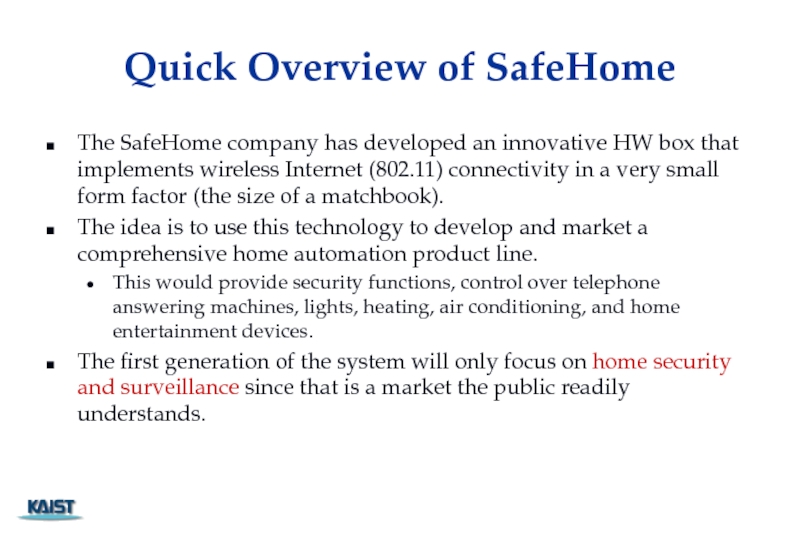

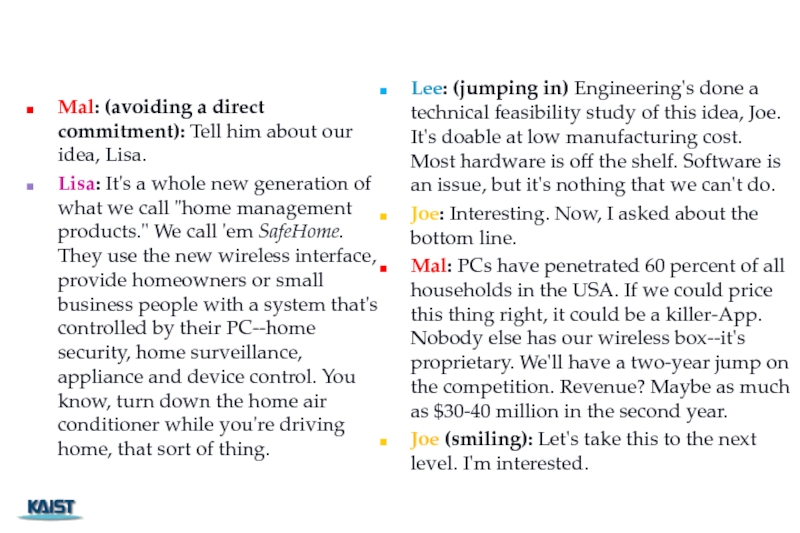
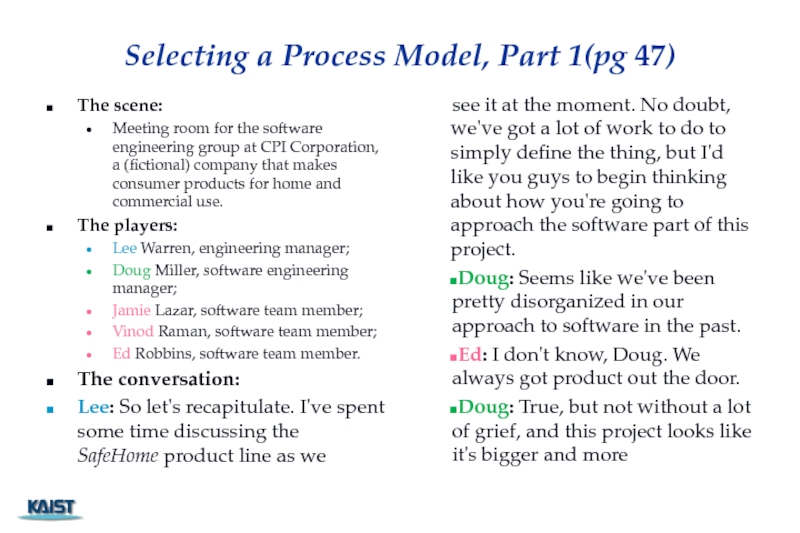
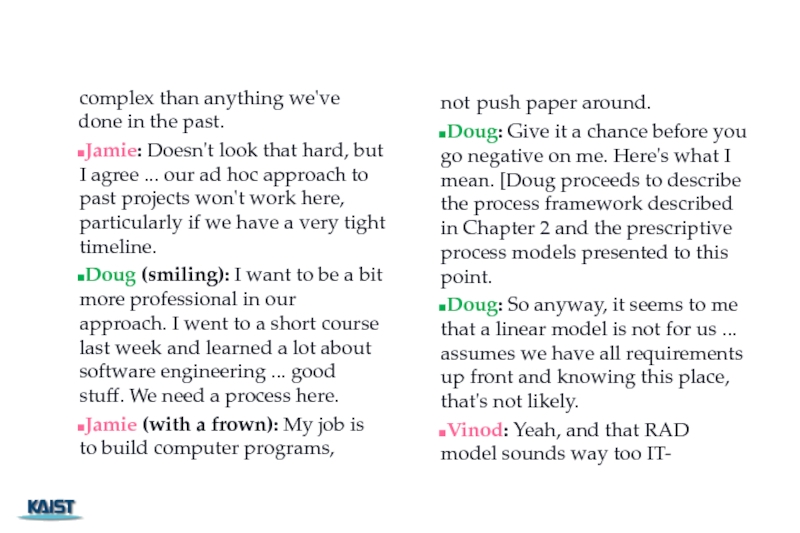

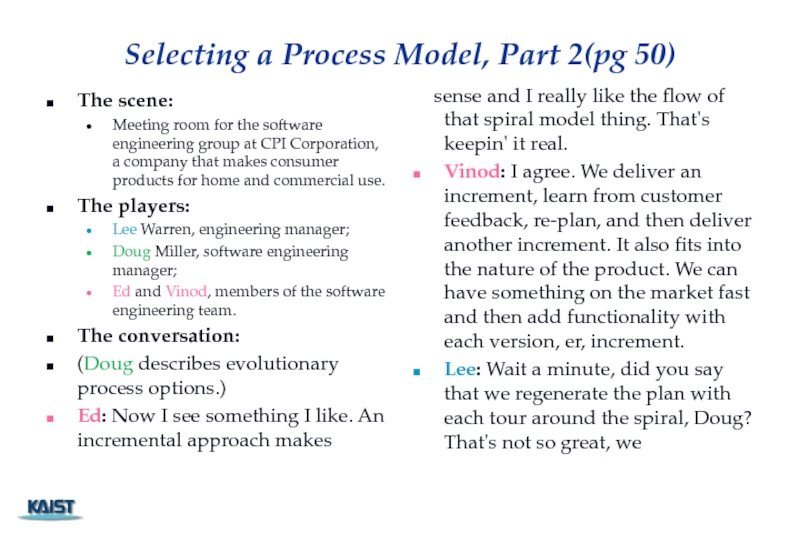
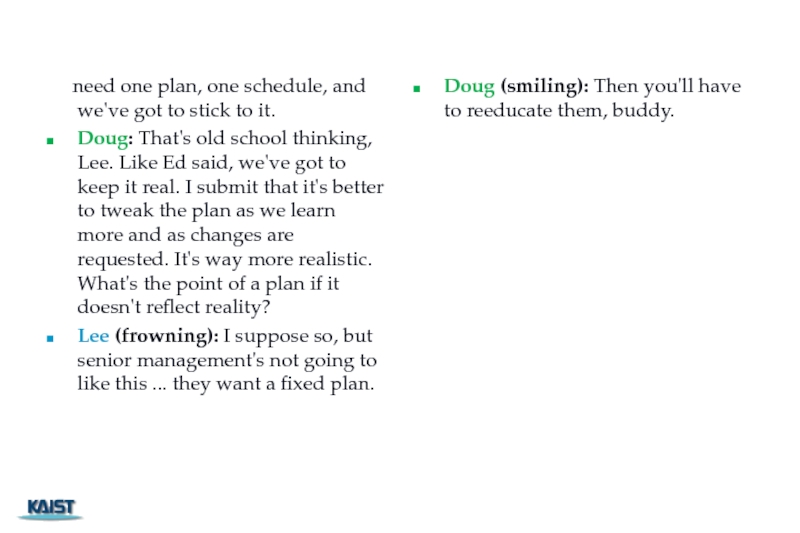
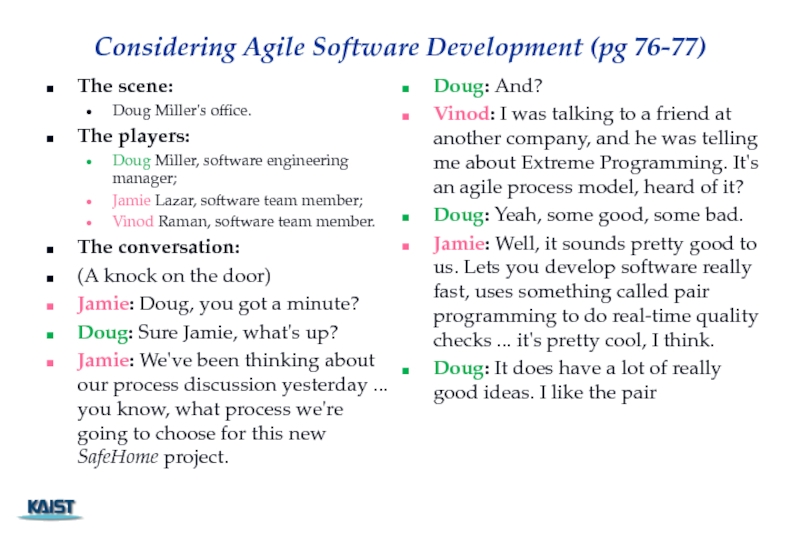

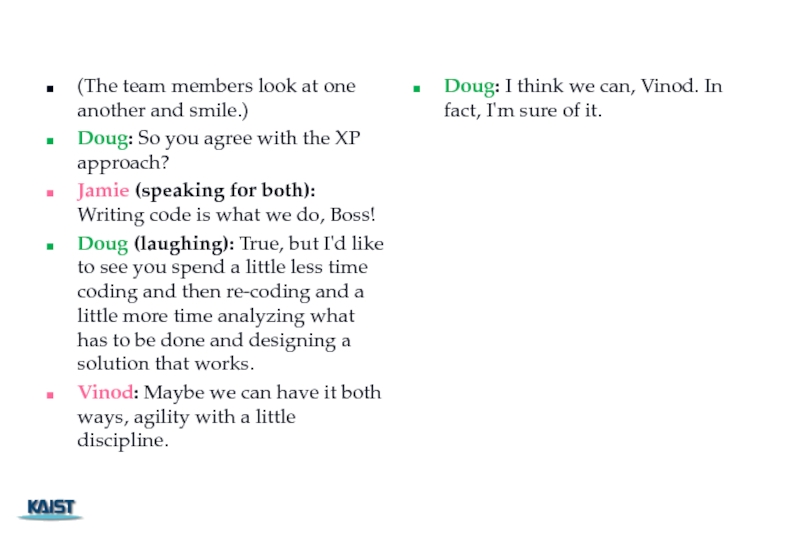
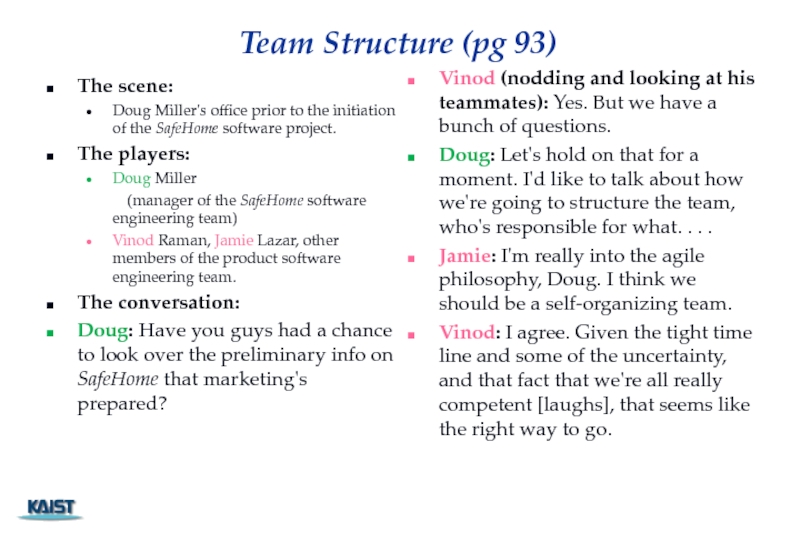
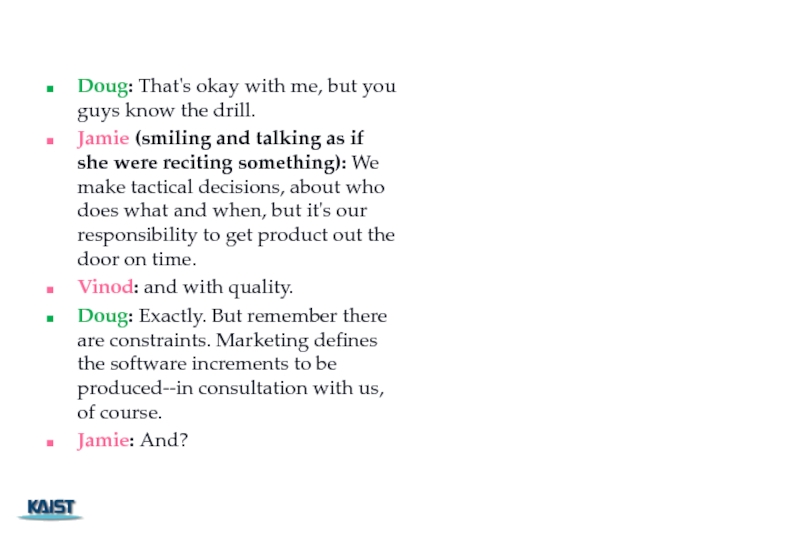
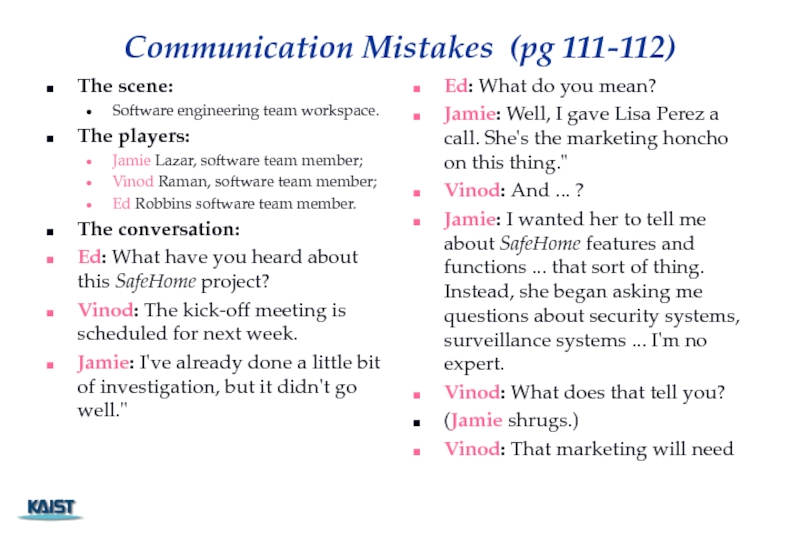
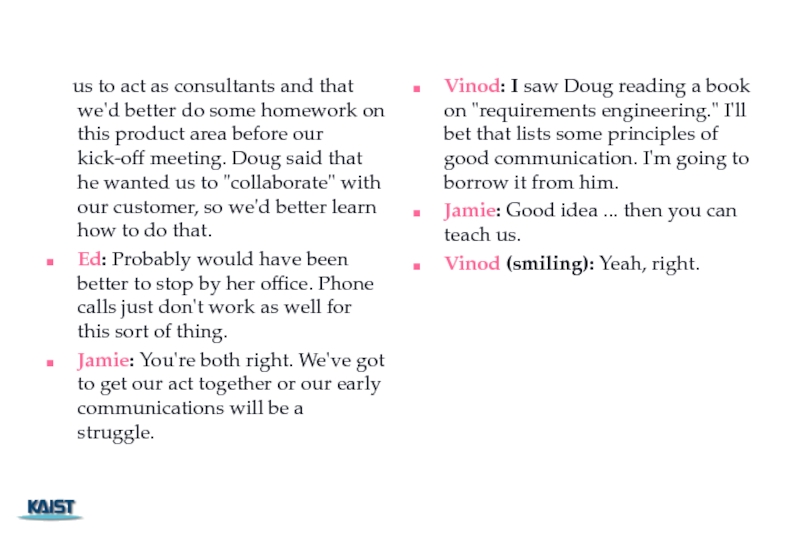
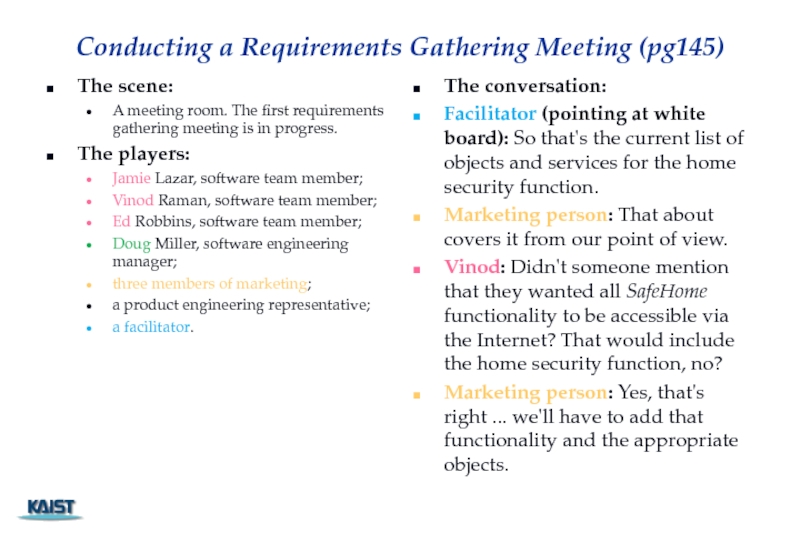
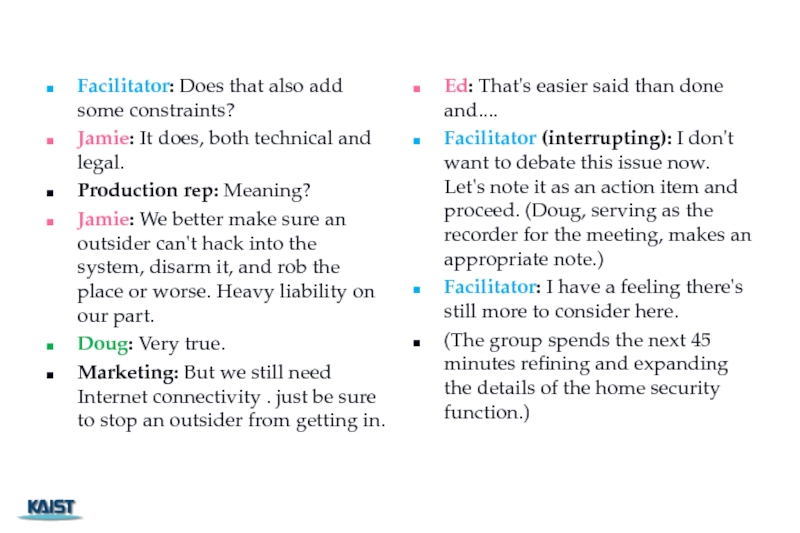
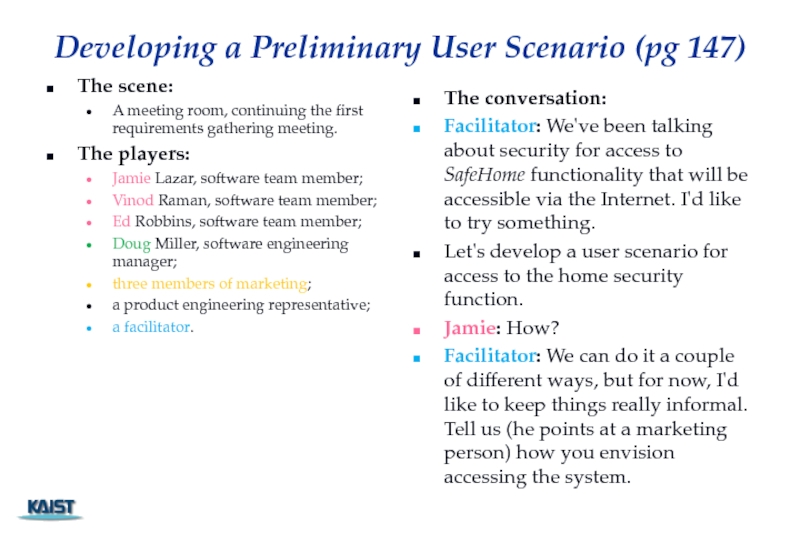
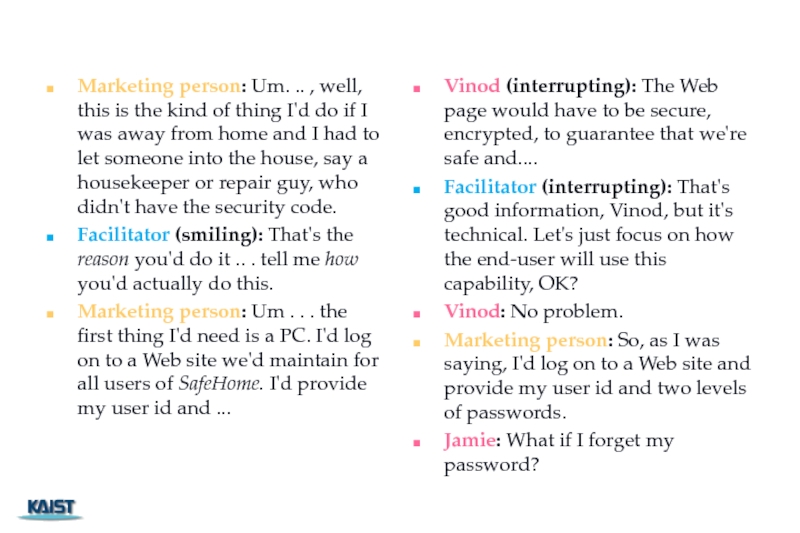
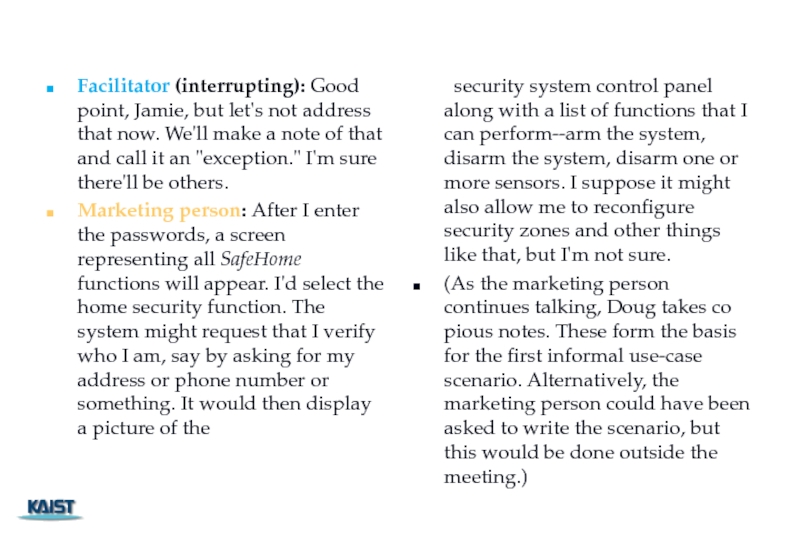
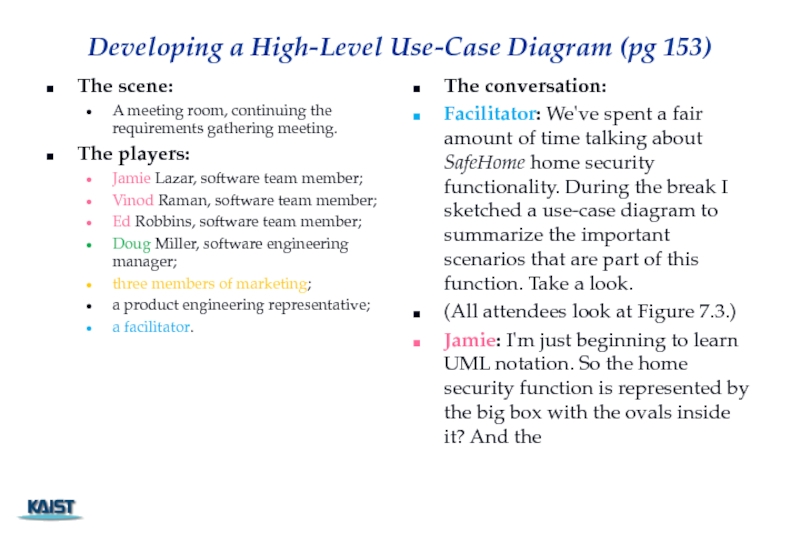
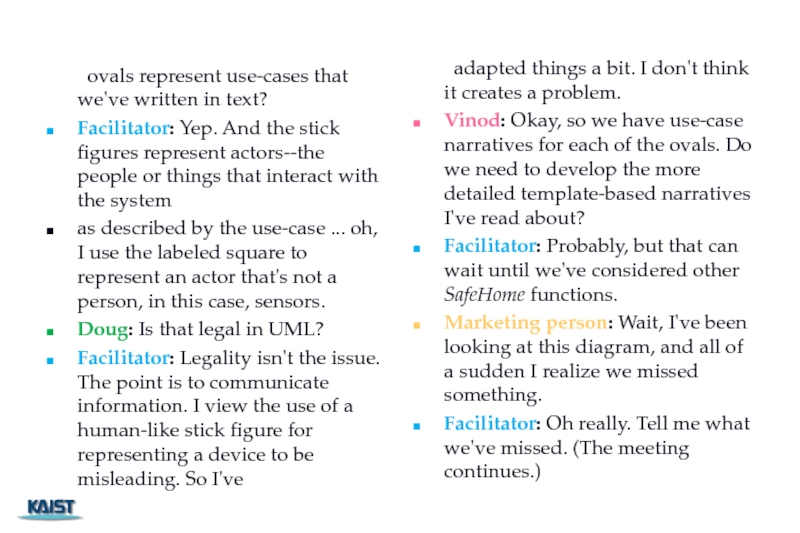
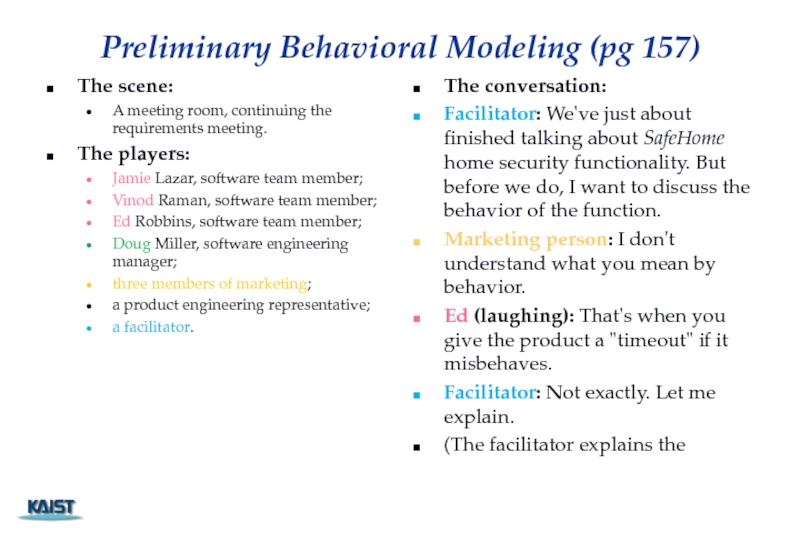
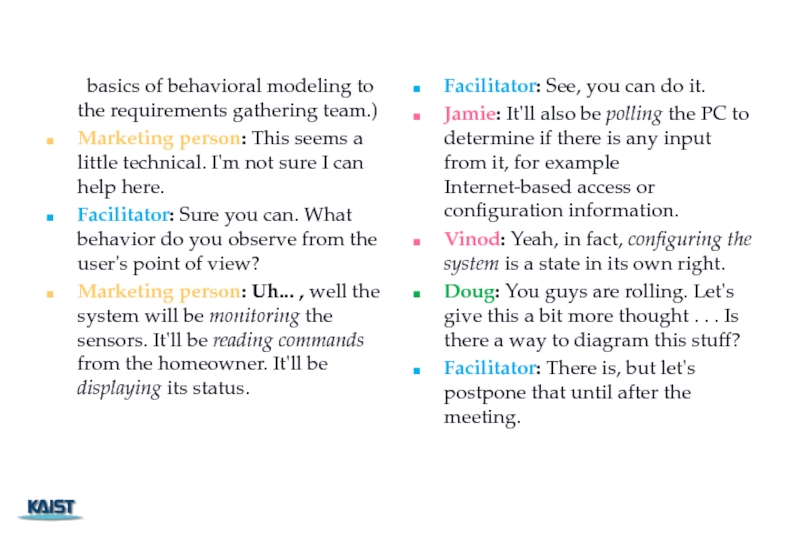
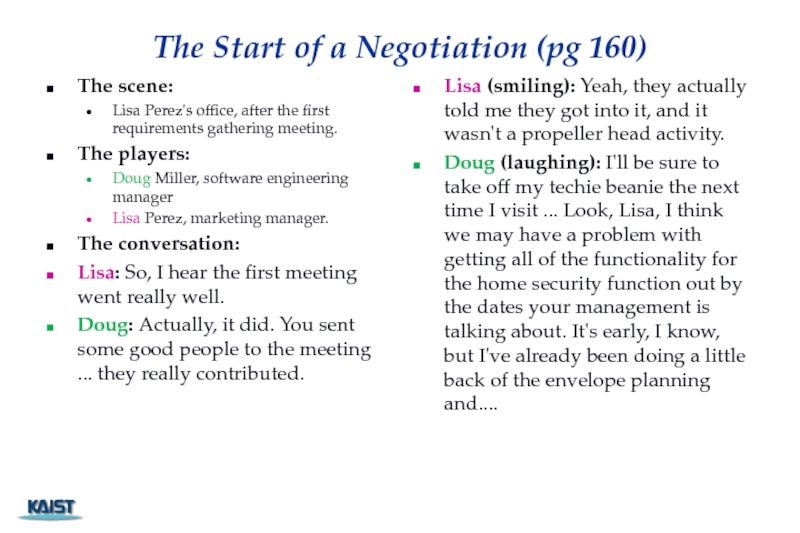
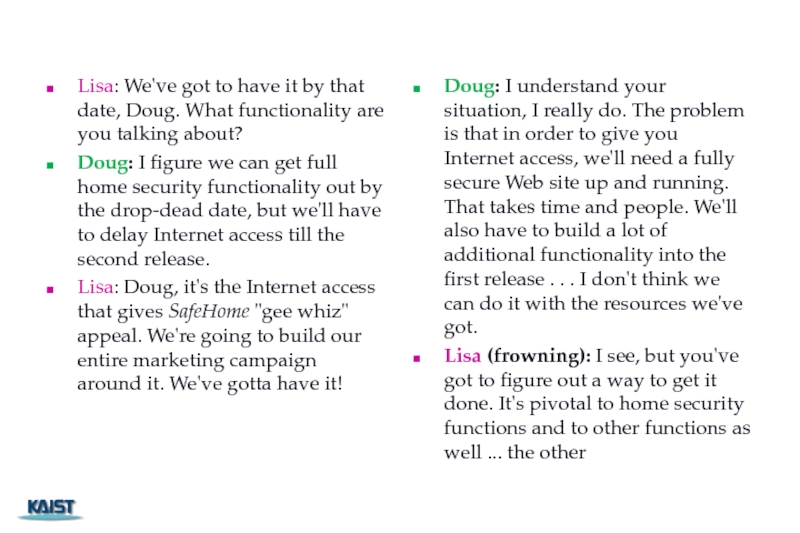
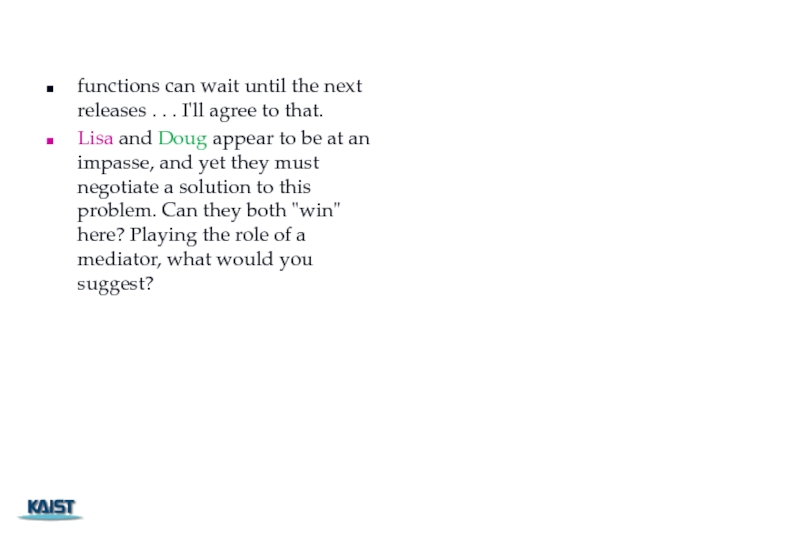
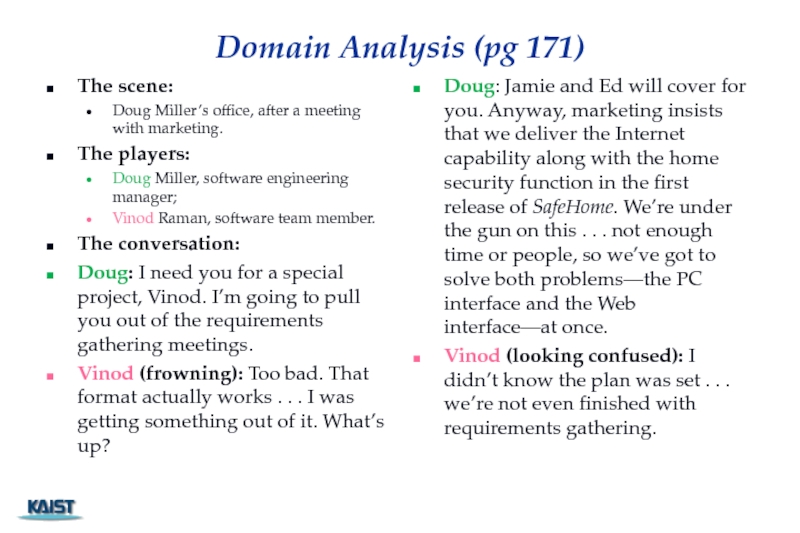
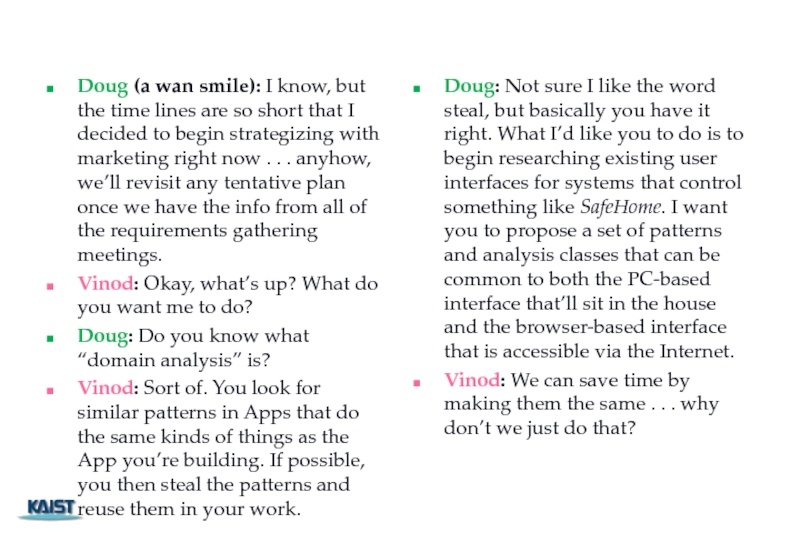
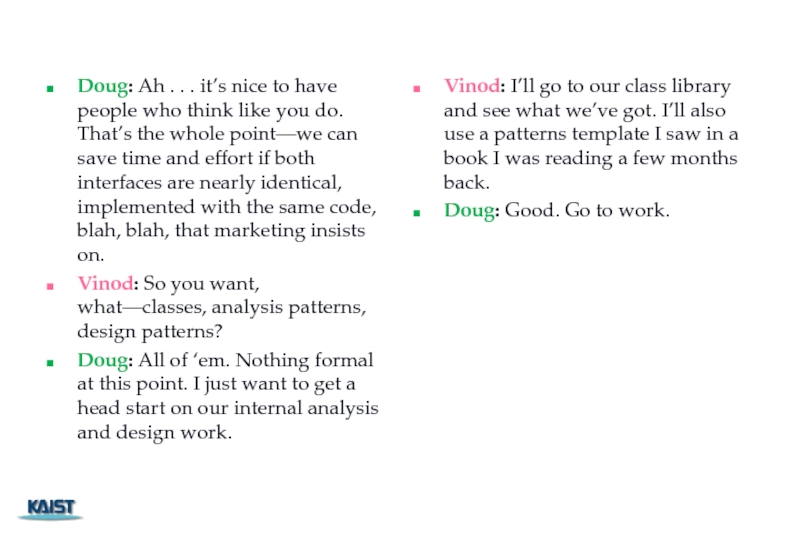
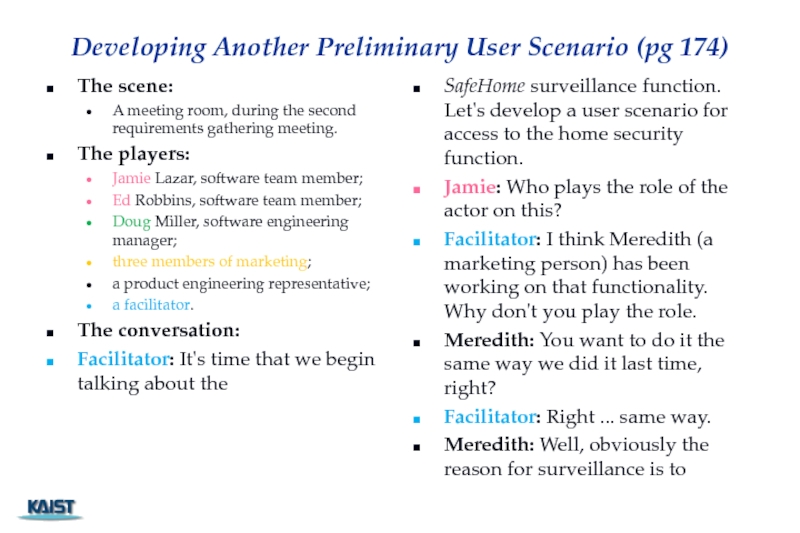
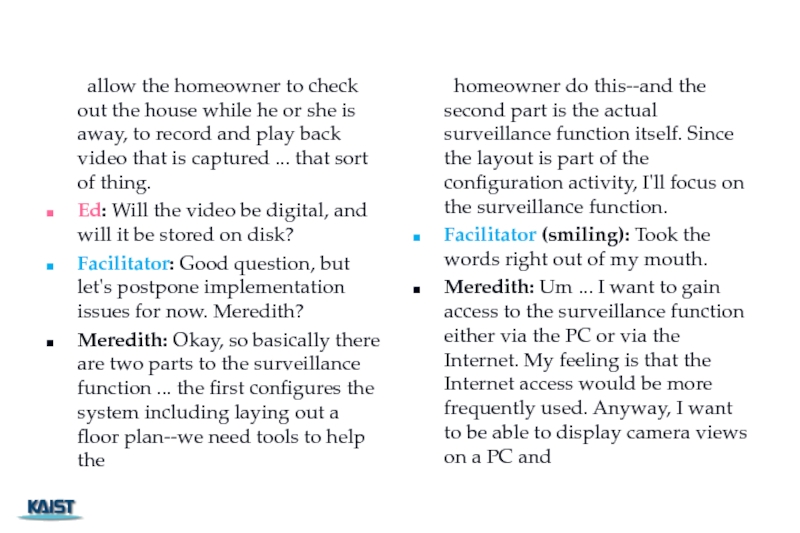
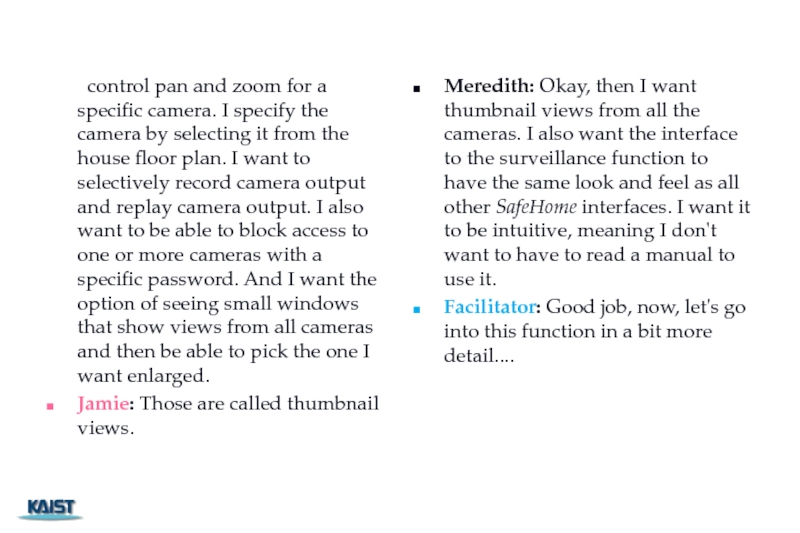
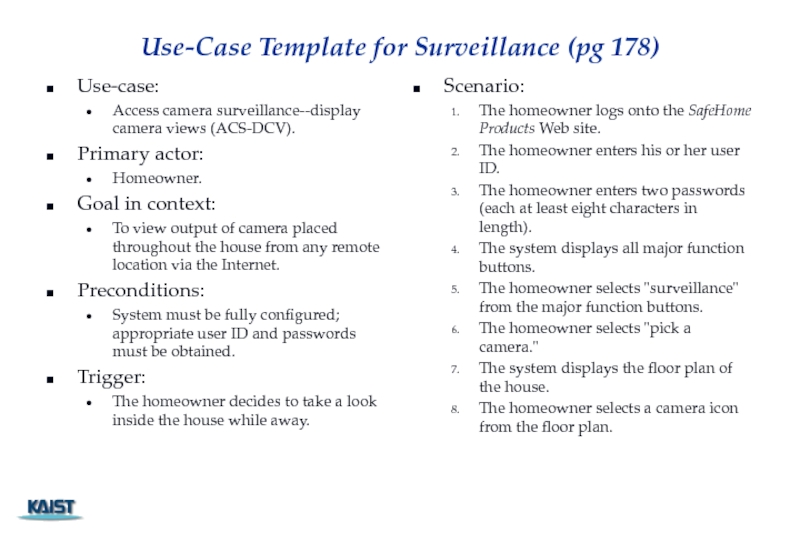
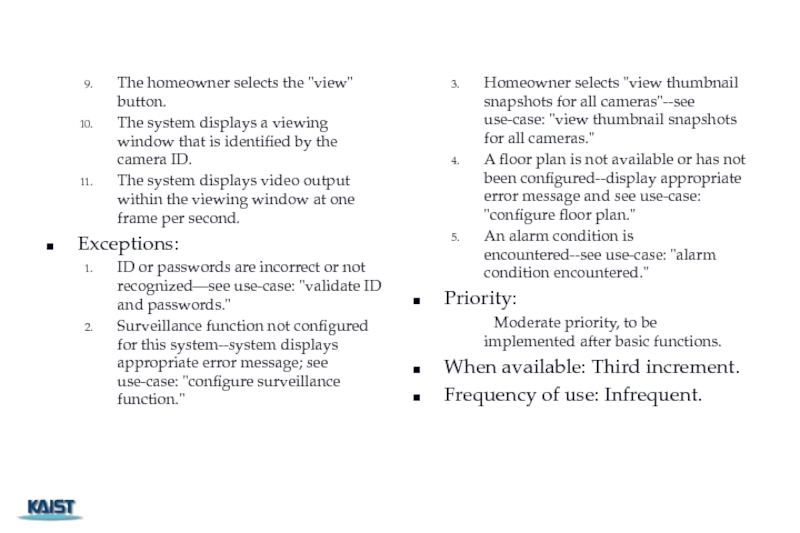
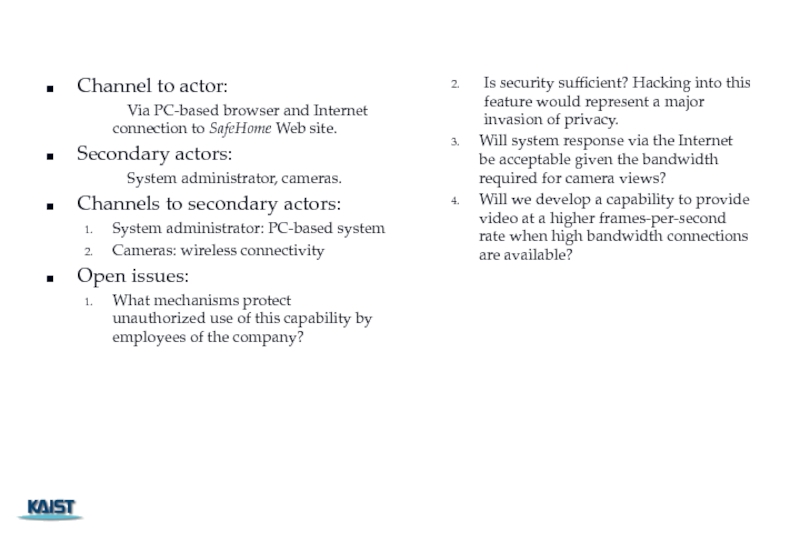
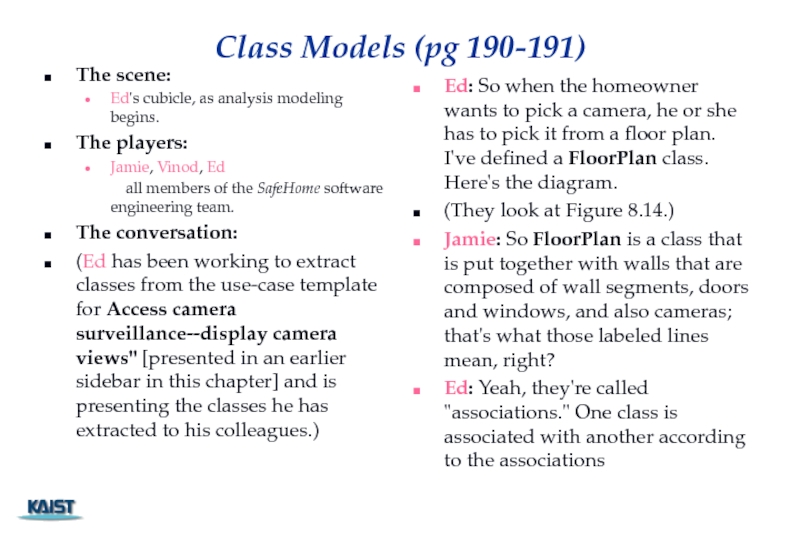
![I've shown. [Associations are discussed in Section 8.7.5.]Vinod: So the actual floor plan is made](/img/tmb/4/390515/0883488022e763dcbe5f6e3979464f5a-800x.jpg)

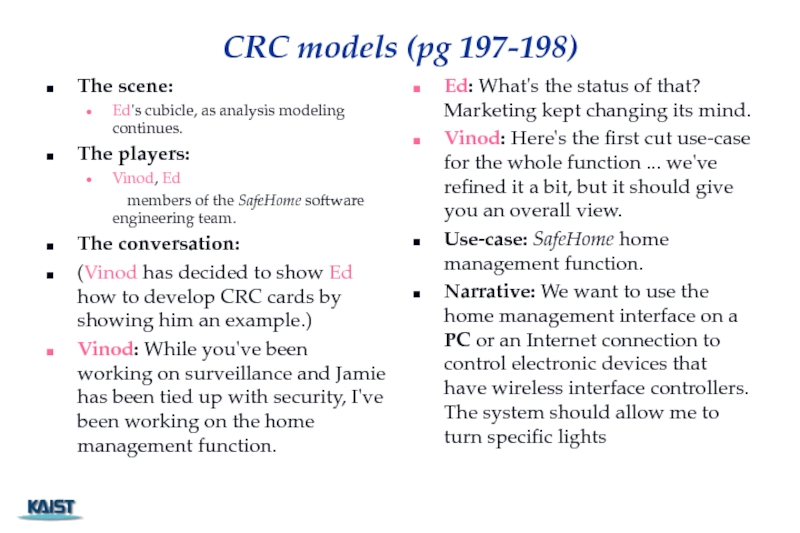
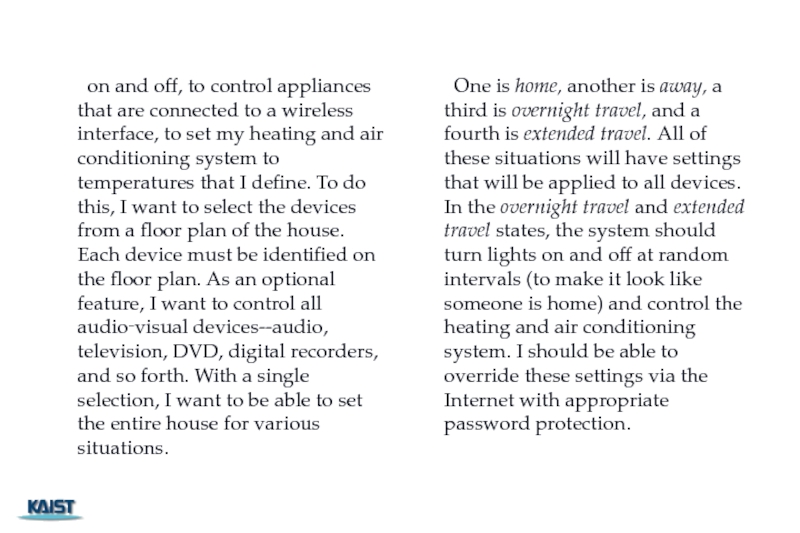
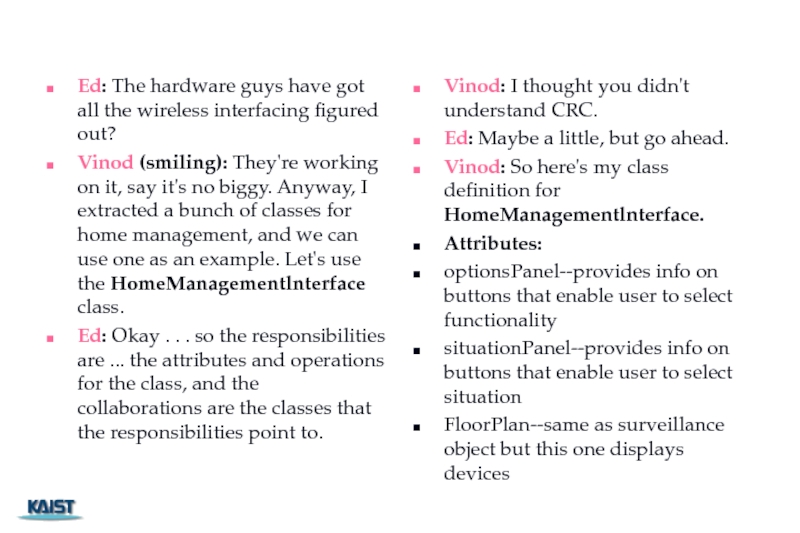
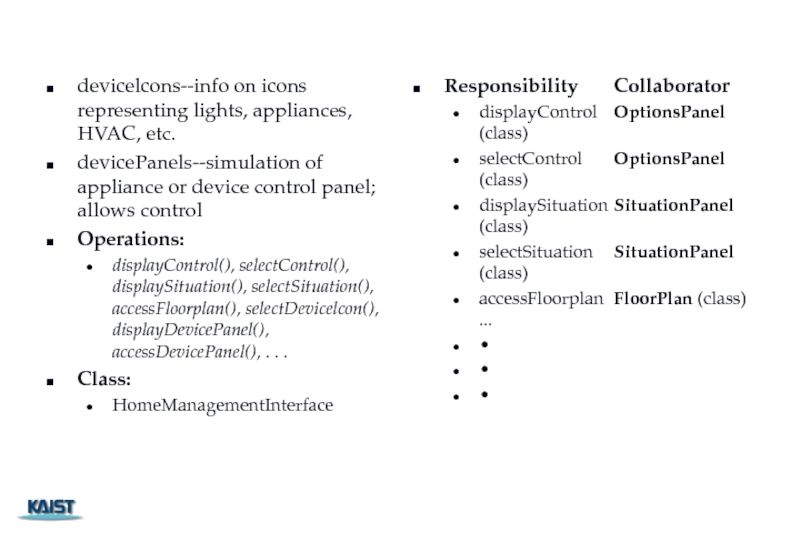
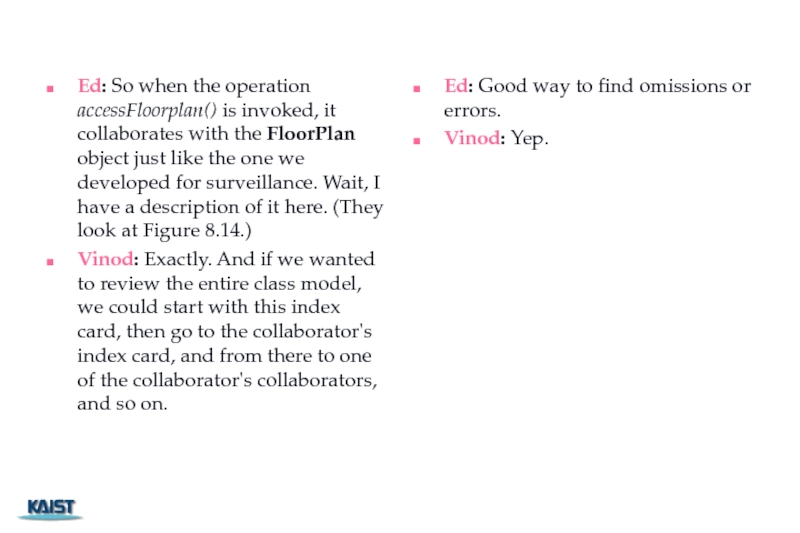
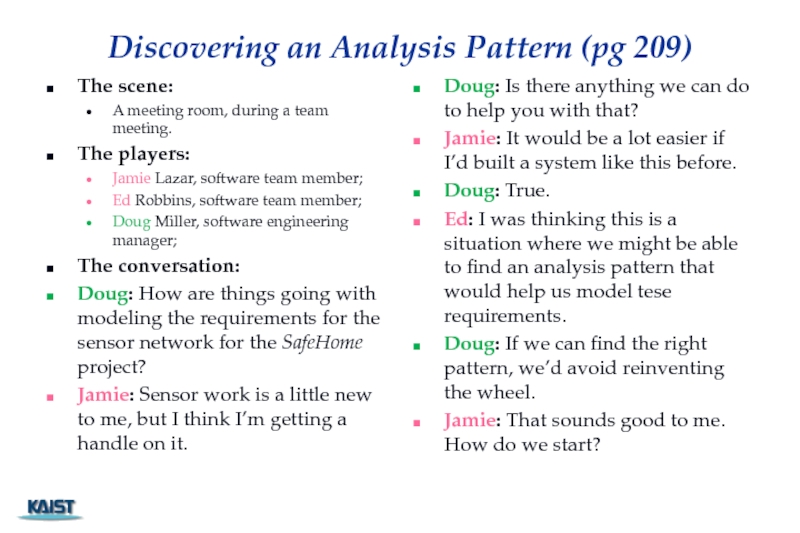
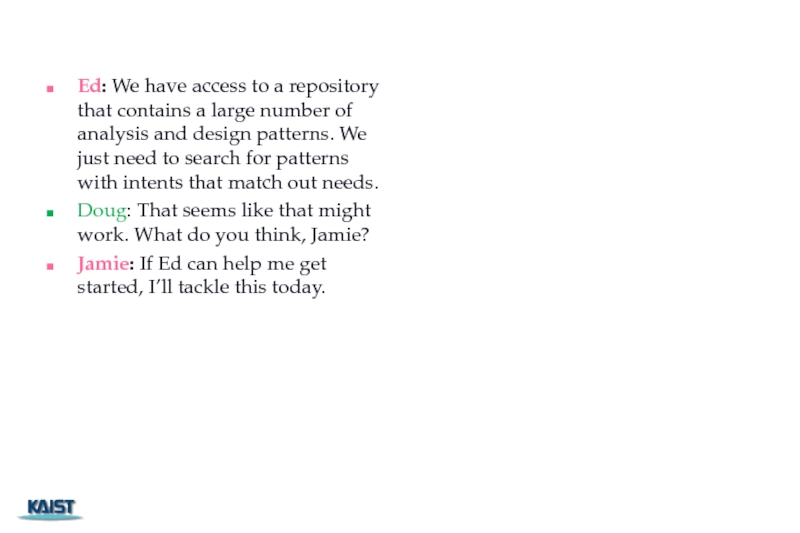
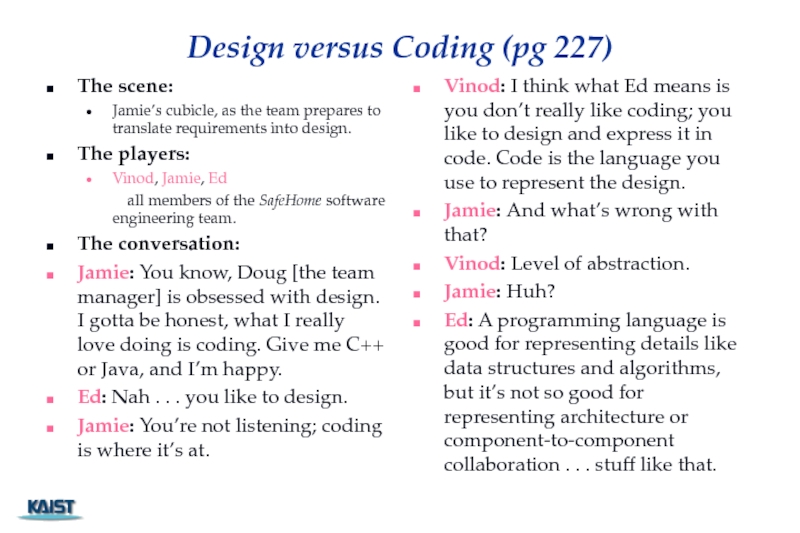
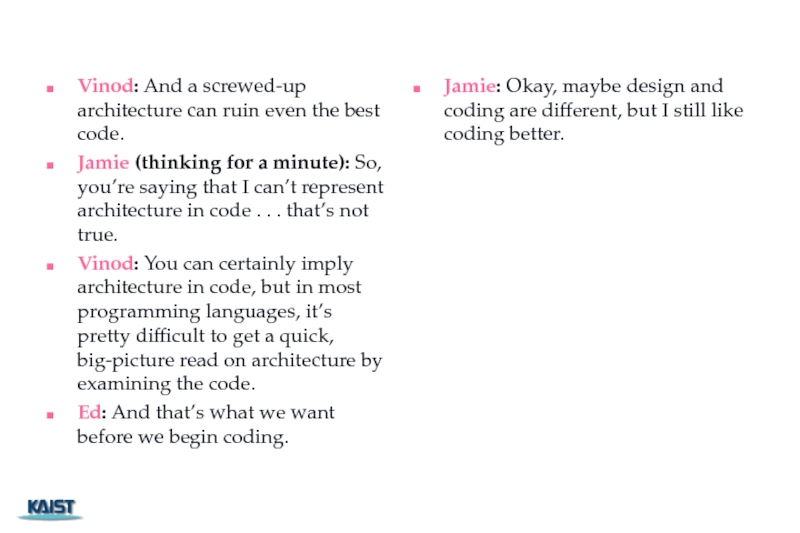
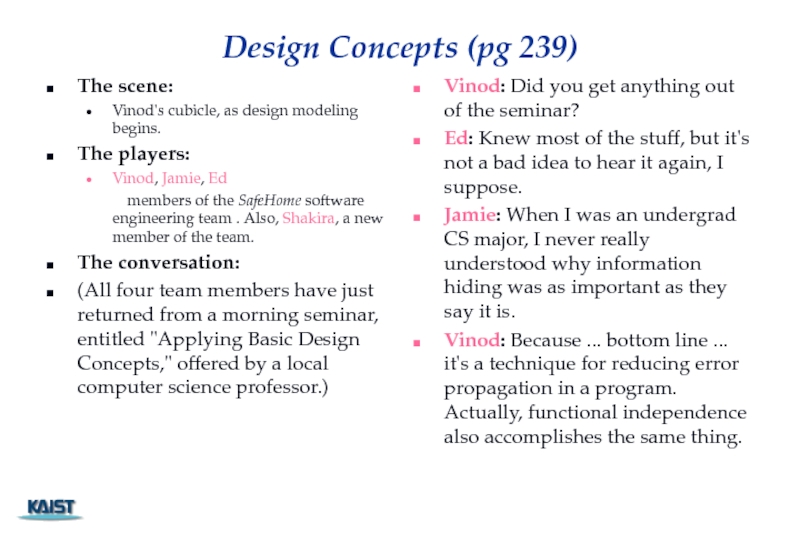

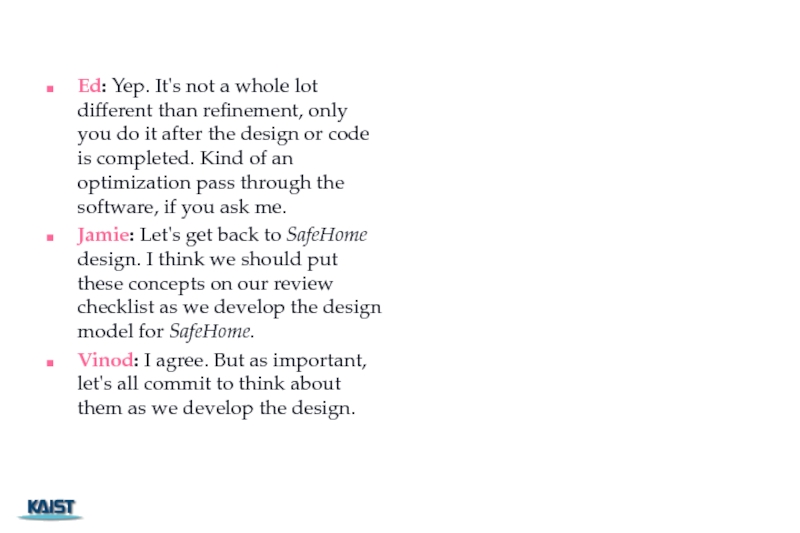
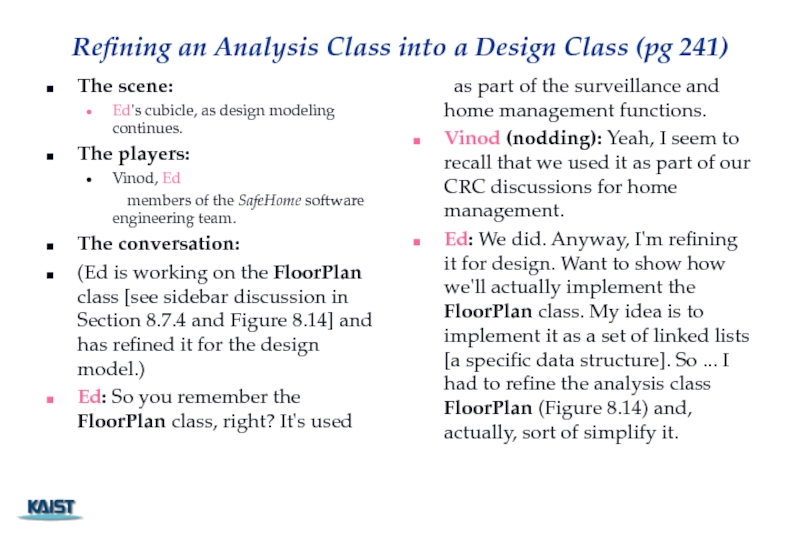
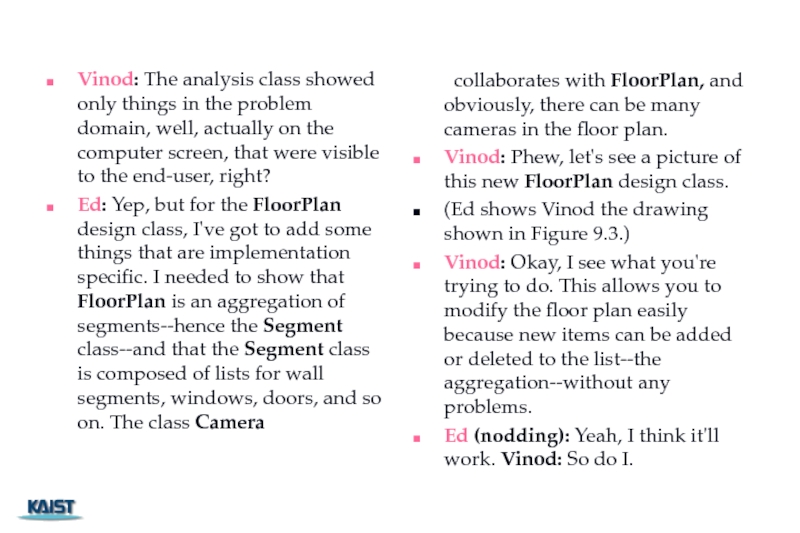
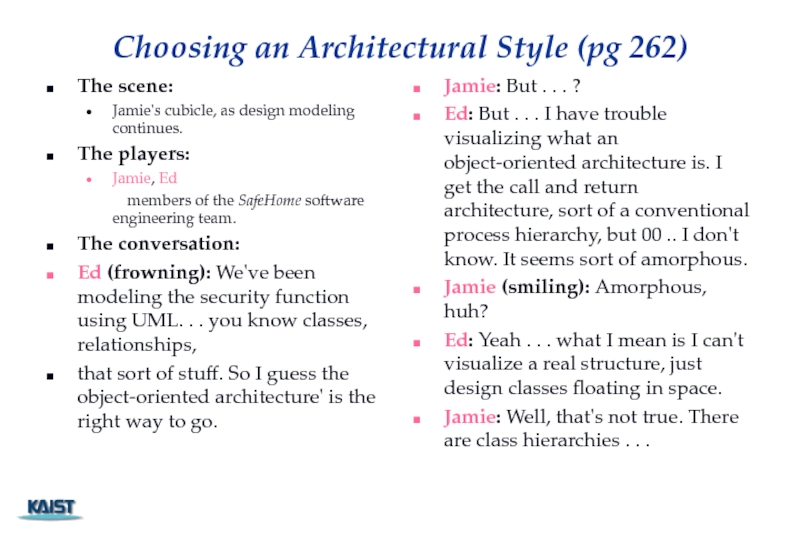
![think of the hierarchy (aggregation) we did for the FloorPlan object [Figure 9.3]. An 00](/img/tmb/4/390515/a385124c664b91216b104d85aae442ee-800x.jpg)
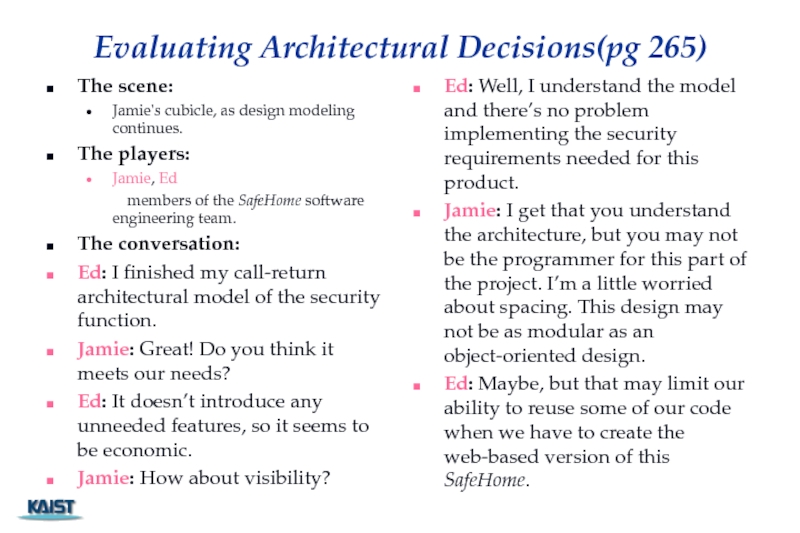
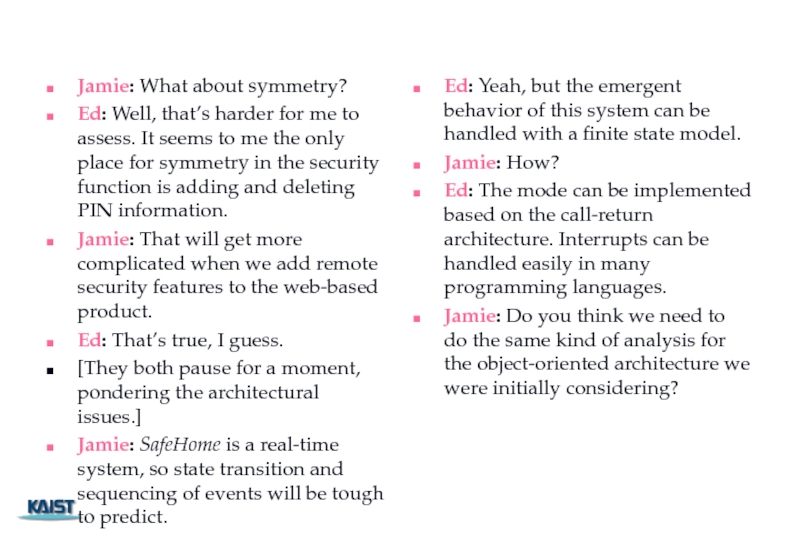
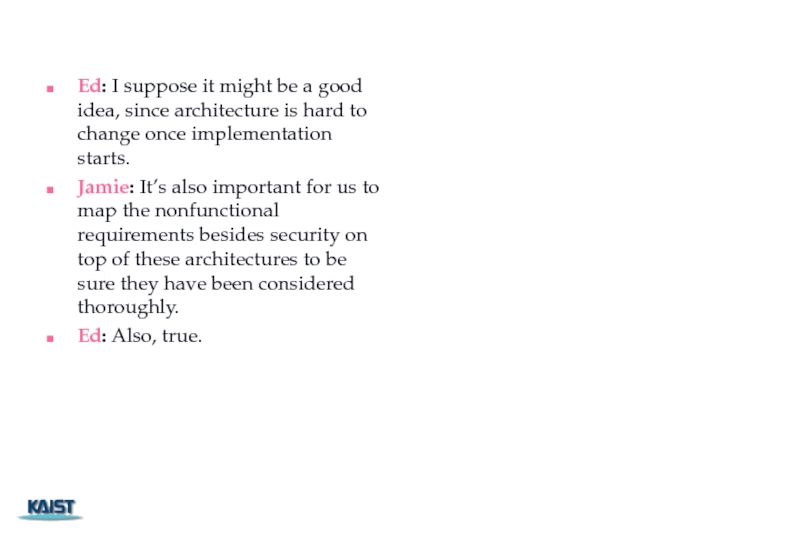
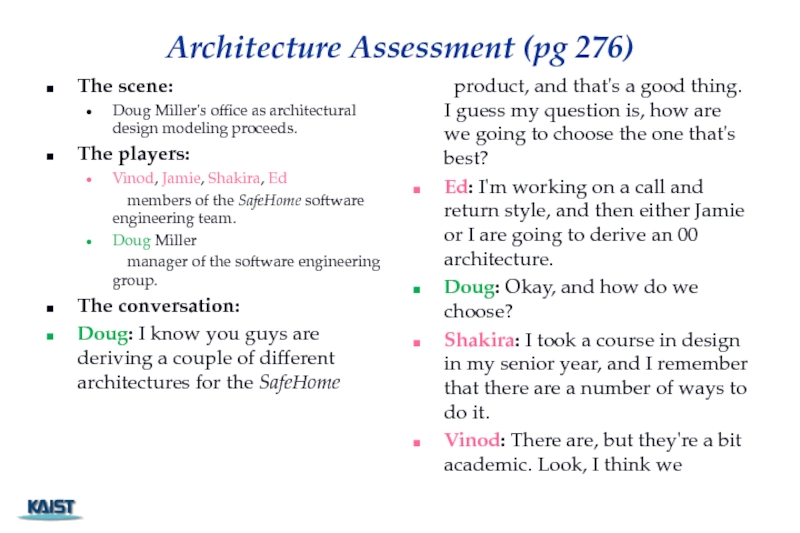
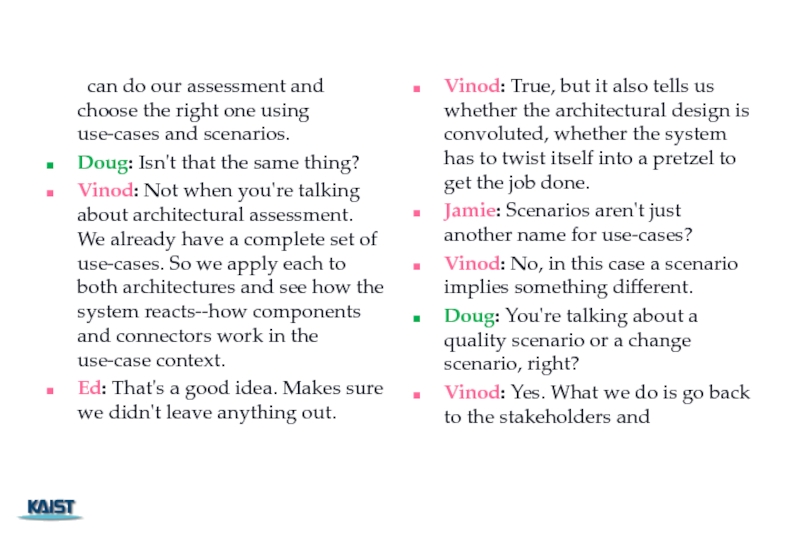
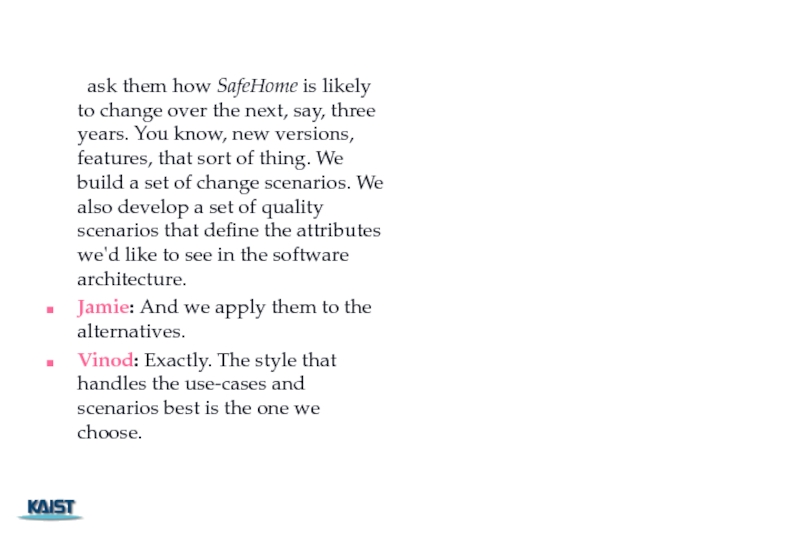
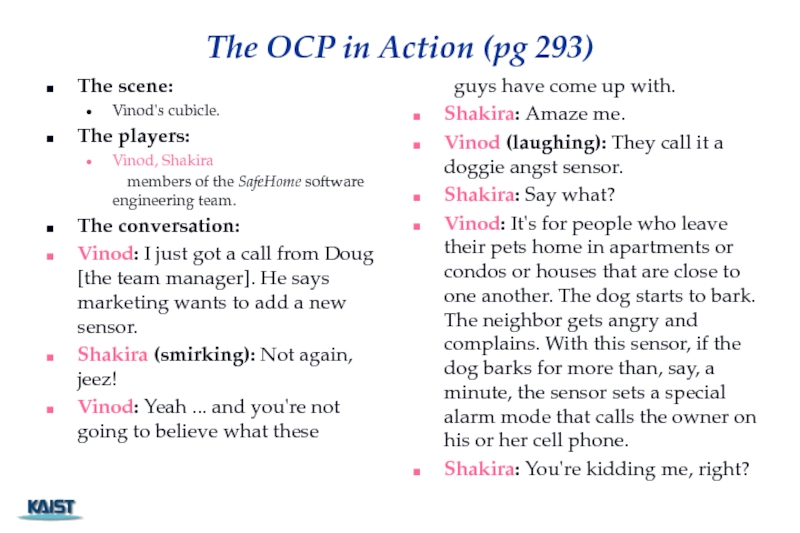
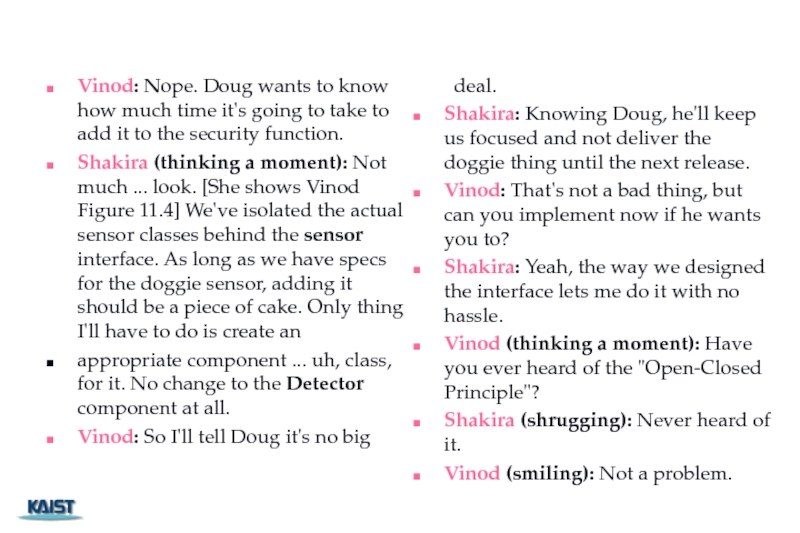
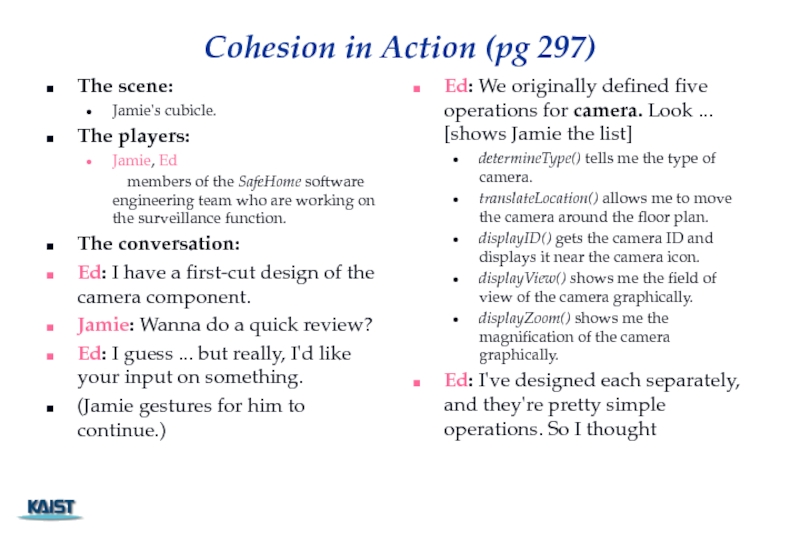
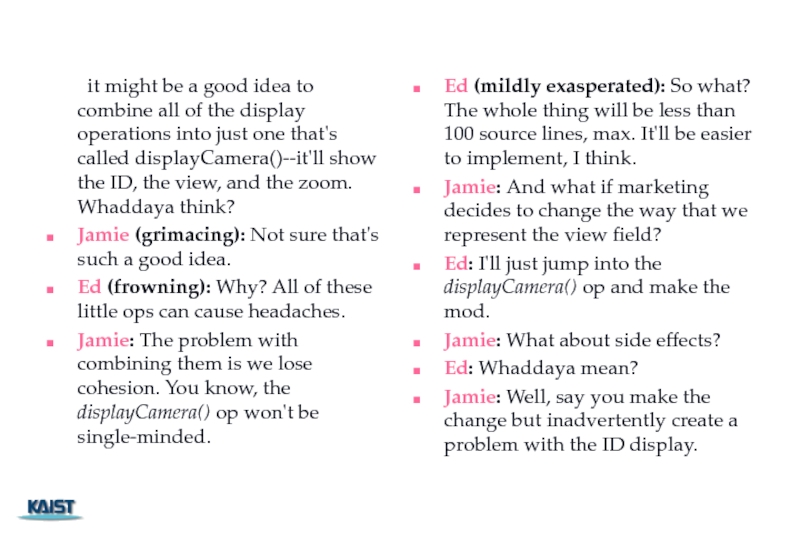

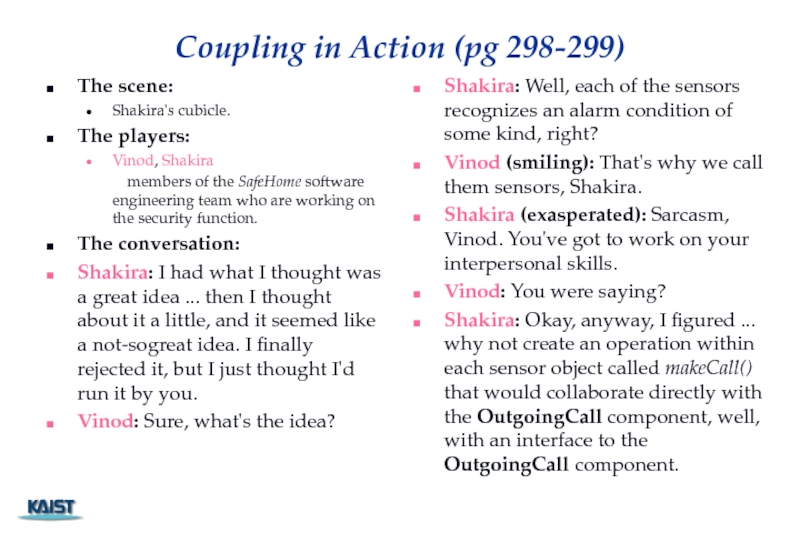
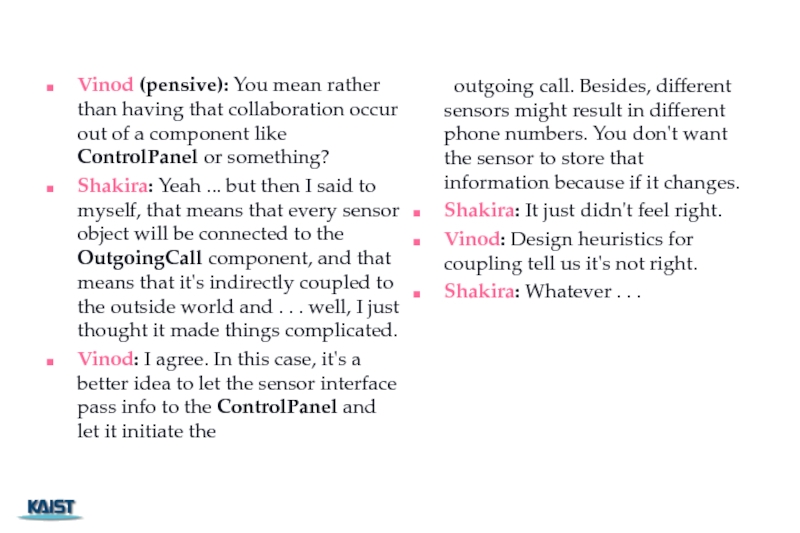
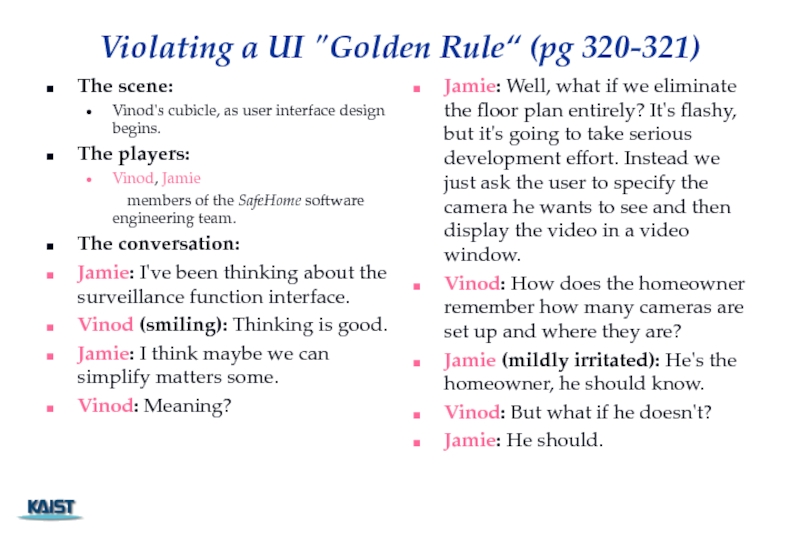
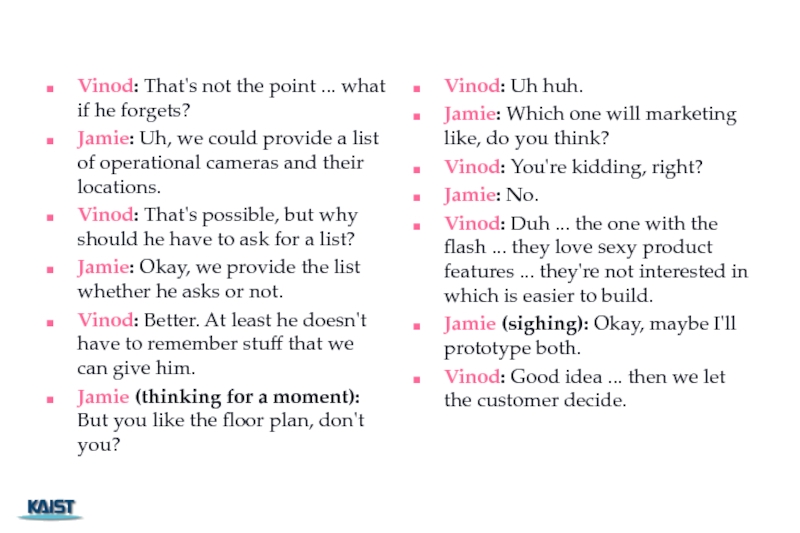
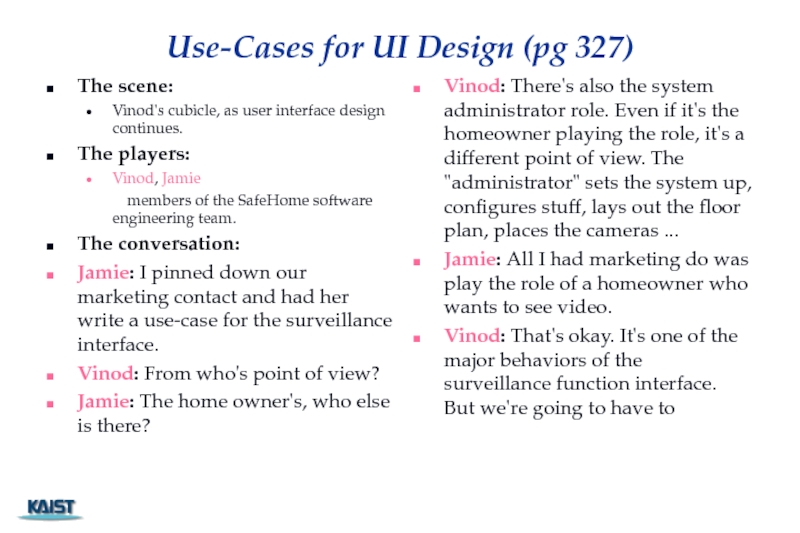
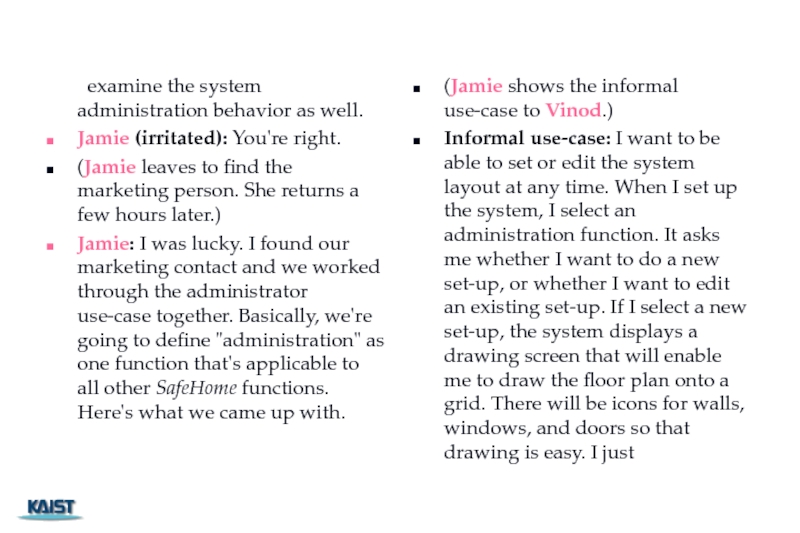
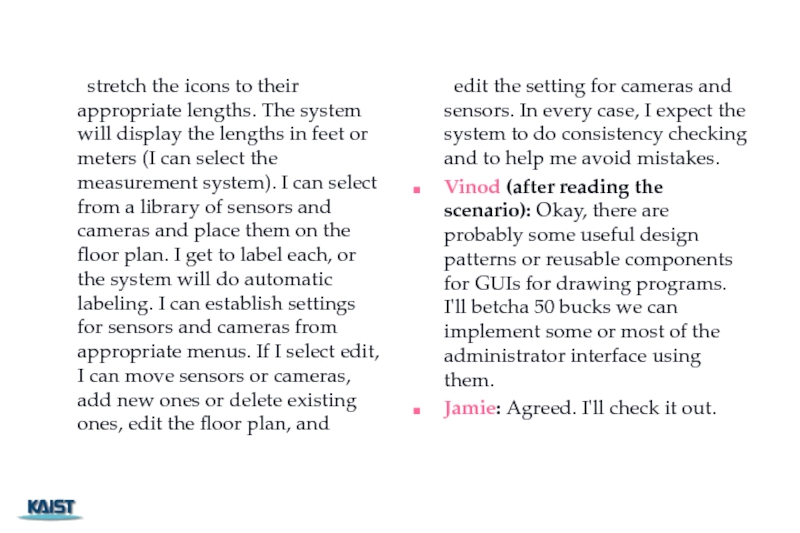
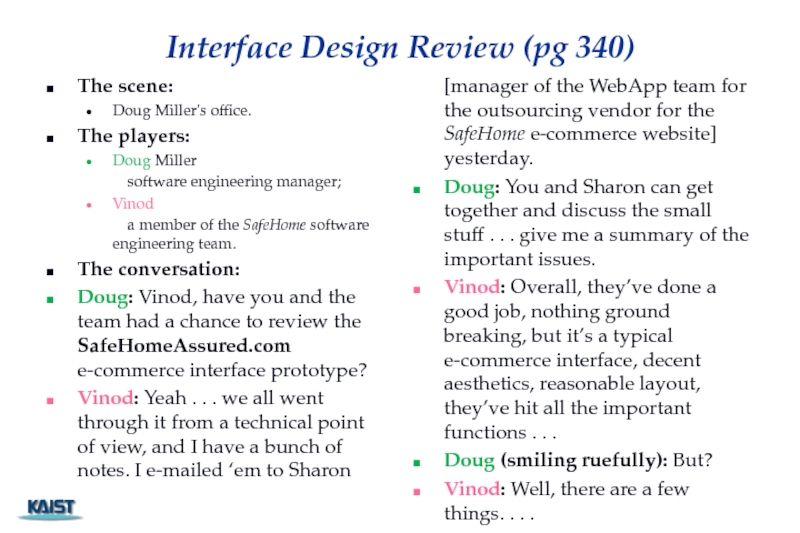
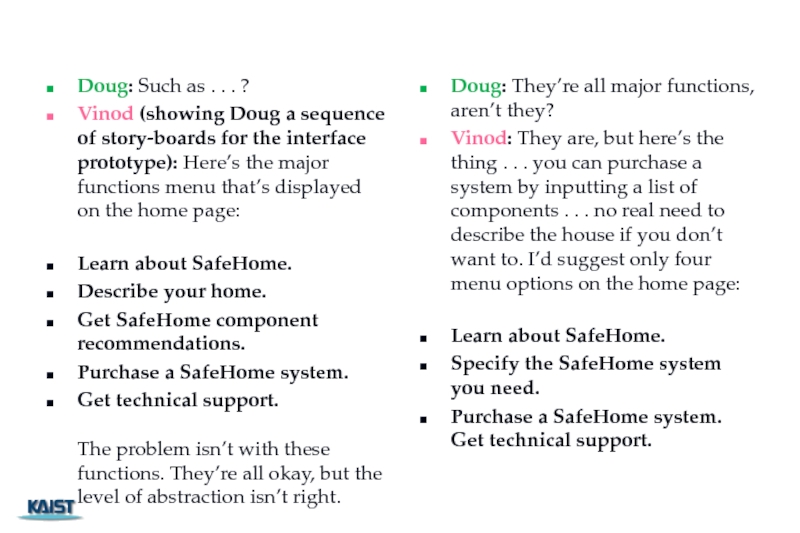
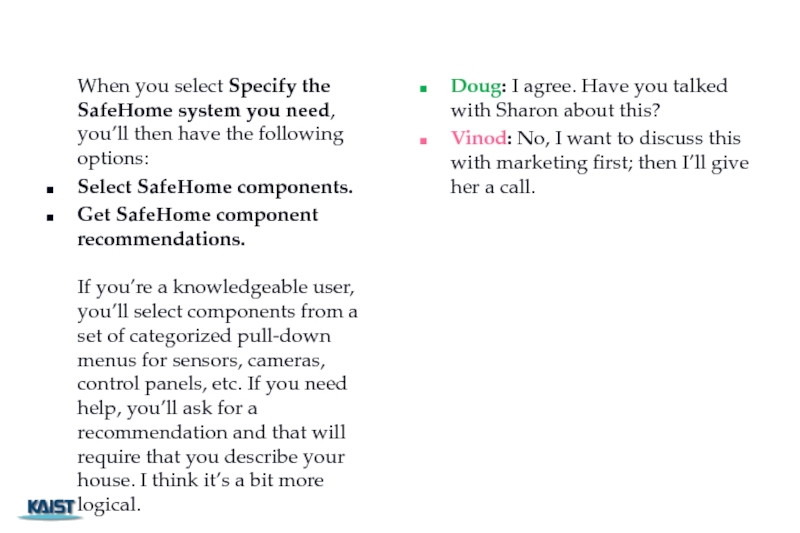
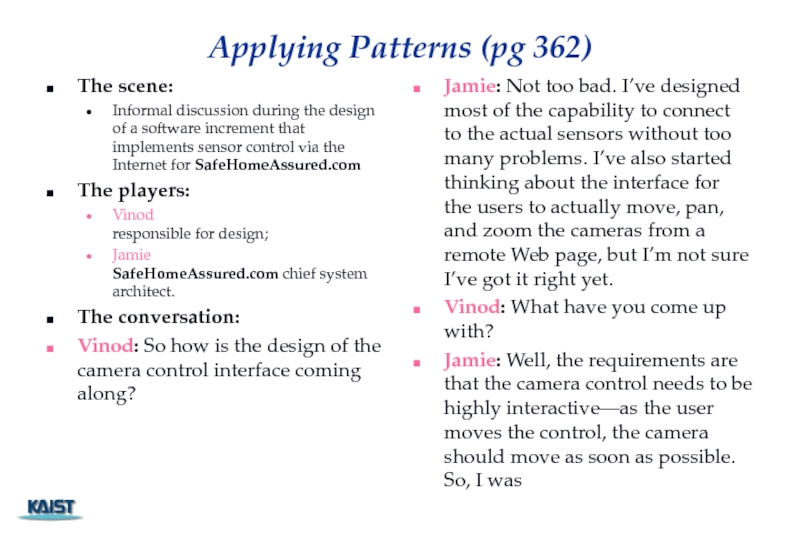
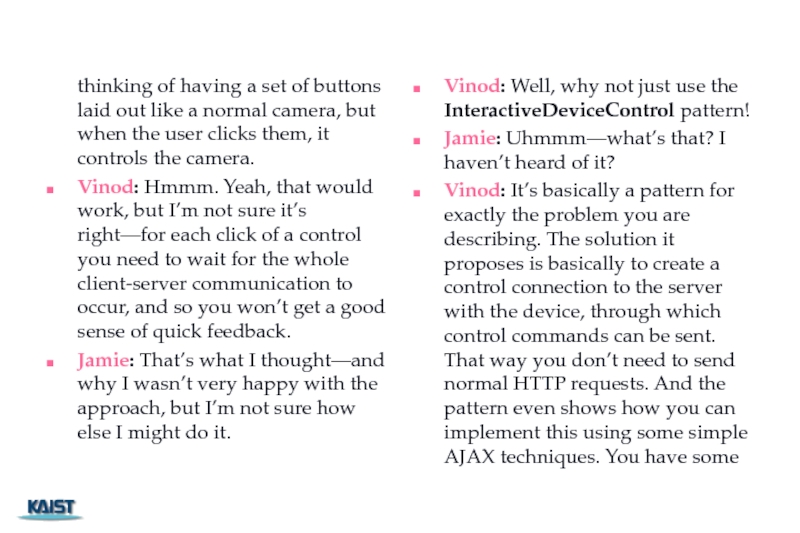
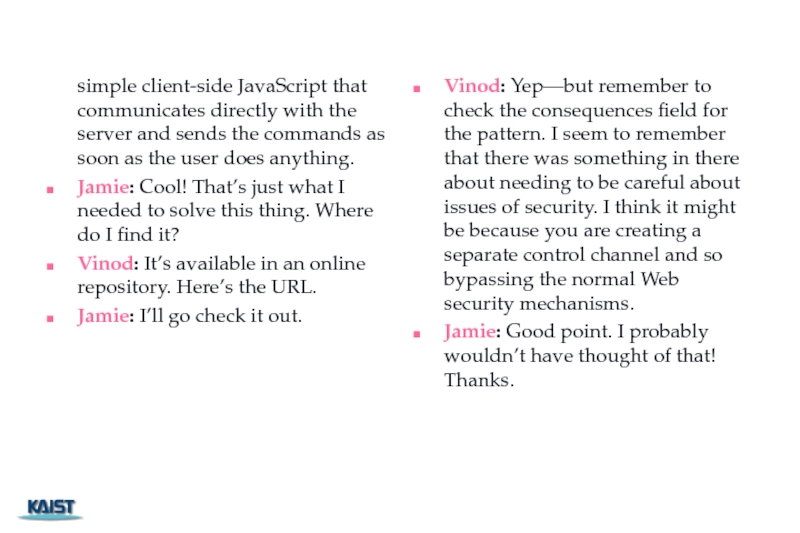
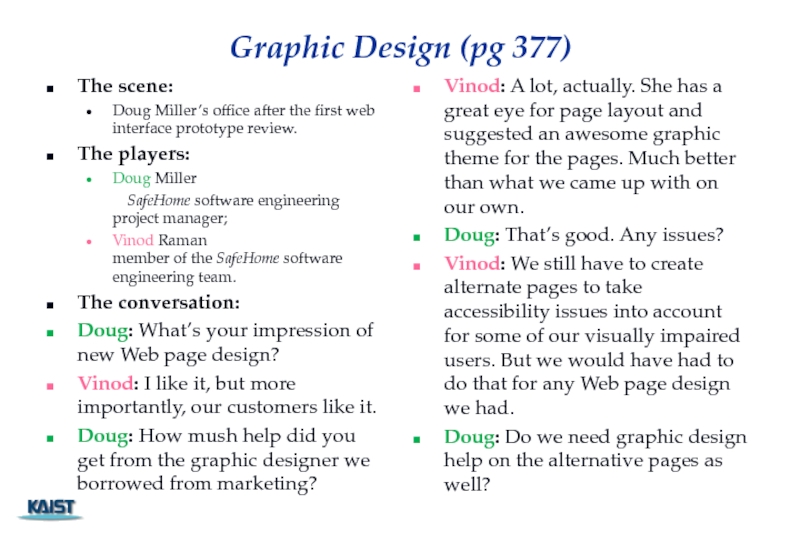
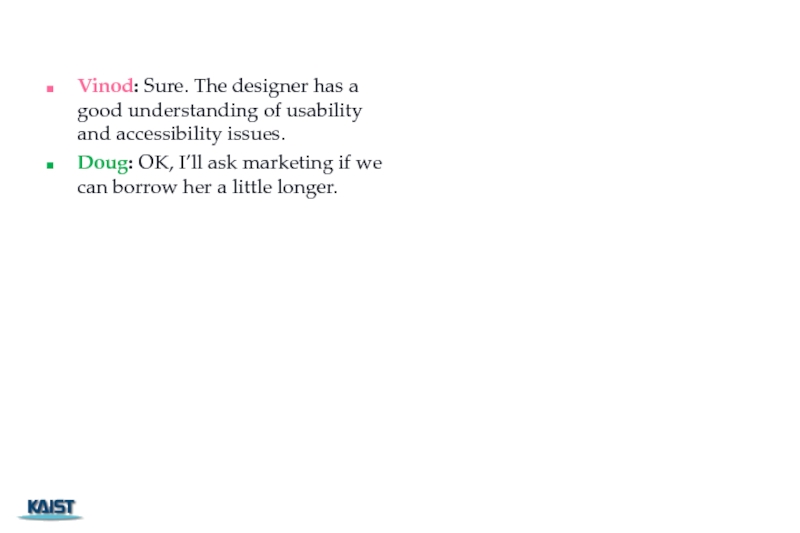
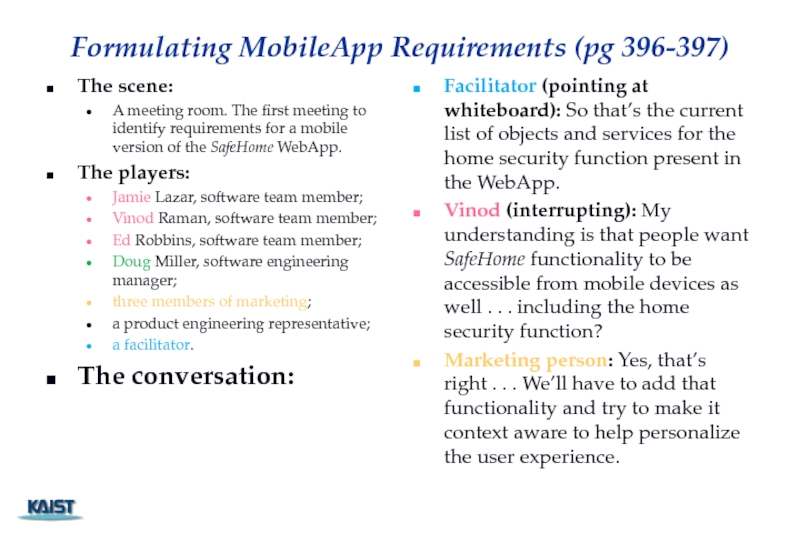
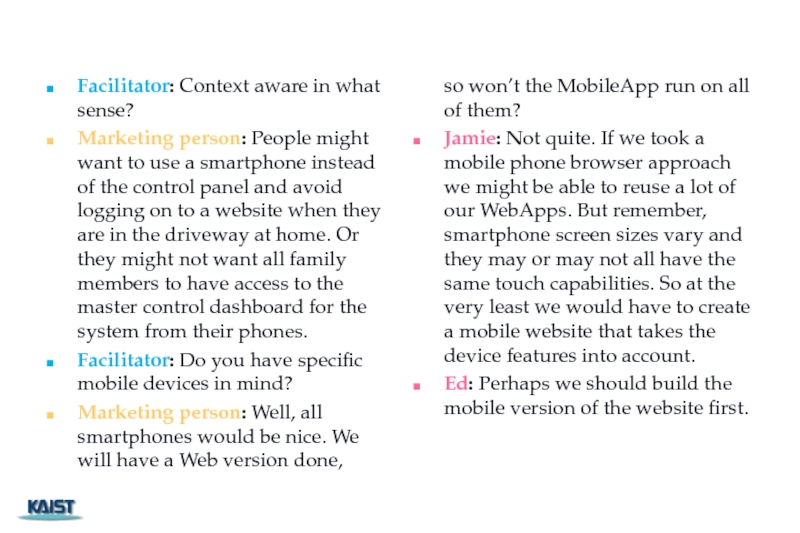
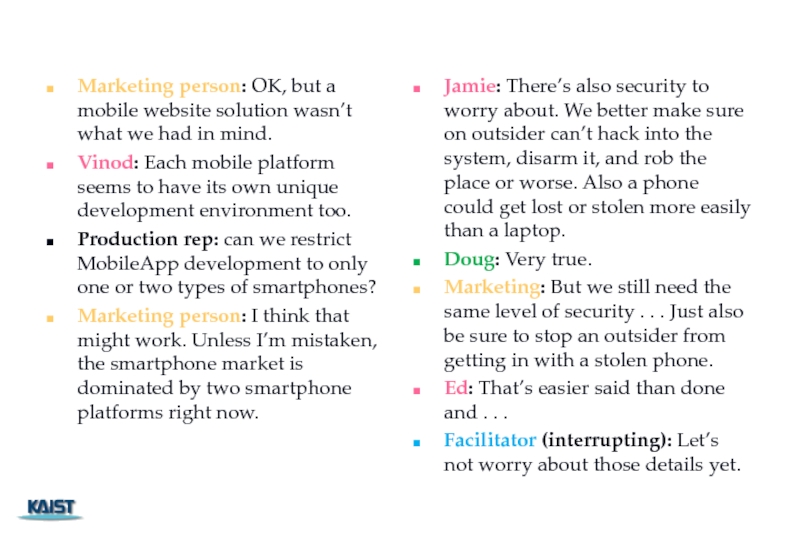
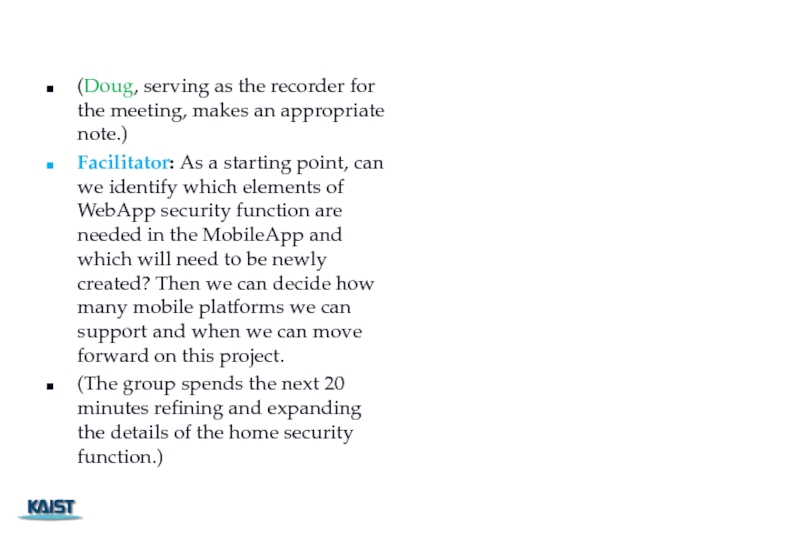
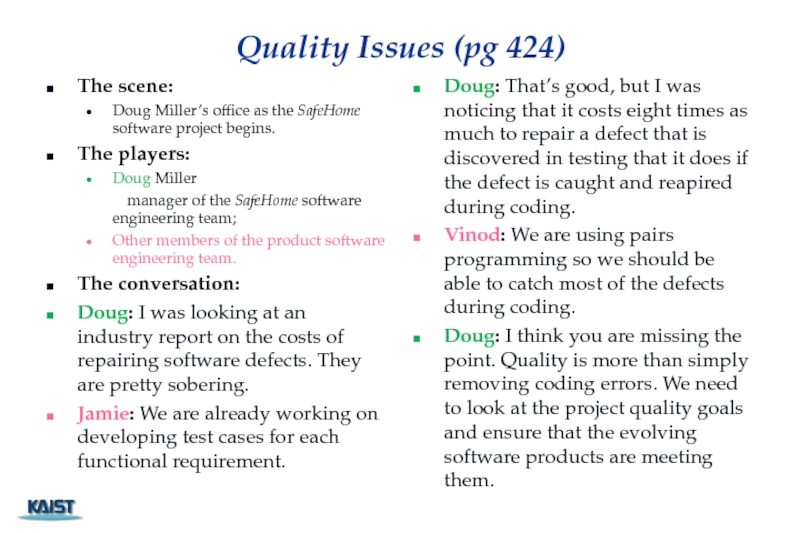
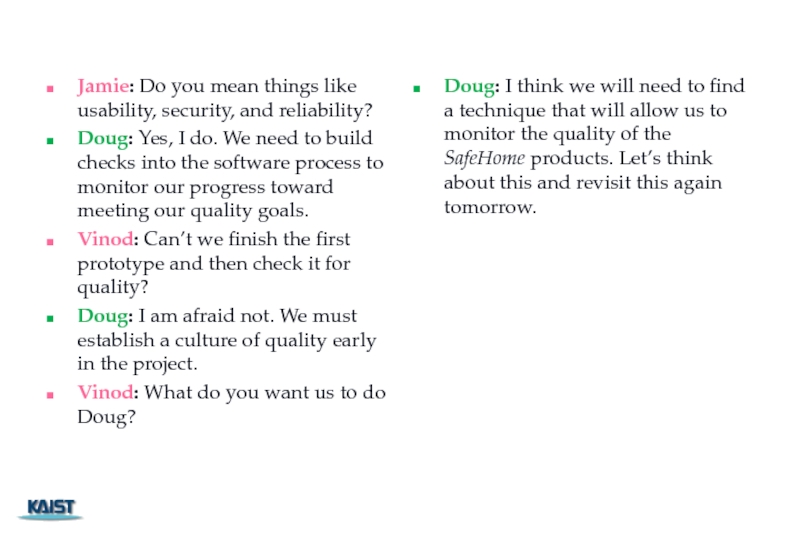
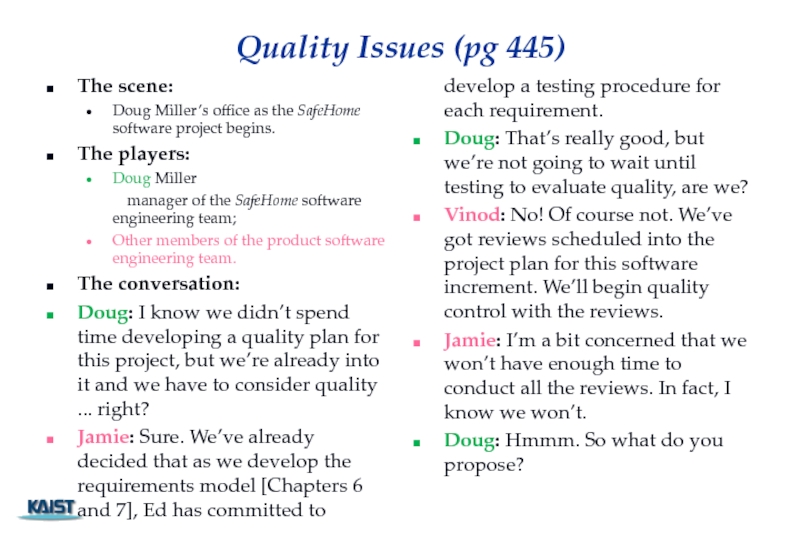
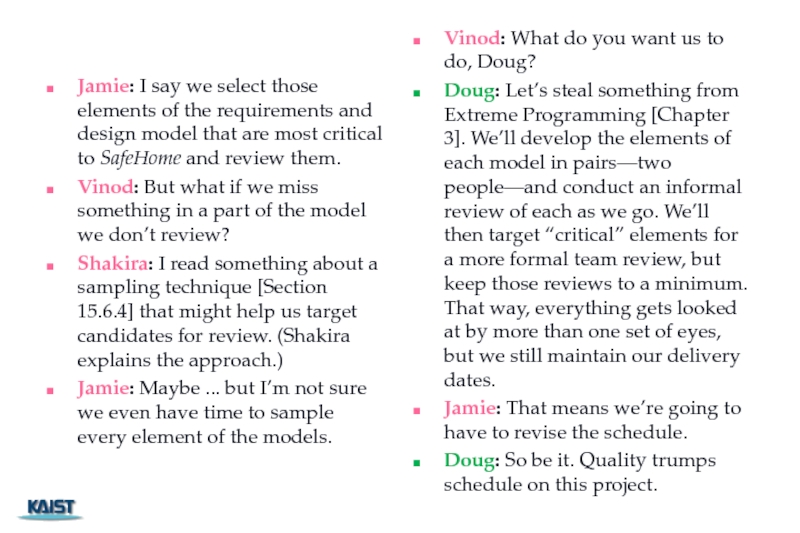
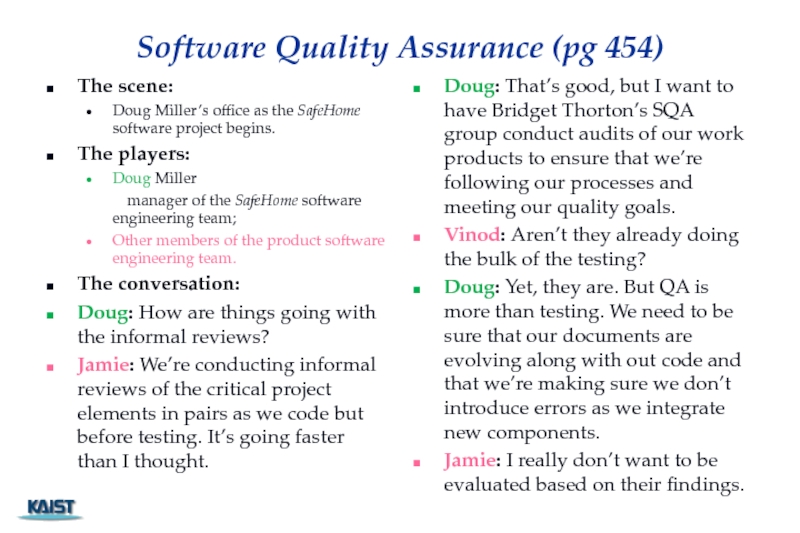
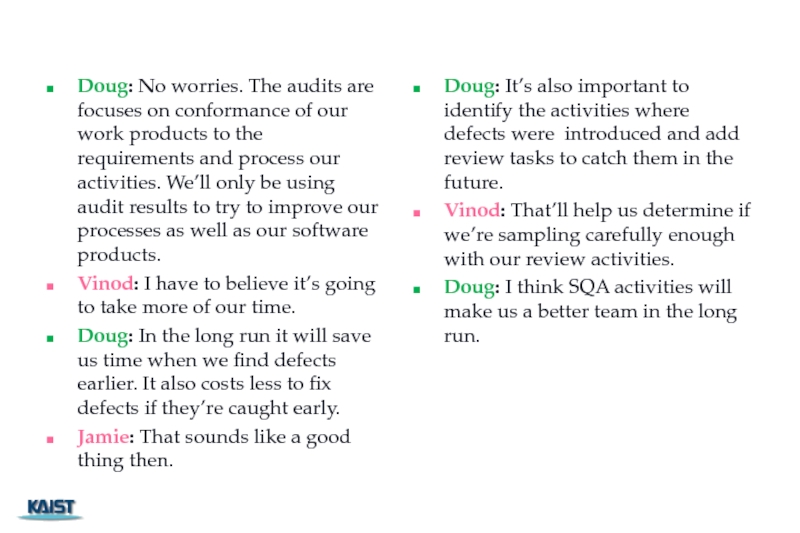
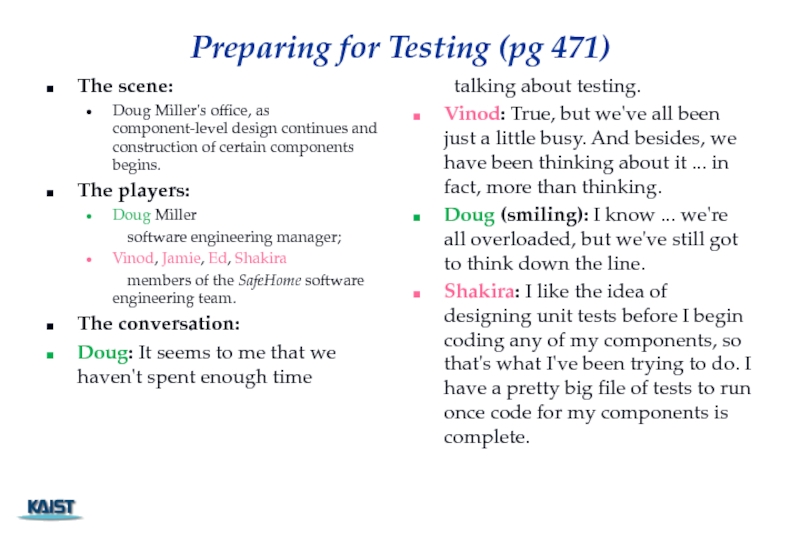
![Doug: That's an Extreme Programming [an agile software development process, see Chapter 4] concept, no?Ed:](/img/tmb/4/390515/0037ec26dad653c3659664949e0cefb8-800x.jpg)
